Dreadstar (1982) #1-26,
Dreadstar Annual (1983) #1
by Jim Starlin and others
Finally! After 3400 pages of Epic Illustrated, we’ve (that is, I) have finally arrived at the first thing published by Epic Comics!
Er, or, rather not, because first we’re doing Marvel Graphic Novel #3, Dreadstar. I mean, I kinda have to, because it bridges the story started in Epic Illustrated and The Price (over at Eclipse) and the Dreadstar series proper.
Again, it’s printed with black borders and gutters, and it’s fully painted. And there’s cat people. If I were to guess, Starlin has cats at home, because his cat people look just like as if he’d drawn human bodies and then painted actual cat heads on them, so he has to have had models handy.
Starlin plays around a lot with his rendering choices, and some are downright bizarre.
I think he sometimes loses his way, and people start looking really odd?
And then he switches back to doing outlines on people? It’s very confusing.
The storyline in this graphic novel isn’t very satisfactory. Spoilers: The majority of the pages is Dreadstar living a bucolic life on some planet, and then everybody’s killed but him, and then he takes revenge. But the last bit is rather kinda telegraphed in, so it doesn’t quite work. Which makes me wonder whether this was originally going to be serialised as a longer story (which would explain the pacing), but then he wrapped it up in a much shorter space than originally planned?
Finally! The moment is here! The first issue published by Epic Comics! Dreadstar #1! We get a pretty self-deprecating editorial by Jim Shooter…
… and then another editorial by Archie Goodwin. I guess the editor-in-chief felt the need to get the first word in.
I had the first couple of issues of Dreadstar as a teenager… I must have been fourteen? I stopped reading after a couple of issues, and I think I know what the problem for me was: The incessant recapping. I found the entire idea of a “Metamorphosis Odyssey” intriguing, but I was fine with not knowing what had actually happened. In fact, that just made the whole thing more interesting. A mysterious, unknowable pre-history. But then Starlin spends the first ten pages doing this really dull recap and I was out.
What I didn’t know back then (not having read the previous segments of the story) is that some of the bits were retcons: This cat guy, for instance, isn’t really mentioned in the graphic novel.
And I’m going to guess that stuff like this made me roll my teenage eyes: An empire stashing 10% of their cash in a satellite only manned by robots. Because that makes sense in any universe? I mean, I was an sf snob, and when things got too stupid I got going.
But I don’t really mind now. I guess I’ve mellowed. Instead I think that this is a pretty good action page, what with the dramatic silent red/yellow final panel there. Very effective.
I mean, it’s got good pacing. The people are as-you-know-bobbing all over the place, and I don’t even mind that. It feels like the start of a fun, solid action sci-fi series, and after reading the first issue I’m actually kinda excited at reading this series.
The second issue we get Willow’s “origin story”, and that also seems like an odd choice for how to open a series. I mean, you want to keep the story going, but instead you dedicate 30 pages to one of the characters… On the other hand, the story doesn’t make much different if your readers aren’t interested in the characters, I guess.
Yes, that means exactly what you guess it means.
But I don’t know… Was having any female character’s origin tied up in sexual abuse as much a cliche back in 1982 as it is now? It’s still such a popular choice, but perhaps it was edgy then?
Yes, exactly. I’m wondering how this will play out in the letters pages, and I’m kinda dreading reading the reactions.
The storyline is pretty grand (they have to save the galaxy from an evil empire or two), but there’s something pretty incongruous about five scrappy adventurers and the sheer scale of the thing. In this page, 15 million were killed, for instance.
Starlin isn’t really a formalist, but he does amusing stuff inside pretty standard comics tropes, like having this guy grow two extra arms when moving them around fast.
And this tableau fight scene is pretty striking.
Yeah, I was also wondering whether Dreadstar was going to devolve into adventure-of-the-week. It does give a satisfying chunk of story in each issue, but it does have a real forwards drive, plot-wise.
And then the letters about Willow’s origin story arrives, and they’re just as horrid as you’d fear. “As a matter of fact” is a way to say “I’m not at all”, isn’t it?
For the first few issues, Starlin had been inking himself, but then we get a few issues with different inkers. I guess the pressure of doing 30 pages every other issue was catching up with him.
But the inkers do a pretty decent job and the book remains as fun as ever.
And we also get a fumetti in every issue on the inside back cover. Starlin seems shy.
Oh, boy. The letters pages aren’t going to like this, either: Dreadstar’s main gambit into saving the galaxy is introducing a robot messiah. You somehow get the impression that Starlin perhaps isn’t very into organised religion?
Does it? Does it really?
Another sign of possible Starlin exhaustion is that for two issues we get a pretty funny Berni Wrightson backup feature.
Empirical galaxy!?
Anyway, I’m really enjoying reading this book by this point. It’s a fast-paced sci-fi adventure thing, and reading it you feel the enthusiasm the creators seem to have for it. For one thing, each issue is just packed; not one single page wasted. Every issue opens with a Goodwin cartoon editorial…
… then Dreadstar (either 30 pages or with a backup feature)..
… then two pages of letters…
… and then the fumetti…
… and then even a drawing on the back cover! I mean, no ads whatsoever! It feels like everybody involved is totally on it, and that enthusiasm is infectious.
Except the incessant recapping. I guess it wasn’t as annoying at the time, but reading these comics like this, I’m going “YES I KNOW”.
Whaddayouknow! Somebody didn’t like the machine messiah thing.
The other thing that’s less than successful about the book is that it’s just kinda… stupid? I mean, here’s a guy that escapes the destruction of the galaxy… by moving his ship… ten light years… outside… the galaxy. What does that even mean? This galaxy is 50K light years wide, so 10 is like…
OK, OK. But there’s a lot of these things here that just demonstrates that Starlin just isn’t very into sf, even while writing a sci-fi adventure book.
And, indeed, it turns out that Starlin has two cats. At least.
For two issues, the colouring turns interesting. Looks like they’ve gone to “laser scanned” colour seps instead of mechanical ones? There was a lot of experimentation with this stuff around this time, and mainstream comics fans absolutely hated it. “The colour doesn’t even reach the outlines; it’s so sloppy.” Looks pretty good, but a bit too muddy, perhaps?
At least one reader isn’t as enthusiastic as I am about how the package is put together. *gasp* Two pages in black and white! And humour! How dare they!
The origin stories keep coming, but this one took me by surprise. We get the story of The Grand Papal Genocidal Villain, and it turns out he had a really shitty childhood.
And he’s into metal?
Heh heh. “none of the backgrounds were completely filled in” I WAS CHEATED. But I do agree with him about the re-capping.
Starlin does an issue about different kinds of masculinities. It’s the funniest one yet, and I’m surprised at how funny some of these issues are. I mean, I LOL-ed out loud a few times in this issue, and that was definitely not what I was expecting after having read the previous chapters of the Metamorphosis Odyssey.
As we all know…
Did I mention that the bad guy is a really bad bad guy?
The gang puts on disguises to visit the doctor. Hm! Those outfits look kinda familiar, but I just can’t place them!
And there’s also a utility belt now.
Starlin’s having fun, and so am I.
But then something changes around issue 14. The plots in the first dozen issues has been fast-moving, grand and exciting. (Well, as these things go.) But the final… what… yeah, final dozen issues basically only have one plot point (finding a traitor in the group), and instead of moving across the galaxy and having new adventures in each issue, it’s all one, long drawn-out single thing.
We also start getting more in-house ads, and Starlin starts using an inker again. I mean, it’s still 30 story pages an issue, so it’s more than most comics, but it feels like some of the sparkle and inventiveness has gone out of the project.
And the recaps keep on coming. I know that I’m harping on this one seemingly trivial thing, but when we get yet another ten-page recap of a character’s story, repeating many of the same images we’ve seen before, I start skimming. And when you first start skimming, it’s easy to lose confidence in the narrative, and the impulse to start skimming the non-recap pages is there.
Heh heh. Blatantly bigoted anti-Catholicism.
Oh, yeah, around this time Marvel started reprinting the Dreadstar series as a newsstand comic. It only lasted six issues before being cancelled, and I’m not covering it in this blog series, I think…
While some of the sparkle has gone out of the book, there’s still some good scenes. For some reason or other, this really reminds me of a Roach scene in Cerebus. Something about the framing and the way especially the guy holds his body.
Even the characters in the book start getting fed up with the recaps. There’s like four pages of it in every issue! It’s insane!
As is… that…
Heh heh heh. That explains everything!
AAAAARGH WITH THE RECAPS
Jim Sherman does the artwork (including the colouring) for one issue, and it’s totally wild. Unfortunately, nothing really happens in this issue, either, like many of the issues in this stretch. Just a bunch of fight scenes that don’t really move the plot forward in any significant way. It’s like a totally different book from the first dozen issues.
And then the 26th issue ends with a whopping reveal… that I saw coming. Mostly because several letter writers also saw it coming, and speculated about this being the twist. And it was! But never mind; it was a really good twist, and for the first time in a long while, reading Dreadstar was fun again.
But:
Then there’s this little box that announces that Dreadstar is moving to a different company (which is First Comics). Fortunately when I bought the “dreadstar complete” set at ebay, I got those comics too, and I might as well just read them too? Yes yes, they aren’t Epic comics, and I’m not going to go into huge verbiageous verbiage… I think…
But why did Starlin leave Epic?
David Smay interviews Starlin in Amazing Heroes #98, page 30:
EPIC COMICS
Marvel’s first creator-owned Epic Comics title has now become the first to
defect to another company. Why? Bookkeeping.Amazing Heroes: W’hy is Dreadstar
moving from Epic to First?Jim Starlin: Because I can’t work
with Marvel any more. I’ve had
lot of trouble getting paid anywhere
near on time. Sometimes I’ve had to
wait as long as three to four months
on checks. I’m of the opinion at this
point, though people up at Marvel
deny it, that Nlarvel is less than
enthusiastic. about continuing crea-
tor-owned characters and wouldn•t
be sad to see them all go.AH: BOuld that mean the end of the
Epic line?Starlin: Well, they’re still hanging
in there. Despite the fact that Carl
Potts is also having trouble along
these same lines, he continues to do
Alien Legion. I understand Groo
does prett»vell up there. Other than
that, I really don’t know what the
fate of the Epic line is.AH: Did you have any problems
n•ith editorial interference?Starlin: No, I got along famously
with Jo Duffy and Archie [Good-
win]. I had no complaints there. In
fact, Archie is really the only per-
son up there who went out on a limb
at all trying to correct the situation
with my checks. He was a doll about
the whole thing, he and Jo both. But
they had no control over bookkeep-
ing, so nothing could be done about
it.All: [noking back owr the Epic run
of Dreadstar, what would you say
)€ere your ‘nost successful issues?Starlin: I’m not happy with a
number of the later issues—from
about #15 to #20. I was going crazy
dealing with the business part of it,
trying to get paid; I wasn’t really
happy with a lot of the stuff during
that period. I’m happier with some
of the earlier issues, particularly the
first five or six. I’m getting more in-
to it again now. Despite all the
warnings—everybody said I’d have
trouble getting paid at First—I’ve
had no trouble. I get a check from
them every week, which works out
just fine. They’ve never been late
once and I’ve been having fun with
the book again. Which I wasn’t quite
sure I’d be able to do again.
Wow. Marvel didn’t pay him on time? Was Marvel going through yet another “troubled” period at the time? This is 85-86, which saw a significant downturn in the direct market, I think?
I wasn’t imagining Starlin losing enthusiasm around when I thought he was, then, but his problem was with Marvel and not with Dreadstar…
But while I’m doing research, we could have a look at what the reviewers were saying about the Epic incarnation of Dreadstar.
Keith McConnell writes in Amazing Heroes #23, page 60:
Now for some comments
concerning the other aspects of
Dreadstar #1. While Starlin’s
graphics could stand some addi-
tional detail, this conventional
rendering technique is far
superior to his “Metamorphosis
Odyssey” work, which in the
words of Oscar Wilde was “that
curious mixture of bad painting
and good intentions.”Zing!
All in all, I am left with the
uneasy feeling that Jim is milk-
ing a minimal concept for more
than its worth, and exploiting his
readers in the process. Comic
book stories don’t have to be this
long to be good, and I think
Starlin’s writing would benefit
from a more direct and absolute
approach.Ted White writes in The Comics Journal #78, page 54
If that does not strike you as much of a
story for a $4.95 “graphic novel” of 46
pages, you’re right. The entire story was
retold in the first ten pages of Dreadstar ,
one of the new series of Epic Comics pub-
lished by Marvel foi direct sales (no
Comics Code Authority Seal).
What Jim Starlin has done with •these 46
pages makes me wonder whether I should
be bothering to dignify it with a review. I
mean, on one hand this whole “Metamor-
phosis Odyssey” shtick—of which this
volume is only one (incomplete) episode—
is simply a self-indulgent piece of pseudo-
artistic masturbation by someone who has
yet to outgrow either his adolescent tastes
or his adolescent potions ofpolitics. But on
the other hand it seems to be popular and
have ifs devoted followers. Is there any
polnt, then, in treating it to any kind of a
critical review? seriously doubt that
anything I write here will sway Starlin from
his happy ways—the Epic Comics volumes
will follow in due course, despite anything I
might say on the subject—and his devoted
readers are unlikely to care about my
criticisms either. So who am I addressing
here? People who, like me, are not over-
whelmed by Starlih’s work änd probably
wouldn’t spend five bucks for Dreadstar
anyway? Is this review then any less a
masturbatory act on my part?Well, hopefully Comics Journal paid you for the review, Ted.
Heidi MacDonald writes in The Comics Journal #79, page 55:
Just how bad is Dreadstar by Jim
Starlin, the inaugural issue of the new Epic
Comics line? It’s pretty bad.
Once again, production values far out-
strip the content’s worth. As I said, it’s
often easy to be too harsh on first issues,
before concepts and characters have jelled,
but this hardly counts as new series.
Starlin has already given us a long serial
that ran in Epic ‘1-9, two previous graphic
novels, and a long prologue to the present
Story in Epic that are all part Of the
same Story. I think it fairly safe to draw
some conclusions on where Starlin is going
at this point.
As far as I can determine, Starlin has
spent hundreds of pages (with hundreds
yet to come) to illuminate one theme: War
Is Not Nice.
Careful reading between the lines un-
covers two subsidiary themes: Monarchic
Dictatorship Is Not a Good Form Of
Government, and Theocratic Rule by
Religious Fanaticism Is Bad.
I don’t quite know how to tell Jim this,
but these are-not exactly the newest themes
in the world. I would certainly agree that
they are worthy themes, and they could
certainly provide the solid backbone for a
Story, or even an epic. But a story needs
more than just a backbone. It needs flesh
and blood. It needs a spirit.[…]
I’ll grant you, world-making isn’t the
easiest thing in the world. But such things
don’t have to be spelled out. A great deal of
things can be simply tossed out in passing.
(Which doesn’t mean the author shouldn’t
figure things out thoroughly.) A first issue
can hardly be expected to cover every-
thing, although Dreadstar does contain
a looooong synopsis of previous install-
ments. But in hundreds of pages of material
Starlin has given us only the most super-
ficial and hackneyed attempts at present-
ing an interesting backdroö for his epic.[…]
I cannot believe that we will never escape
from the superhero quagmire. I cannot
believe that there are not people who do
have ideas. Who know how to draw human
beings and who know how to write about
human beings. The initial phase of
American comics’ coming-of-age is painful,
but no birth is without pain.
Someday, someday. Santa’s gonna come,
just you wait. Santa’s gonna come.That’s an inspiring review.
“TH” (Thomas Heintjes?) writes in The Comics Journal #97, page 11
Outrage: Jim Friel. the manager
of Bud Plant Distributors’ #2
warehouse, laid Out his thoughts
on the series in his tip sheet for
retailers, which serves as a guide
to purchasing each month’s
comics. In the tip sheet
containing Co.,
Friel wrote:
“Dreadstar& Co.,
Here’s an icepick for your back.
After assuring us last year that
the Great Reprint Dump hap-
pened only because Marvel
needed to generate some
emergency cash now, they now
do this. Since they have had it
explained to them repeatedly
why it is that reprinting recent
THE COMICS JOURNAL #97, April 1985
material without warning
retailers and wholesalers before
the first appearance of that
material is a contemptible,
unethical, and stupid thing to
do, I personally can only
conclude that whoever suggested
this project and whoe’.’er
authorized it are people who
have quhose qualities. Did I say
‘vicious’? NO? OK—add
‘vicious,’ too. Anyone Who has
stockpiled back issues of
Dreadsrar will suffer when this
book begins publication.
Anyone who inadvertently
ordered too many copies of
back issue(s) will, too.
“Does Marvel care? Evidently
not.
“What a sleazy outfit!That was about the Dreadstar & Co reprint series, which was not well-received at the time…
Oh, here’s a fun item:
When reprinting The Price, Marvel covered up a cat/man penis? Dude.
Oh, I’ve got the “Annual” that reprints The Price here, so let’s have a look.
Ah, it was originally black and white, but it’s been coloured by Graziunas, and it looks really good for something like that. Better than the original, I’d say, which is unheard of.
Except that certain bits are missing, as Groth mentioned in The Comics Journal. Tsk, Marvel. Tsk.
Anyway, I did read the entire First Comics run, too. I mean, the first First issue has the conclusion to a plot point that had been running for over a dozen issue.
The First editor makes light of the numbering. But renumbering and starting comics series over with a new #1 wasn’t quite the done thing back then, was it? Of course, these days they’ll start over with a new number one whenever they get the chance, because a #1 always has higher sales numbers than anything that follows.
So what do we get in the first First issue? Yes, you guessed it, a recap of everything that’s gone before. But this time framed as the conclusion to a mystery novel, so you have all the suspects gathered in one room and the sleuth is telling them how he found out who the culprit is.
The printing and the colouring over at Epic had always been very good, but the paper grade declines and the colouring is very muddy. Perhaps it’d have worked better if it had been on whiter paper?
We also get house ads interspersed at random, and that’s just… eh.
Starlin really milks the mystery for all it’s worth, and it kinda works?
Heh heh. More people complain about the recapping, and the editor seems to promise that they’ll stop doing that shit from now on.
And indeed they do (I mean, lose the four pages of recapping per issue), and in addition the colouring gets a while lot better.
The editor explains the $1.75 price.
So the recaps stop… but what does Starlin do? Yes, he tells the entire climax of the major overarching storyline… as if it were a recap! Perhaps he just really, really likes that storytelling mode?
I really, really don’t.
Of course, then we get a full issue that retells the entire storyline up till now.
*sigh* By this point I was ready to ditch the series and just call it a day. I mean, I haven’t committed to reading the complete First comics, have I?
The cat guy started off with a pretty cat-like head, but now he’s more like… a mountain lion? But with a snout? Starlin stopped doing the artwork, and the new guy didn’t have any cats around the house is my guest.
Ooo edgy!
And there’s even a crossover. I was totally ready to ditch the book now. But!
Then Starlin announces that he’s leaving the book completely, and Peter David is taking over the writing. So I figured I might as well continue reading a couple of issues to see what happens.
And what happens is that David ramps up the comedy. Like a lot. Which I like.
Starlin isn’t completely gone from the book. We get a novel serialised in the back; about six to eight pages per issue.
Heh heh. That’s a good sound effect.
Oh, have we reached the 90s yet? A foil-embossed cover and Dreadstar has gotten a hair metal do.
The main artists on the book are pretty good, but they rotate in and out apparently with no rhyme or reason, and the fill-in artists (seen above) are way off model.
David doesn’t drop the galaxy-wide drama and wars, but it’s clear that he’s more into doing parodies and funny stuff. And sometimes the funny stuff is good, but the drama doesn’t really work.
Starlin’s Dreadstar was very anti religion, but David isn’t? The gods were previously shown to just be some powerful, but petty energy aliens, but David retcons them into being, well, gods. Perhaps he’s religious or something?
So in issue 62 we get an entire issue… that… retells the story up until now. NOT AGAAAAAIIIINN, as he says, but this time it’s told as a goof (from a very slanted viewpoint). Still, it’s a bit odd, especially considering that the series is cancelled a couple of issues from now. But I guess they didn’t know that at the time.
So we get two issues of media satire, this time aimed at Star Trek. But that’s the best Hephestian Nerve Crunch I’ve seen.
And then it’s over, and we’re told that Dreadstar will return in a series of “prestige” format comics.
Instead First Comics closed up shop soon after. I seem to recall that this had something to do with the cost v. reward for the Classics Illustrated series they had started at the time?
Malibu Comics published a six issue mini series in the 90s, and that’s the last we’ve seen of him.
Slave Labor Graphics and Dynamite have both started reprint projects of Dreadstar, but neither got very far, so most of this hasn’t been reprinted.
So here’s my summary on the sitch: The first dozen or so issues are surprisingly well made and quite entertaining. Then it’s a slog until Peter David takes over around issue 40, but the run is dragged down by inconsistent artwork. So I don’t think it’s that surprising that it hasn’t been collected.
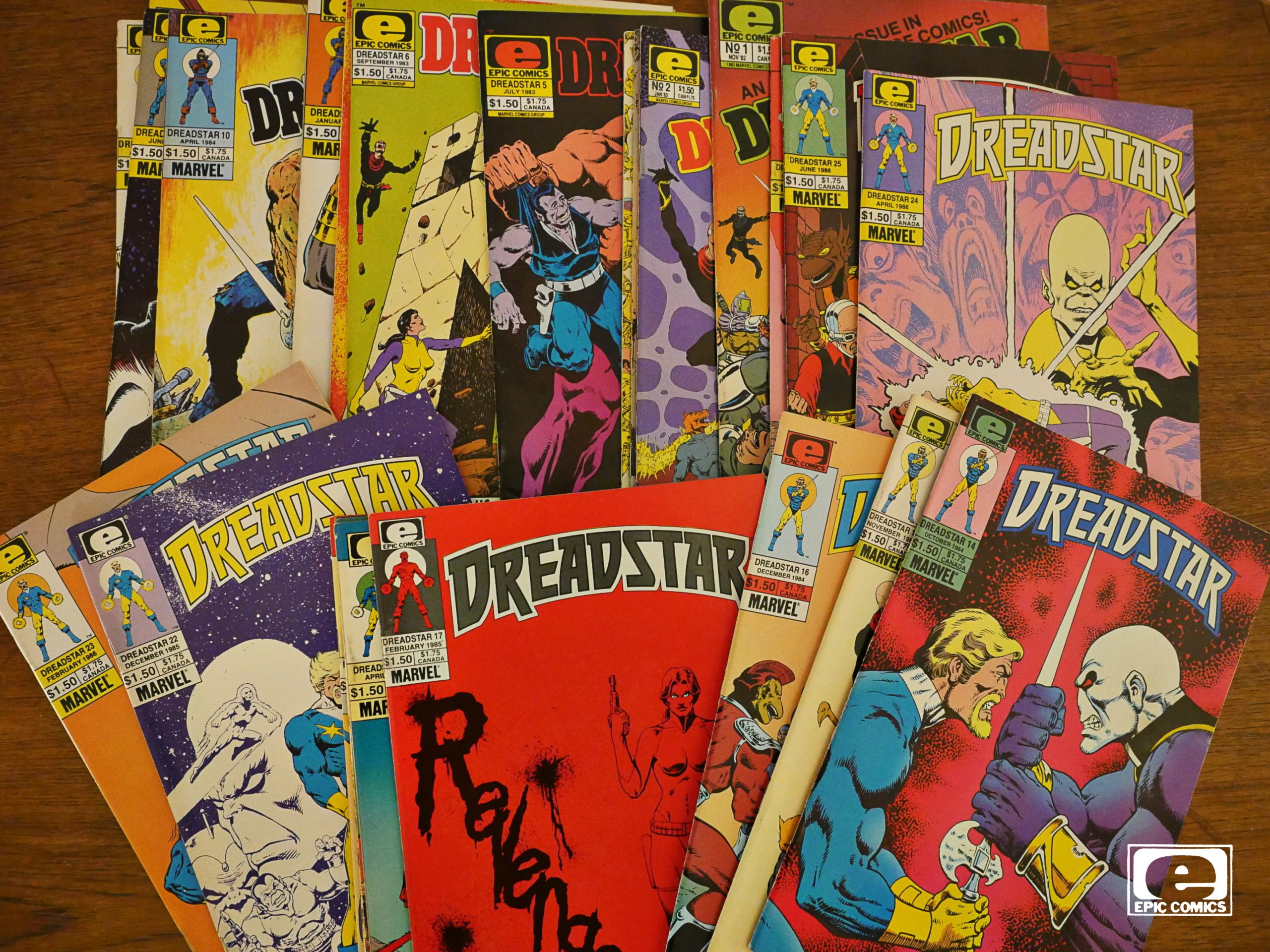
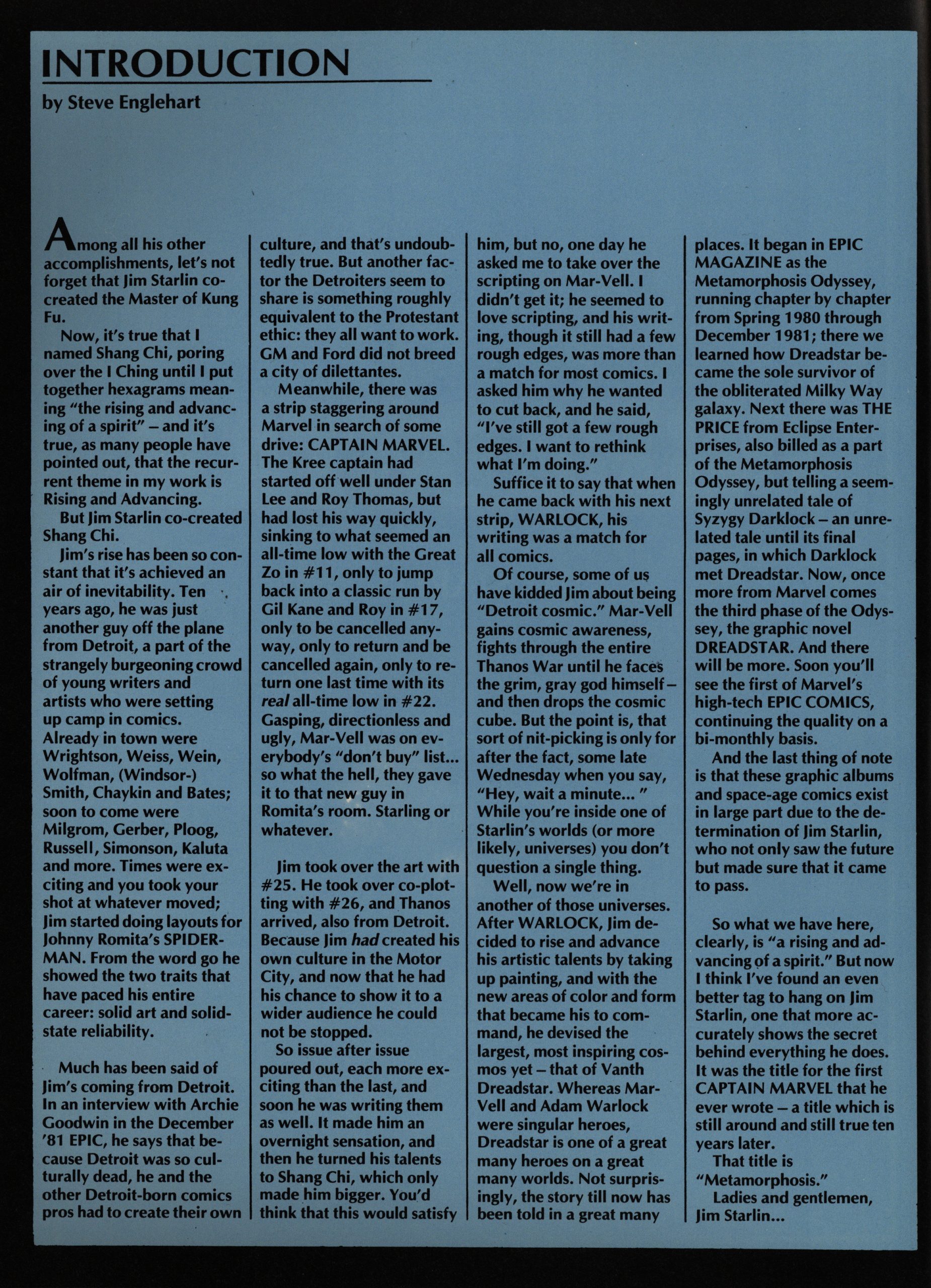
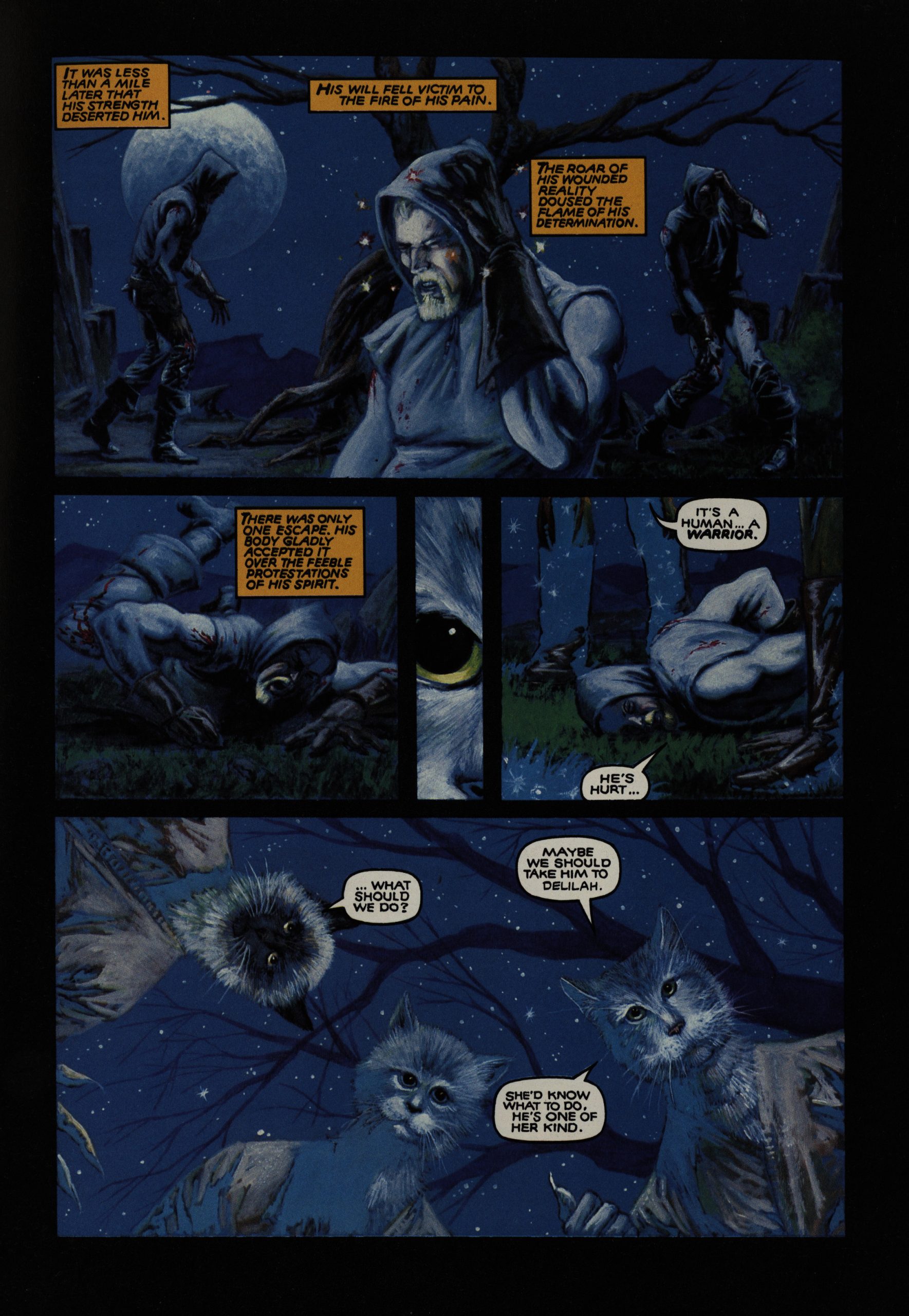
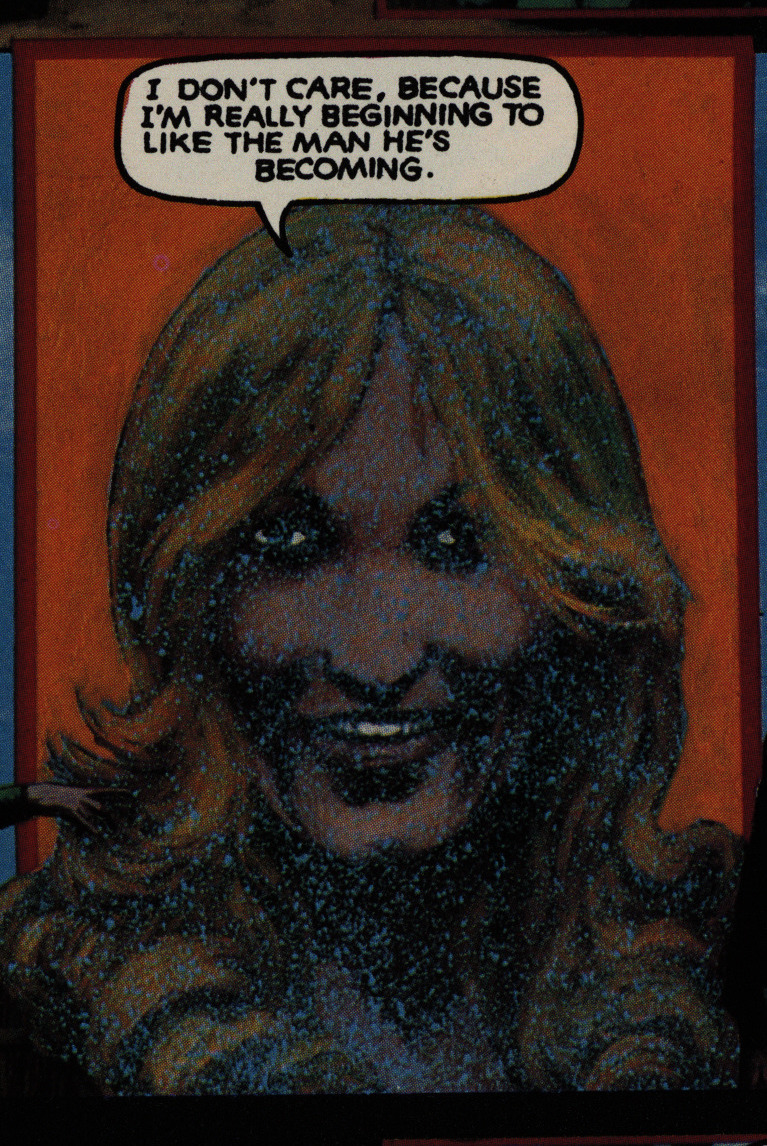
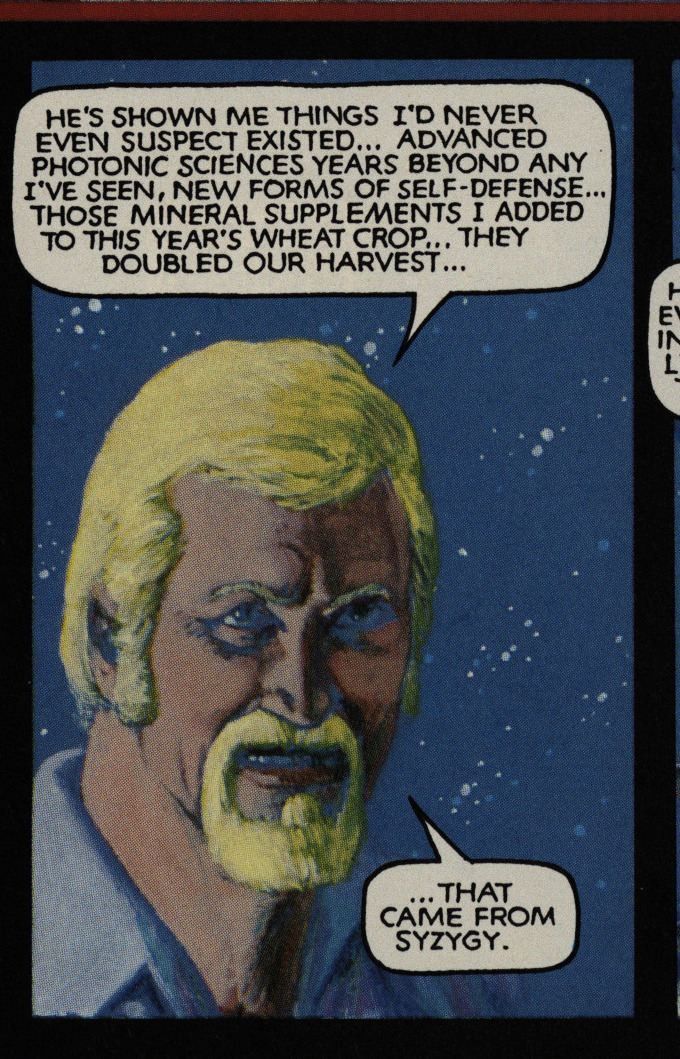
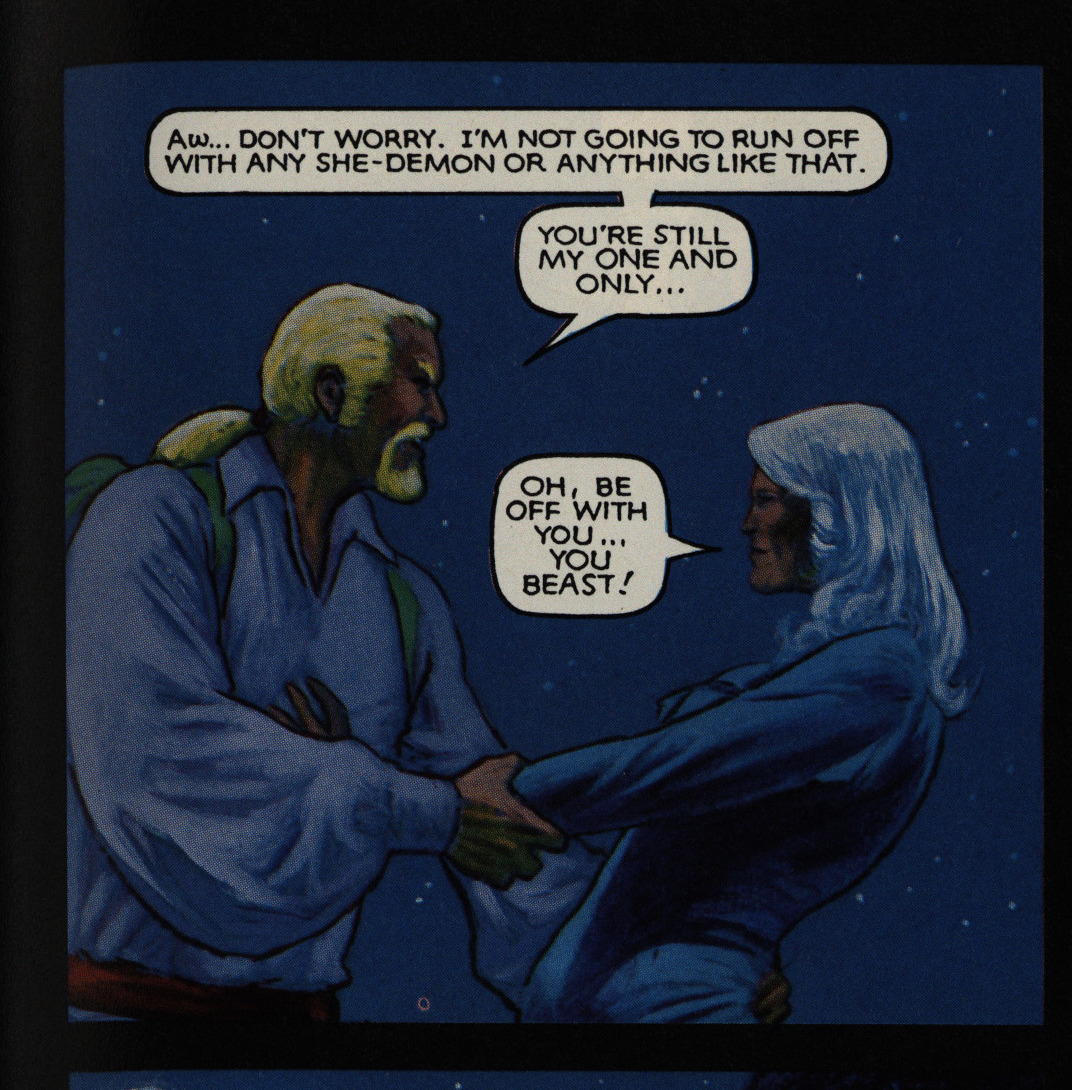
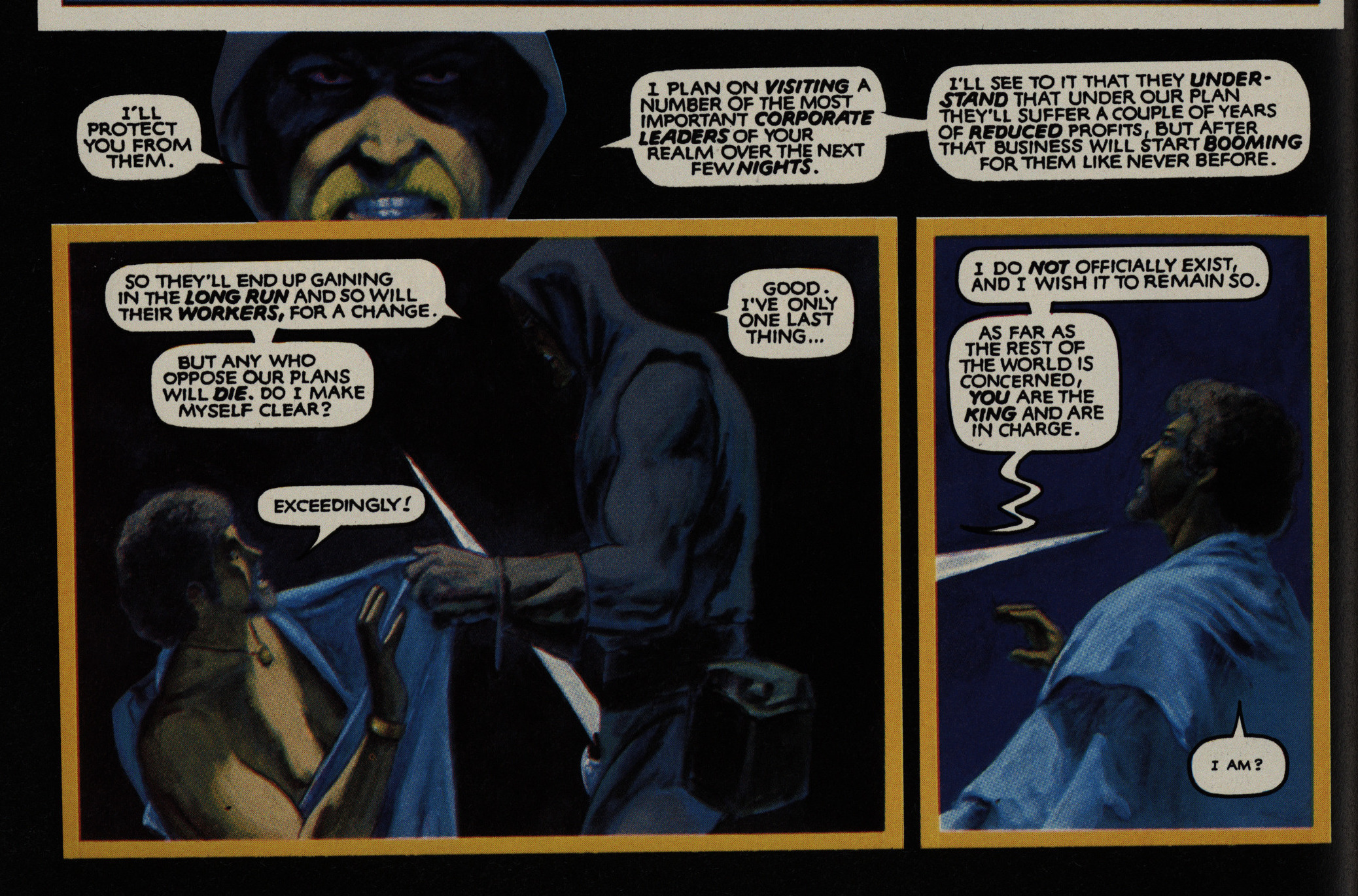
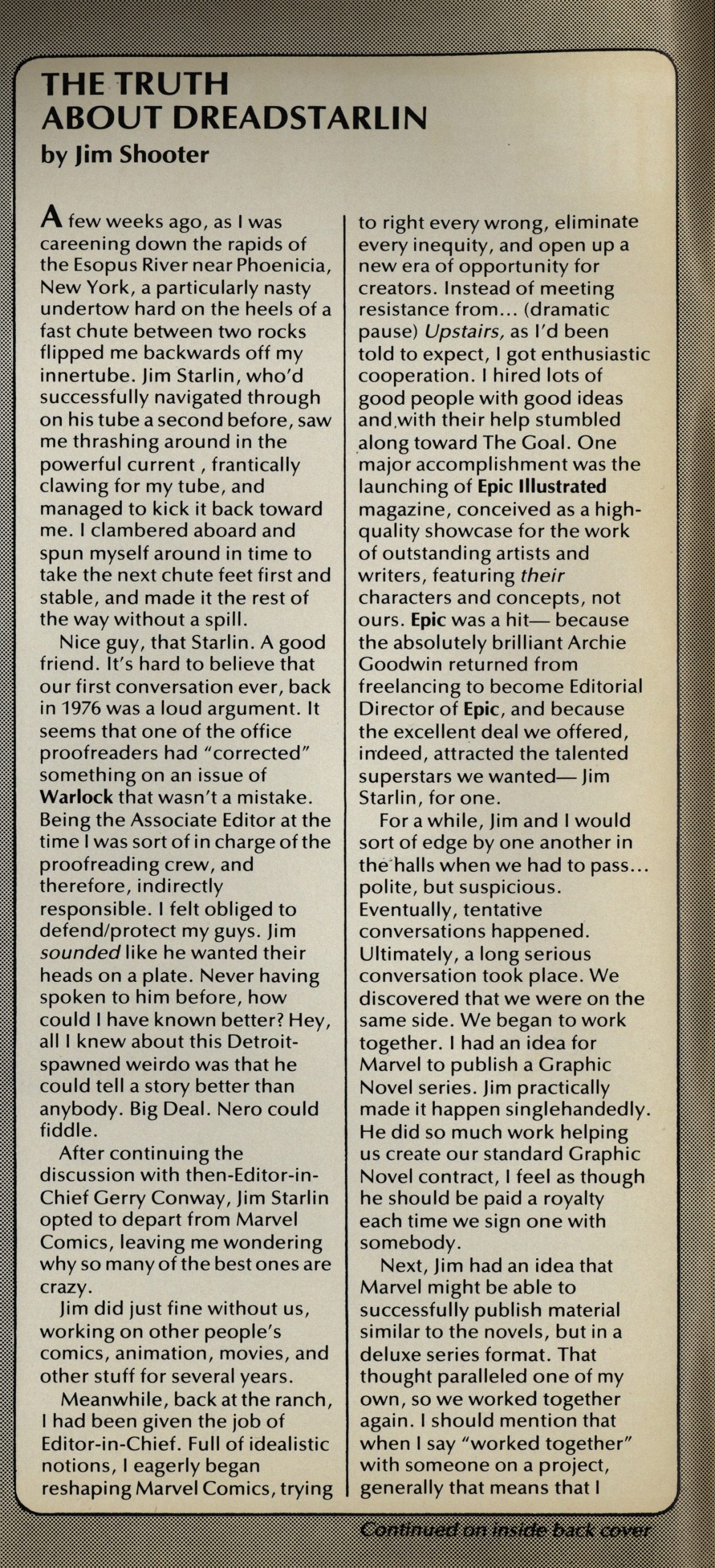
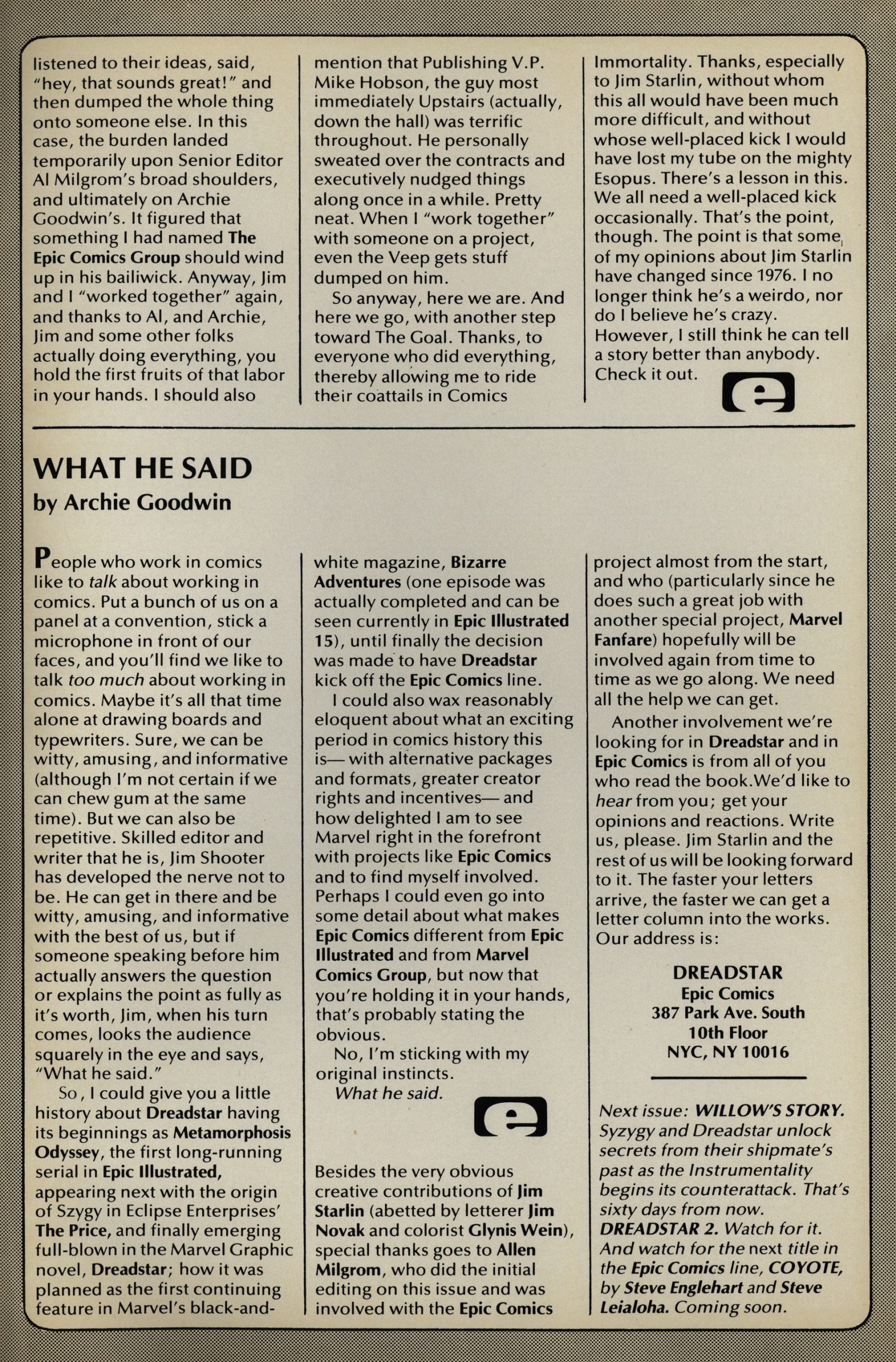
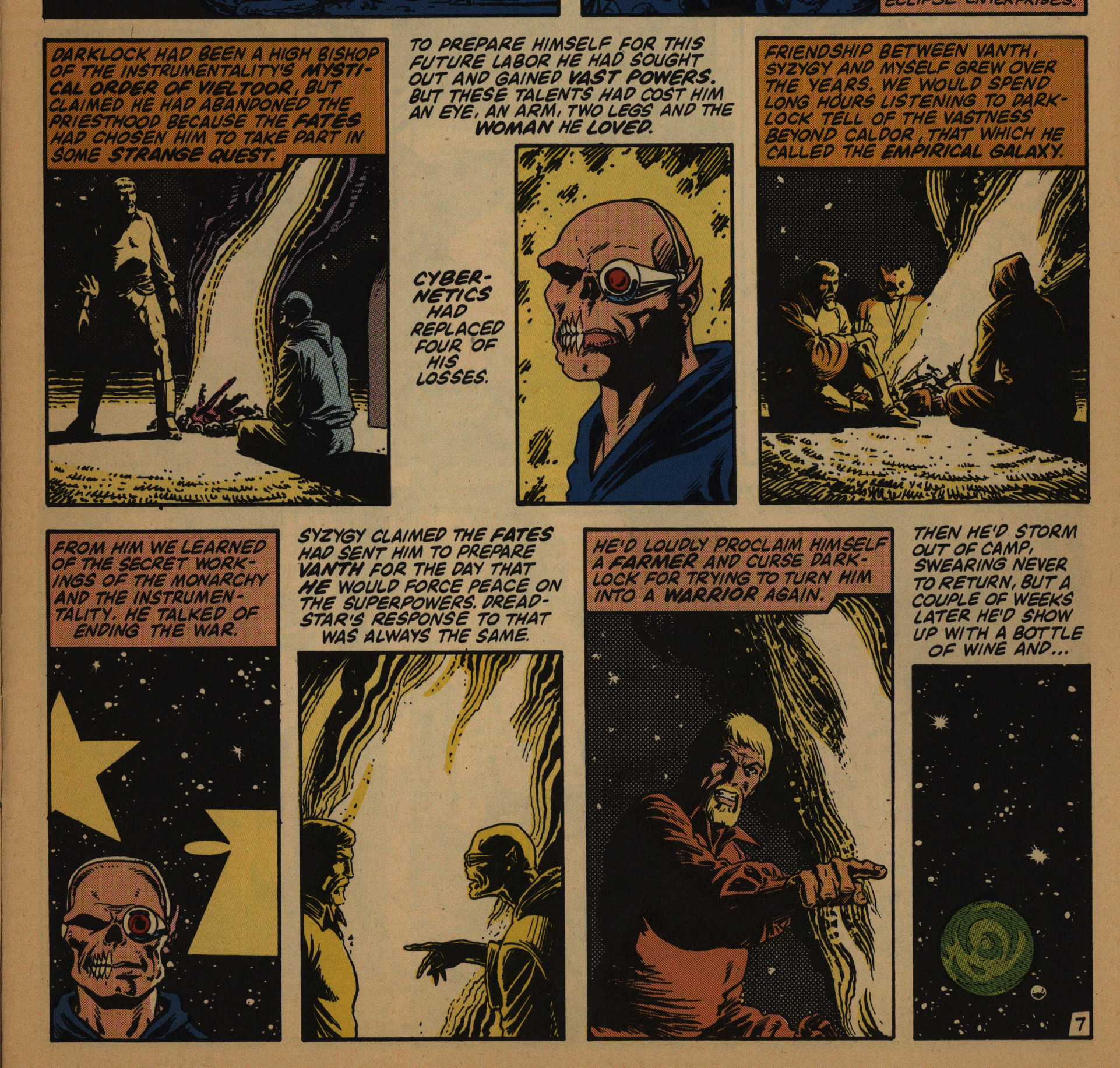
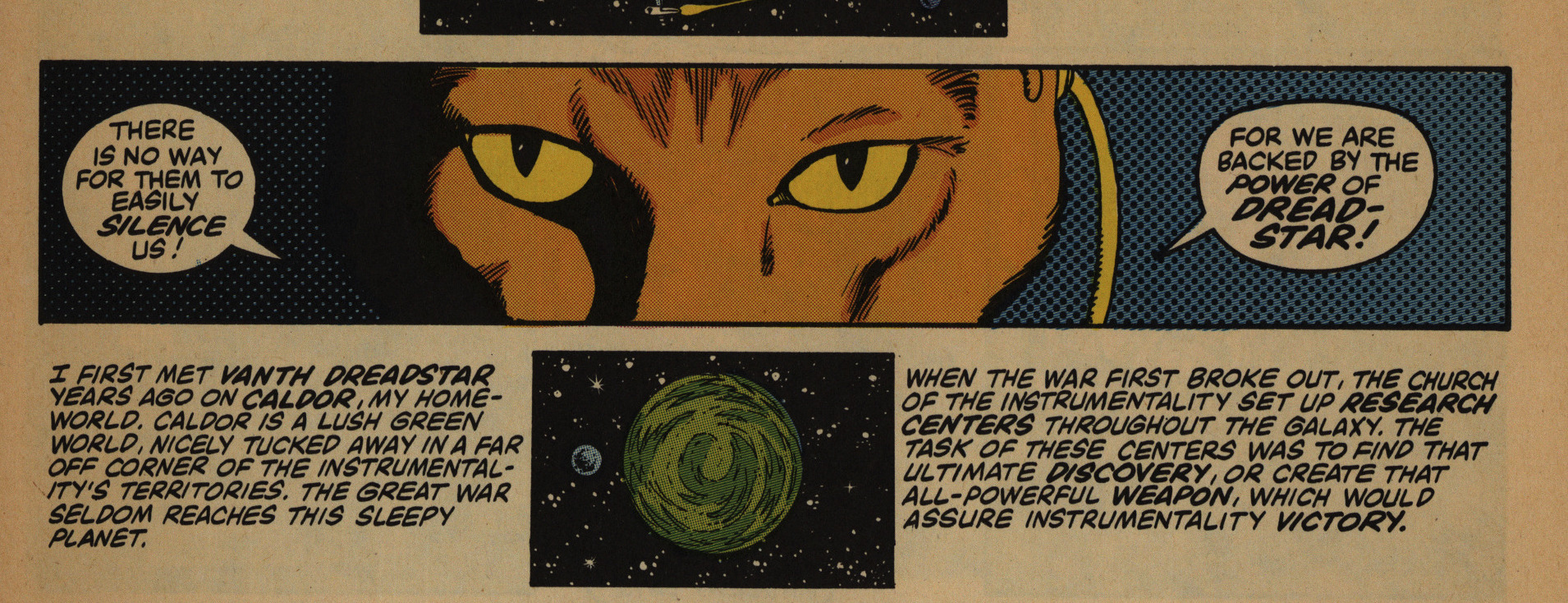
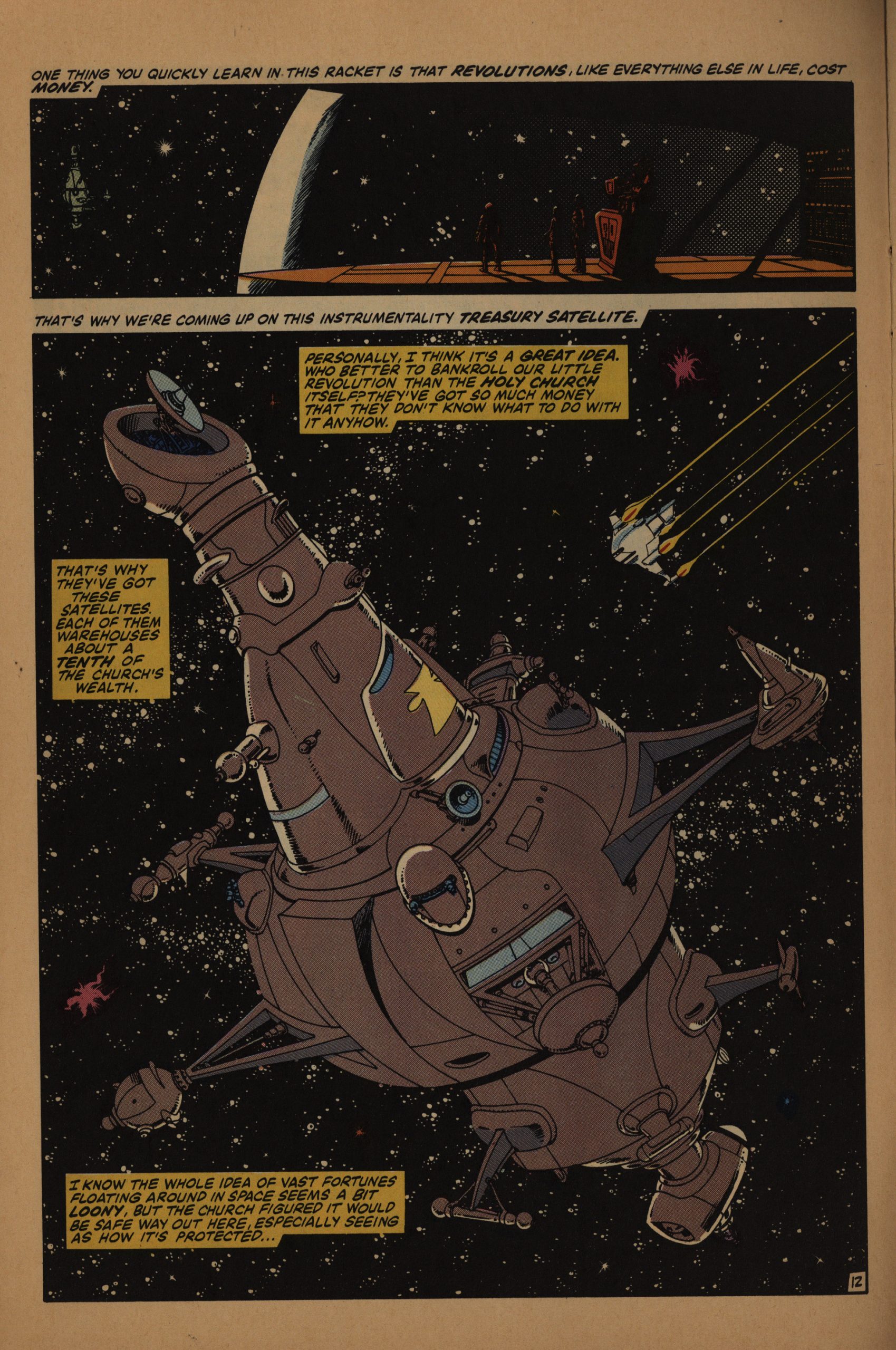
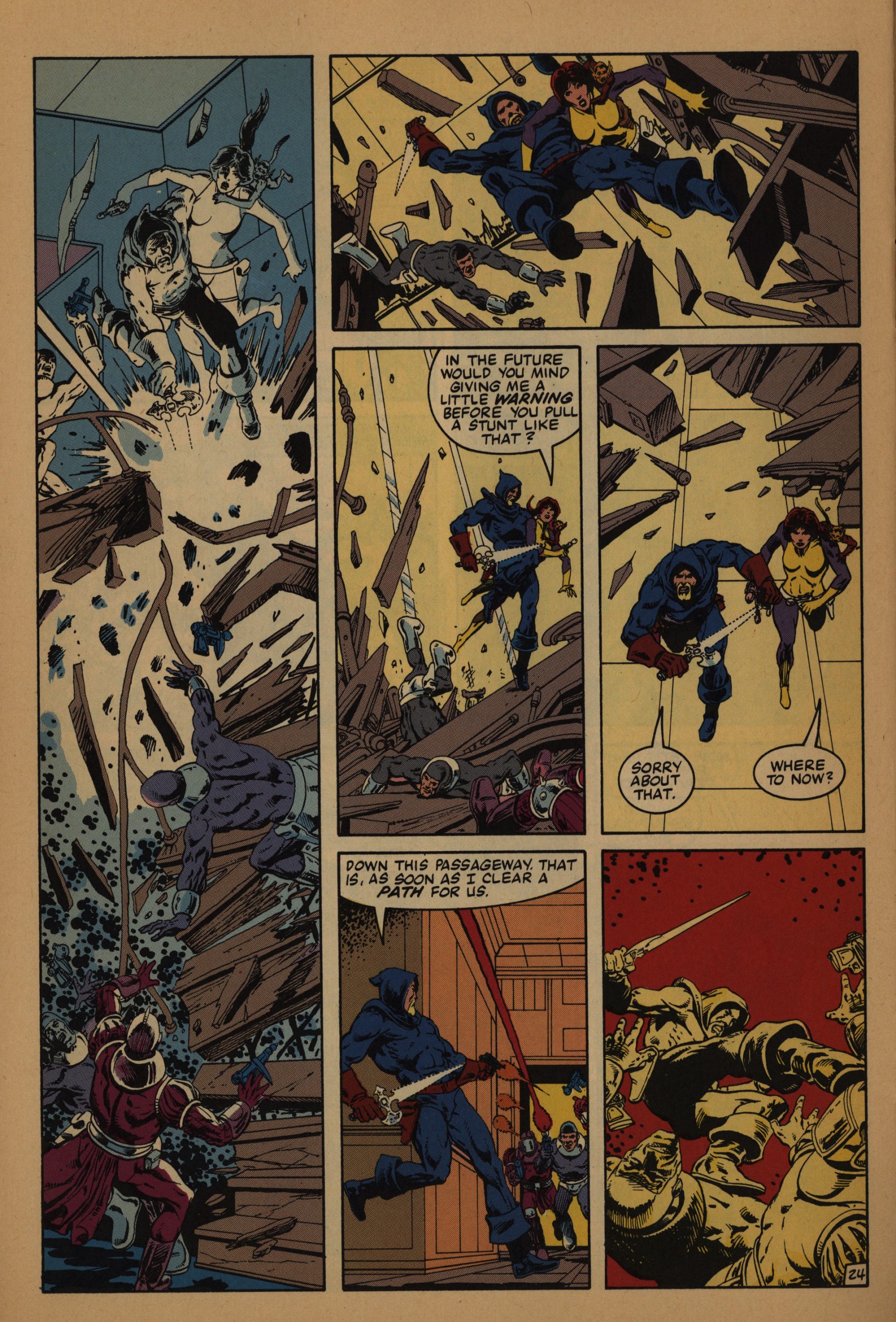
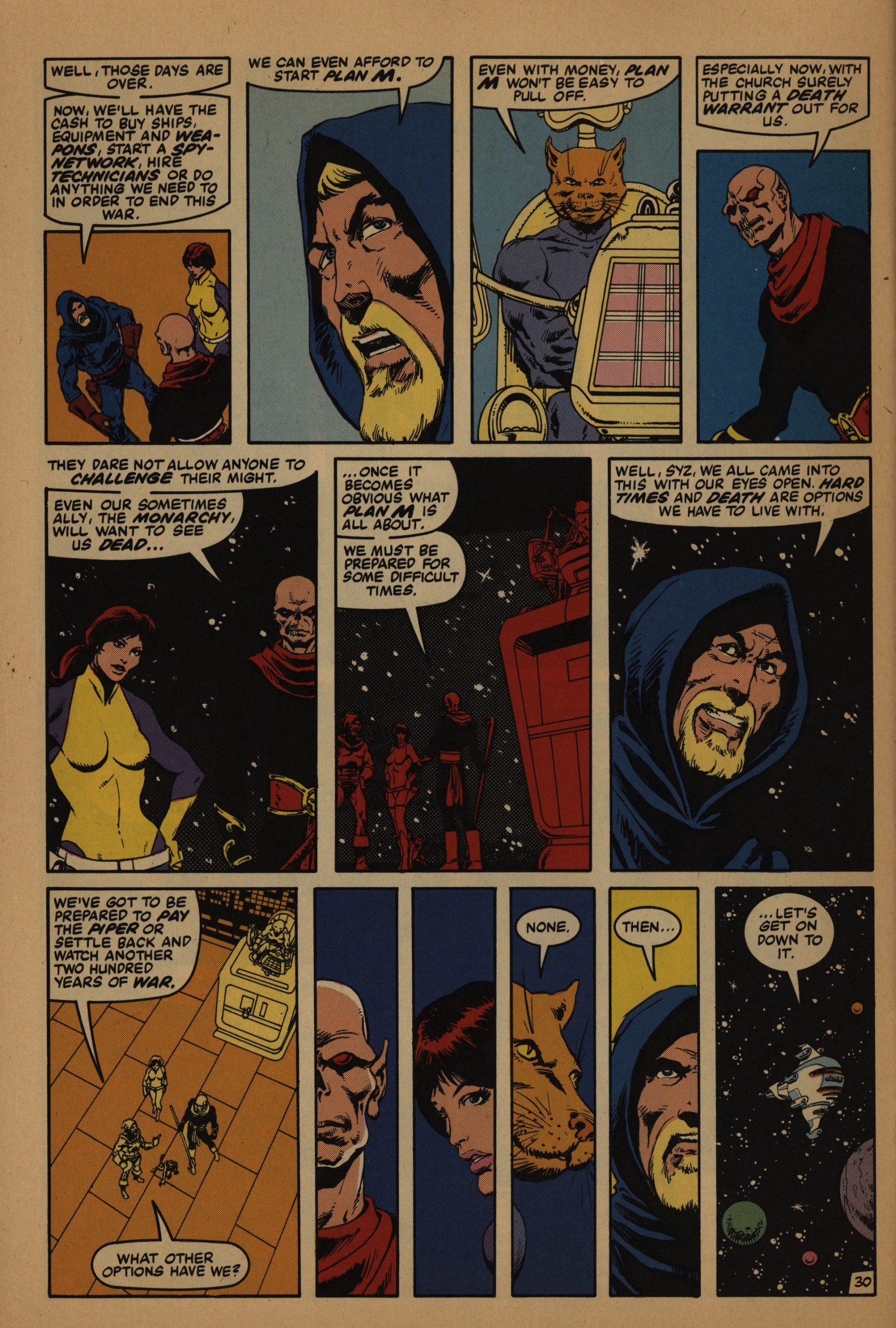
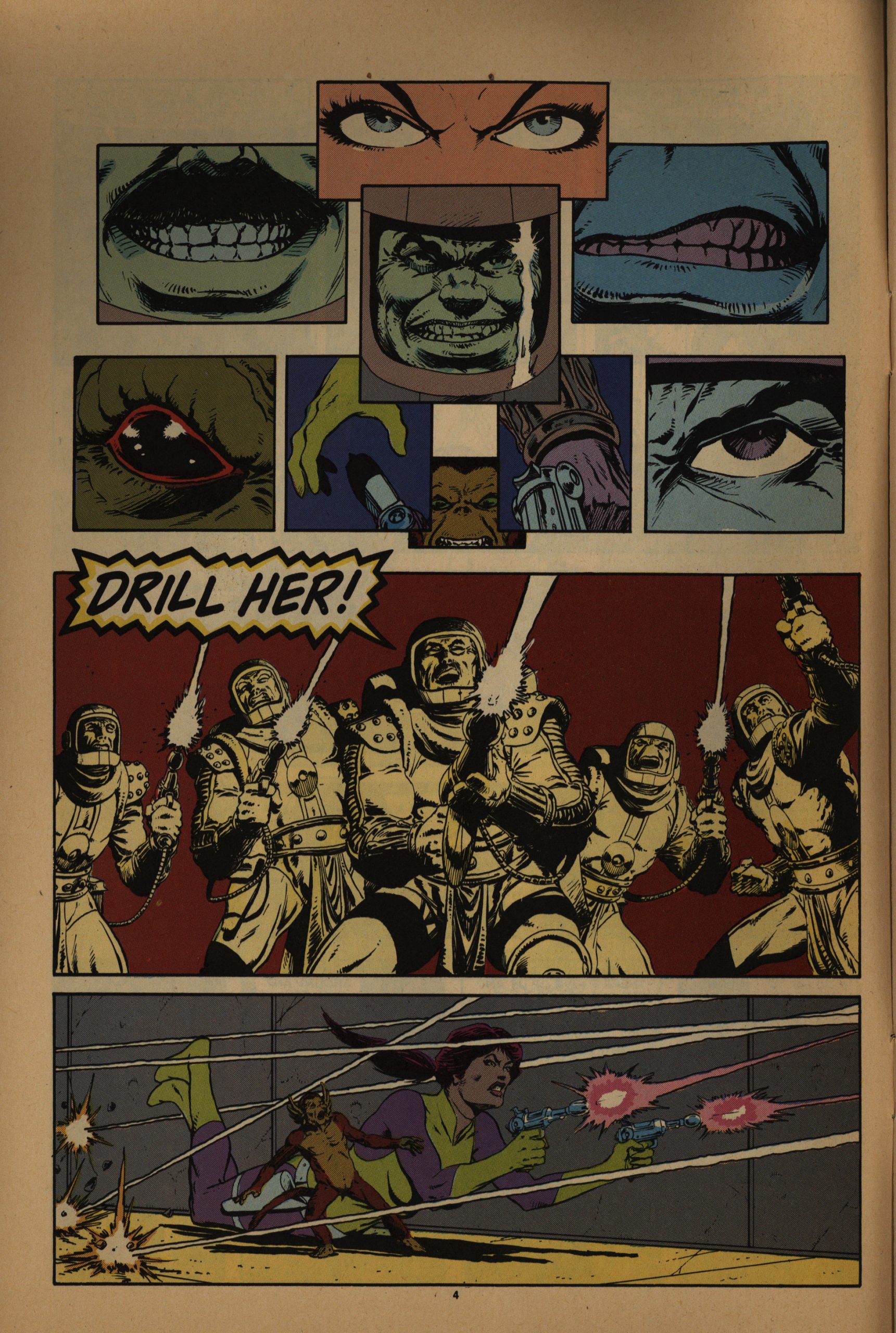
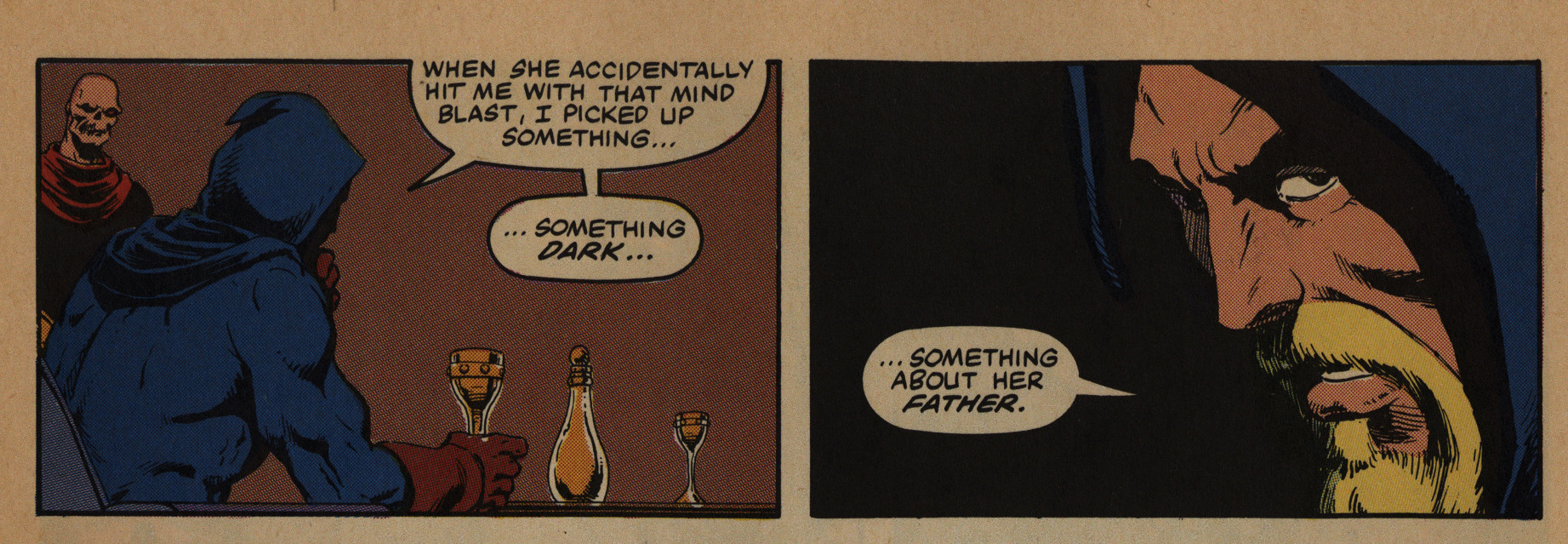

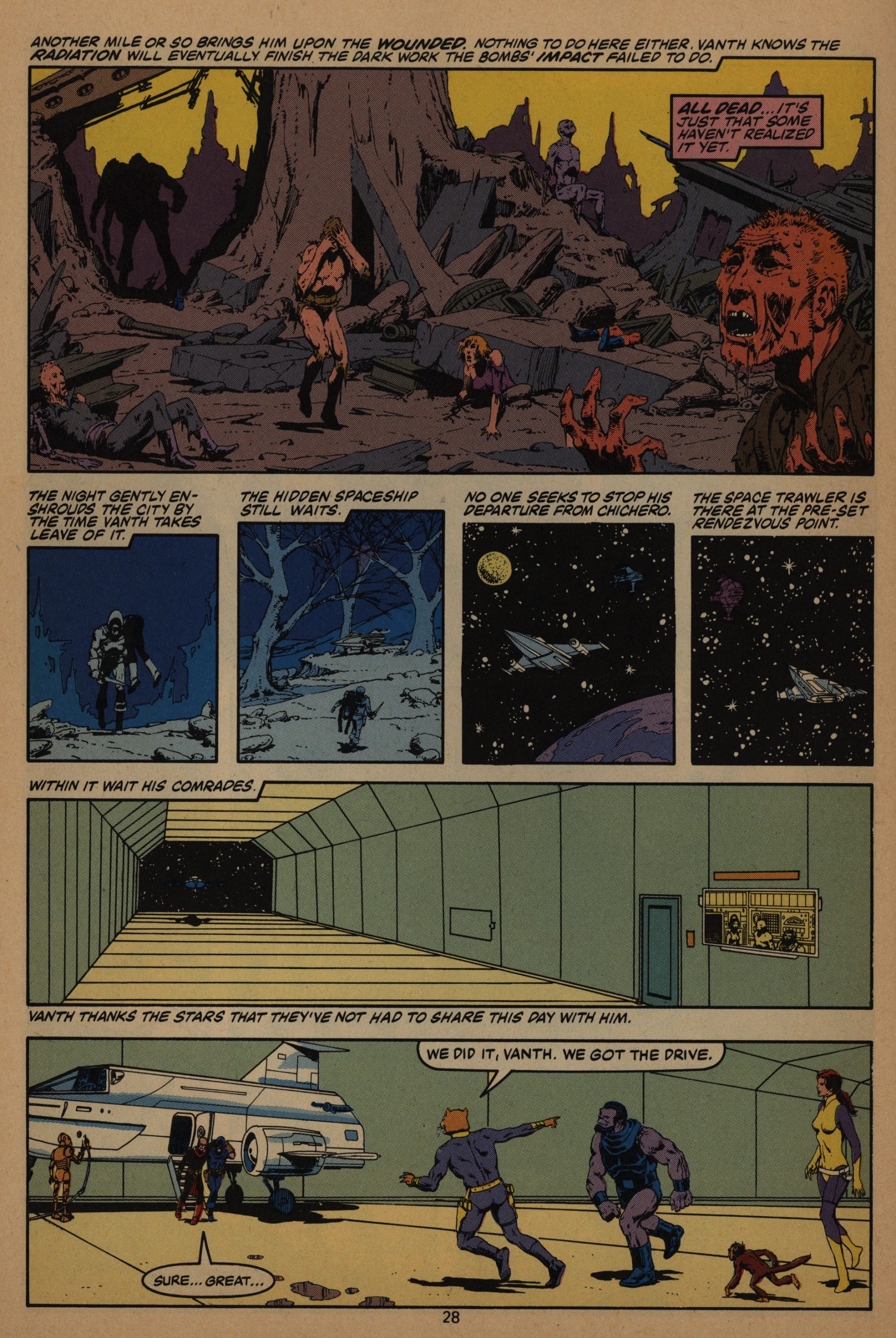
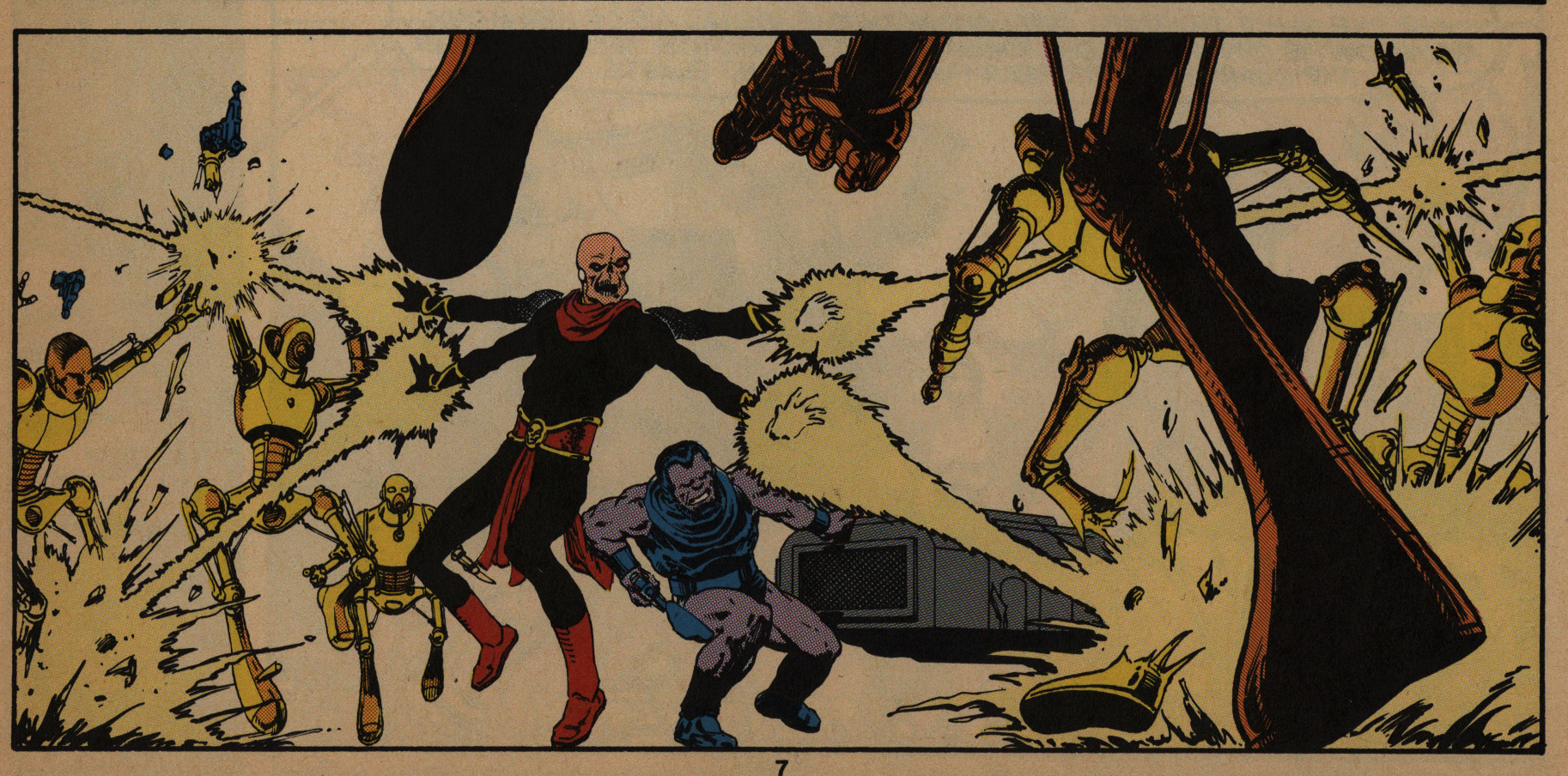
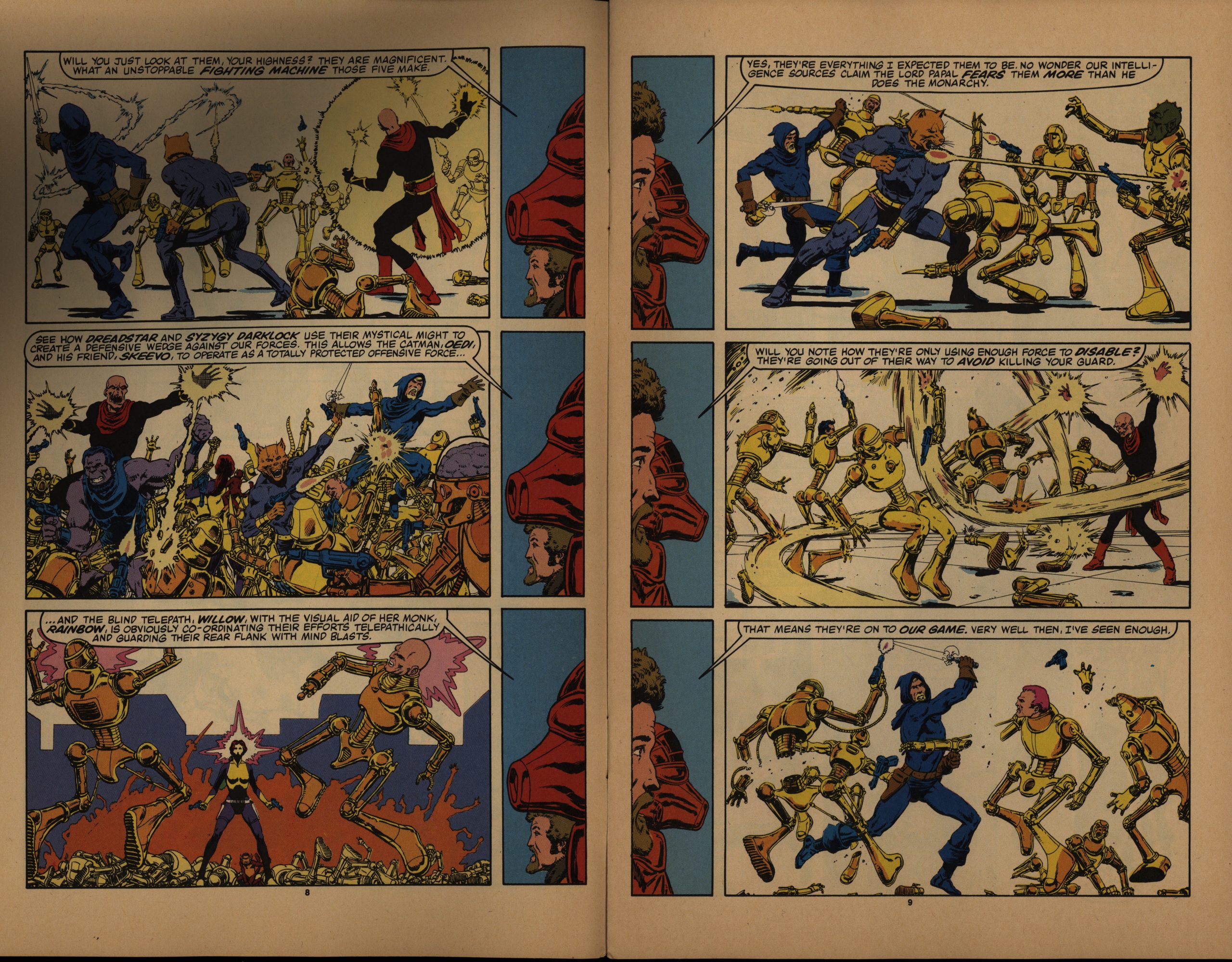
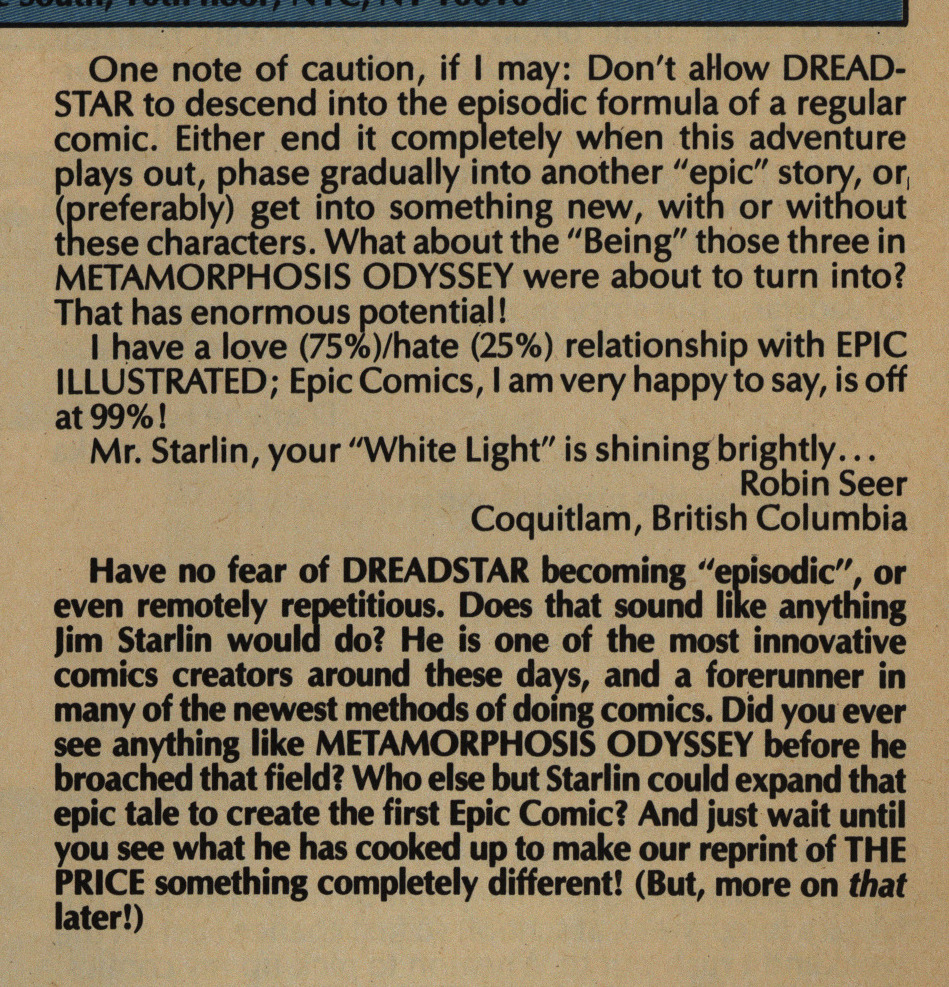
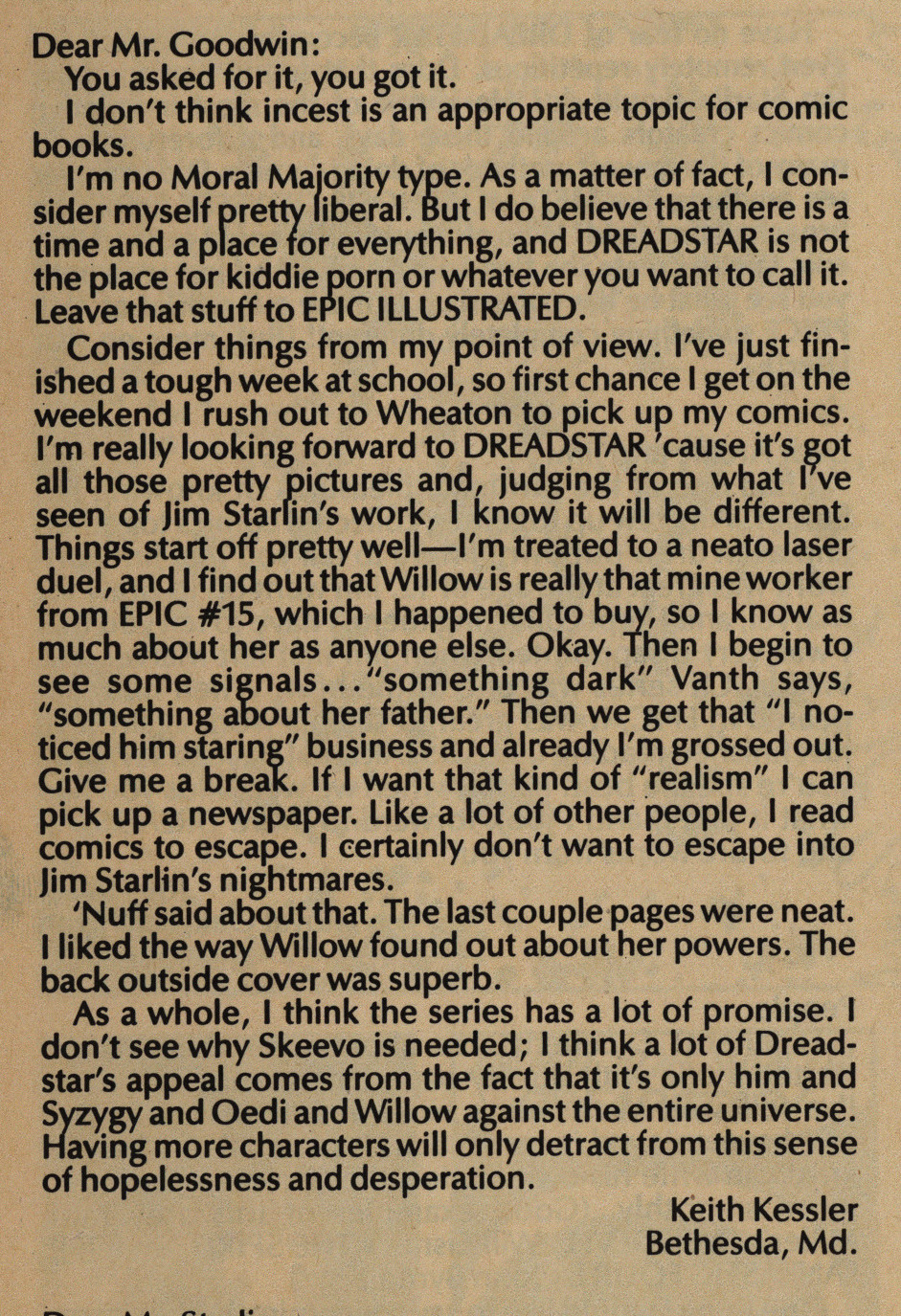
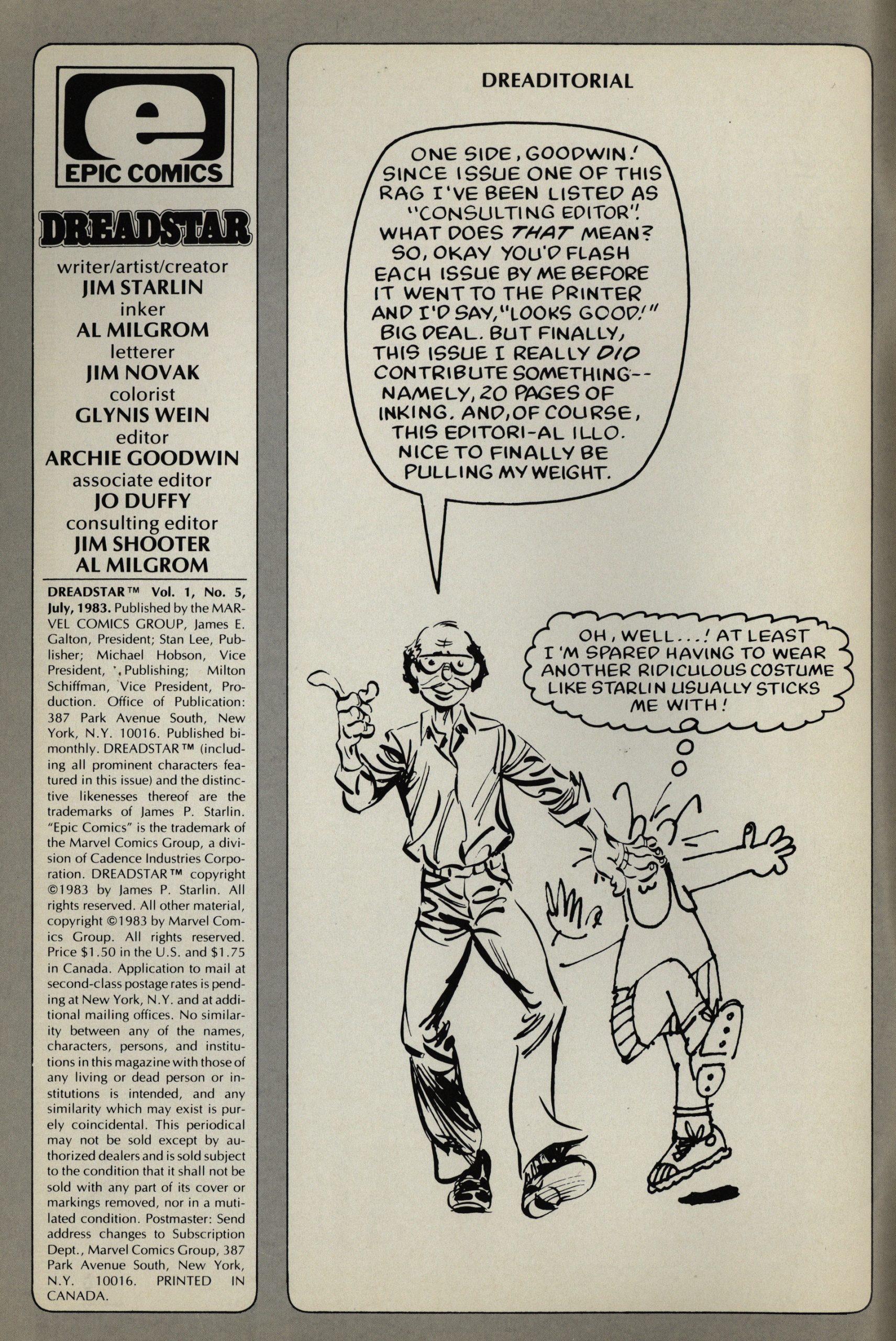
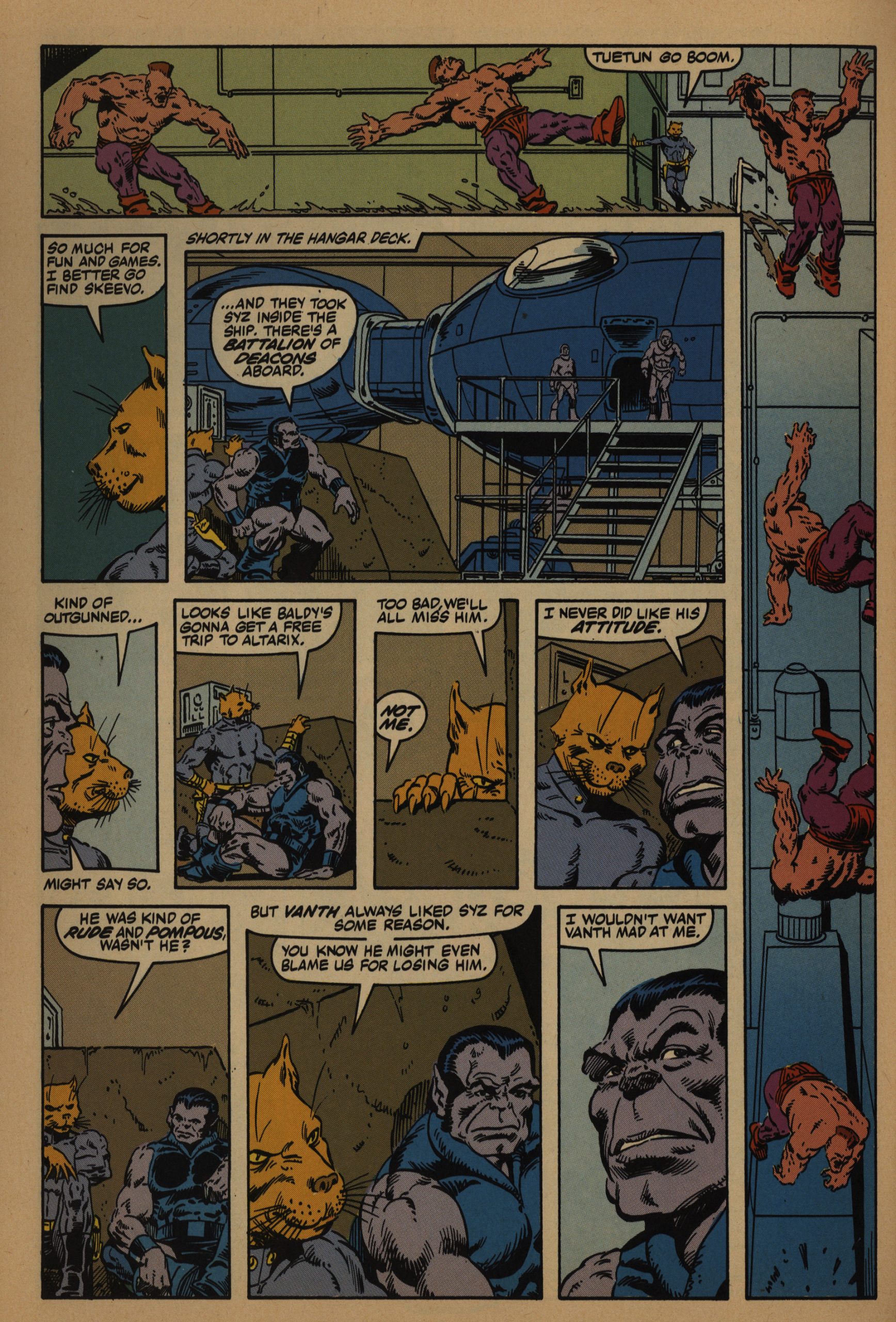
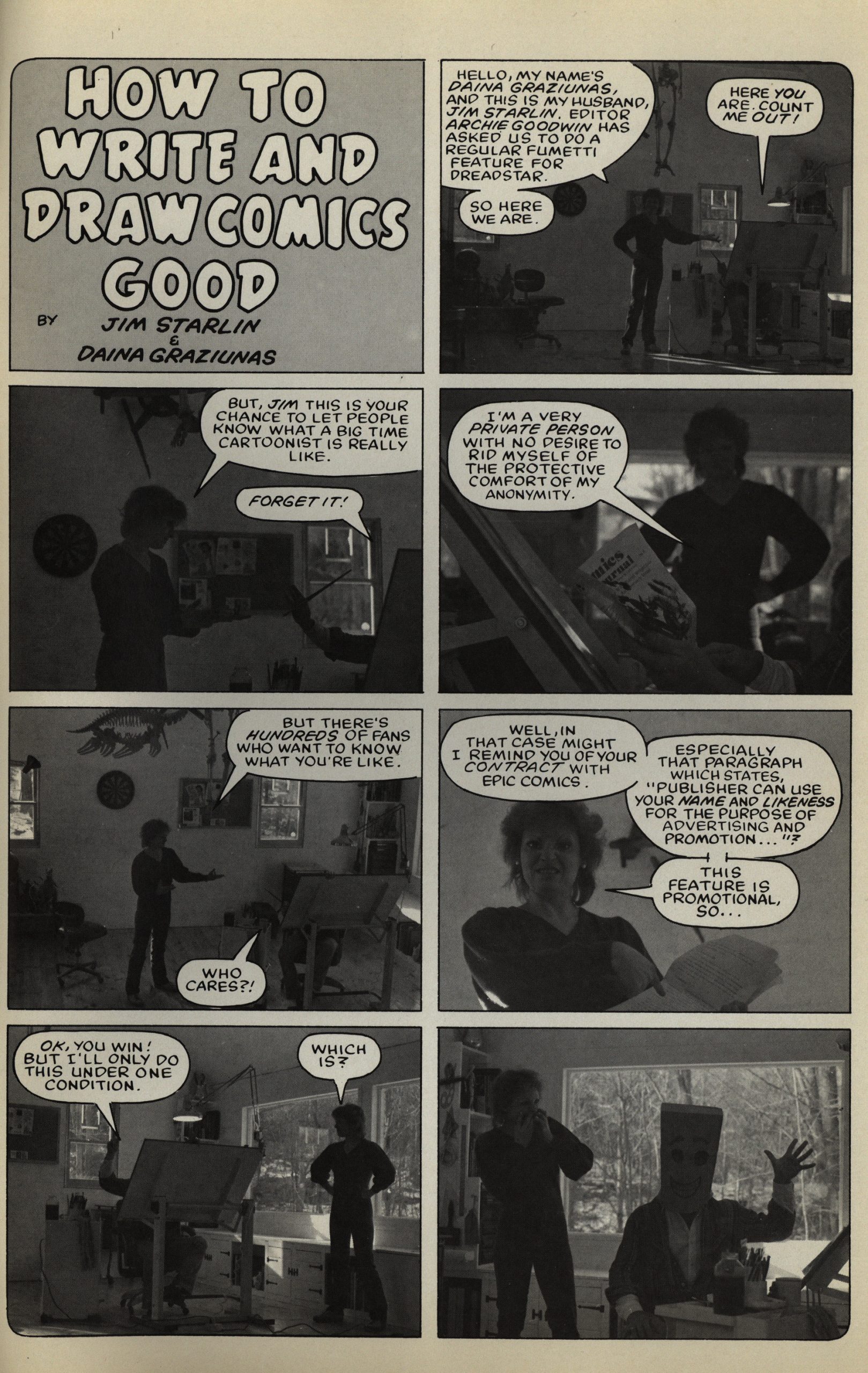
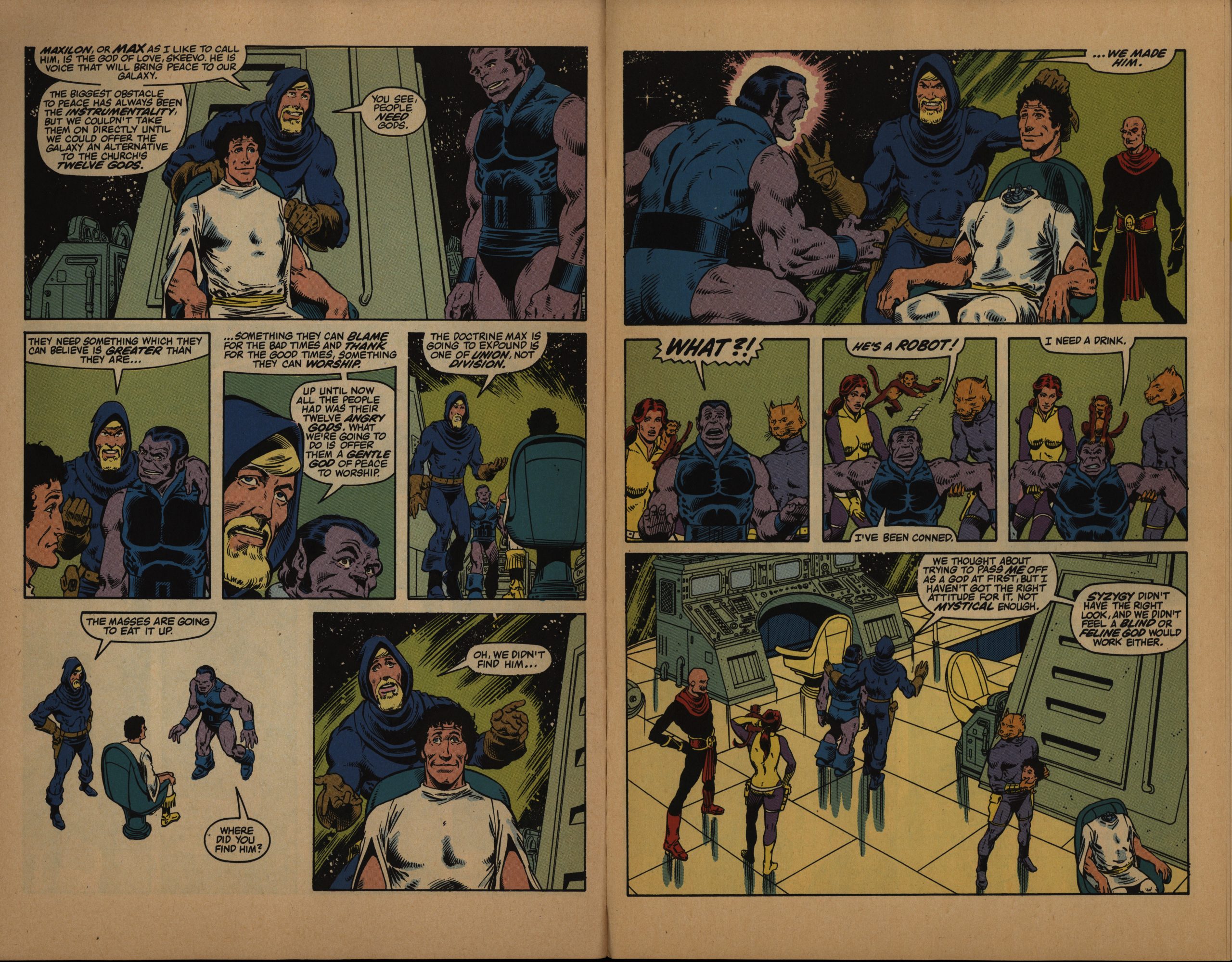

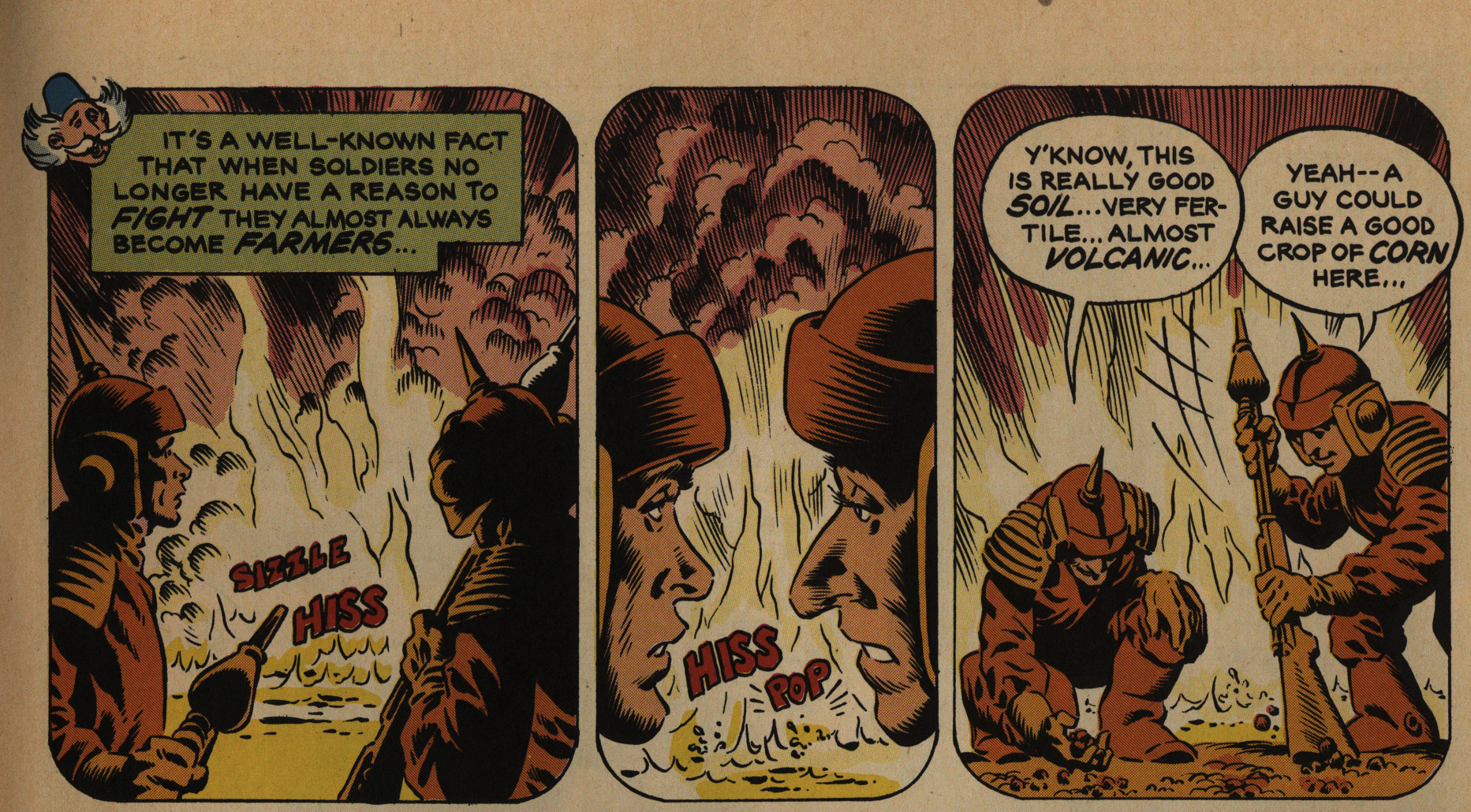

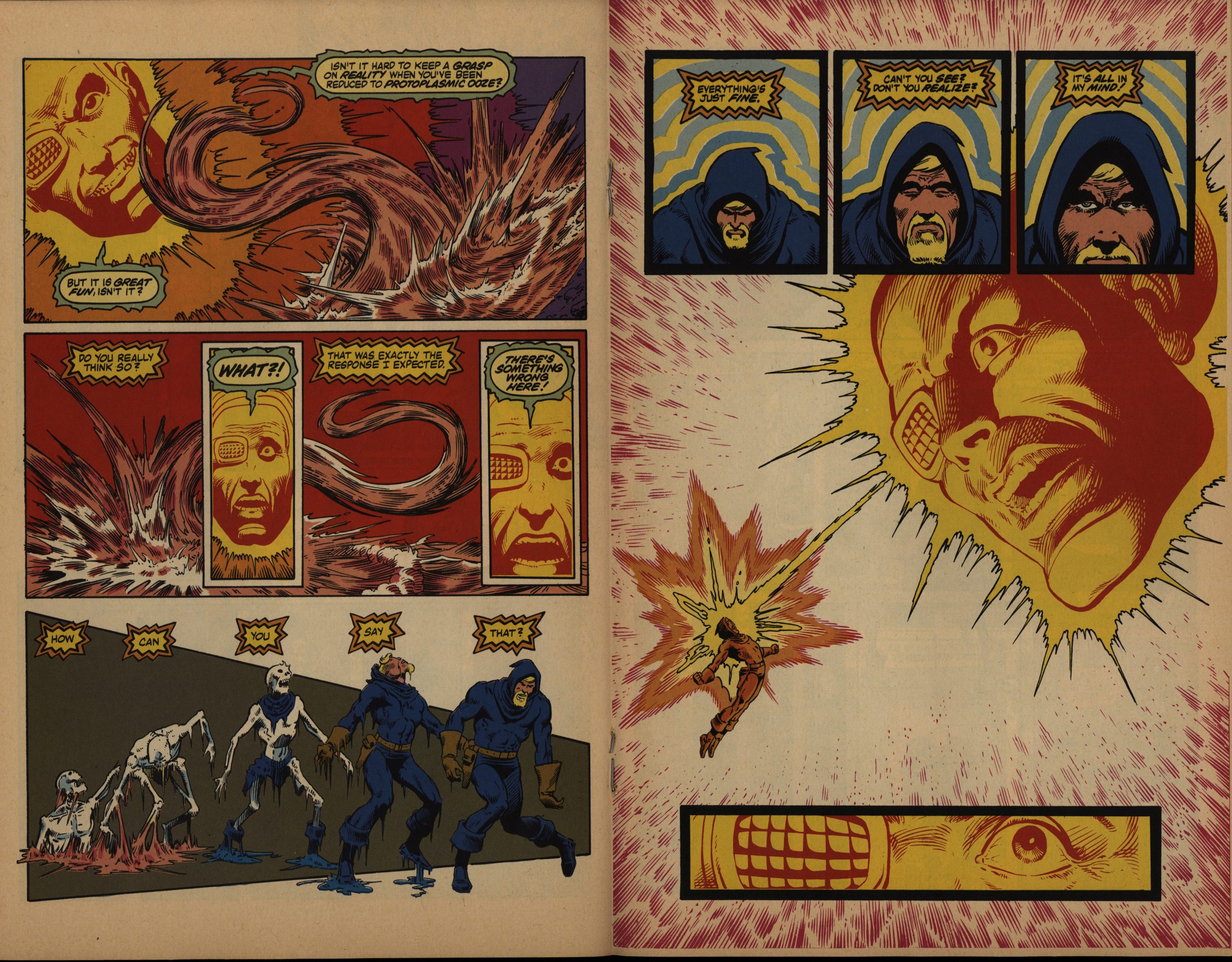
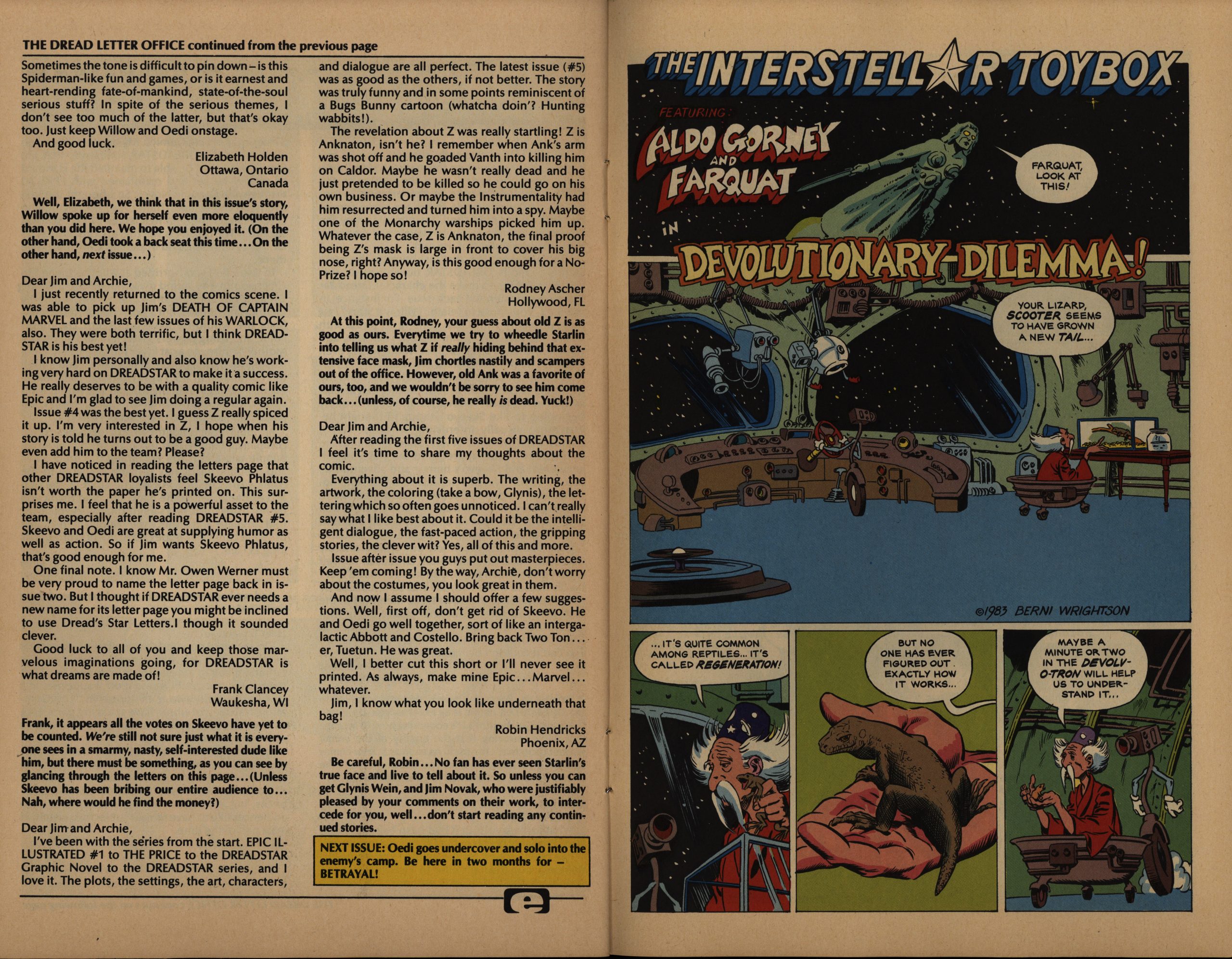

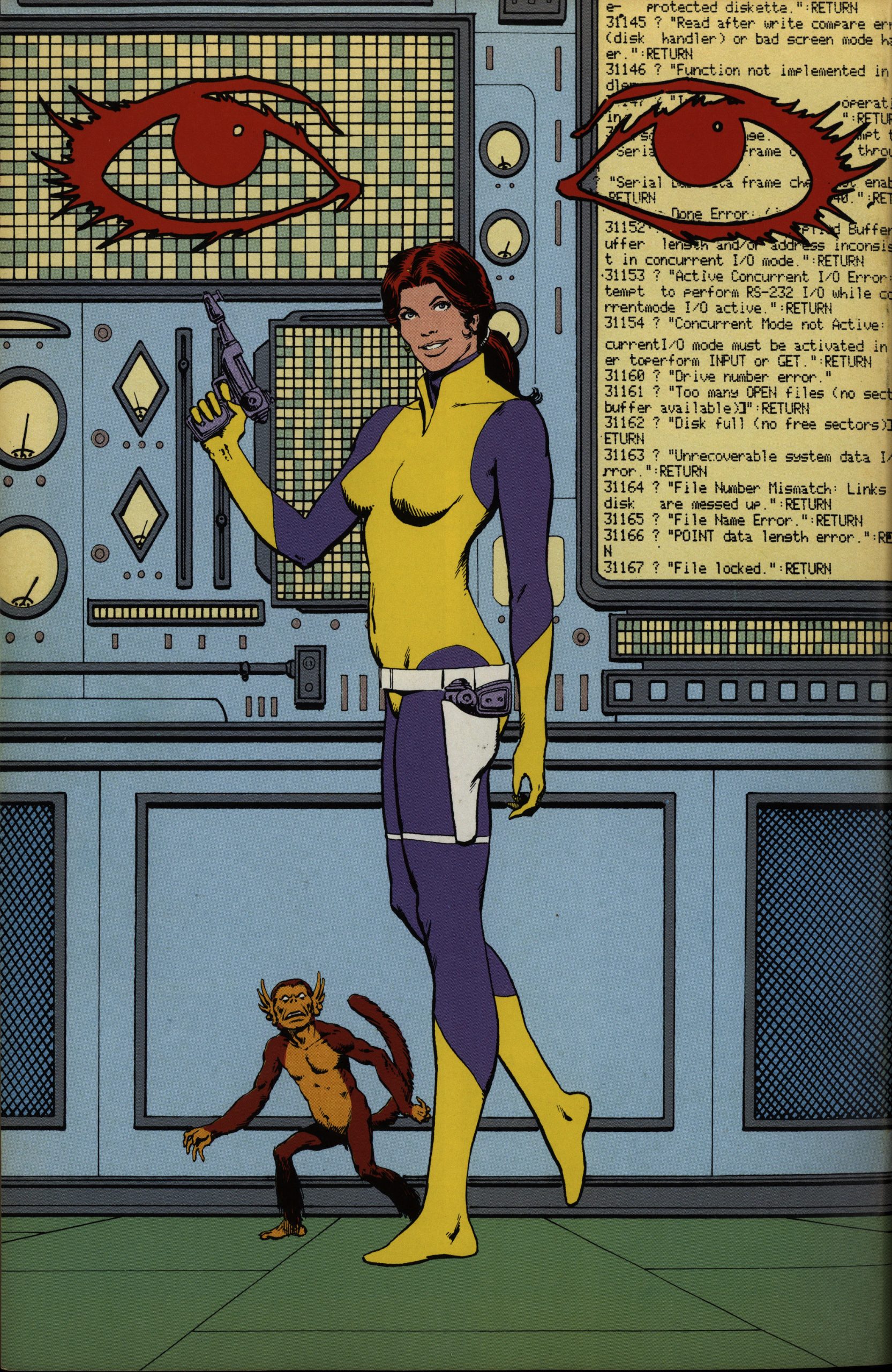
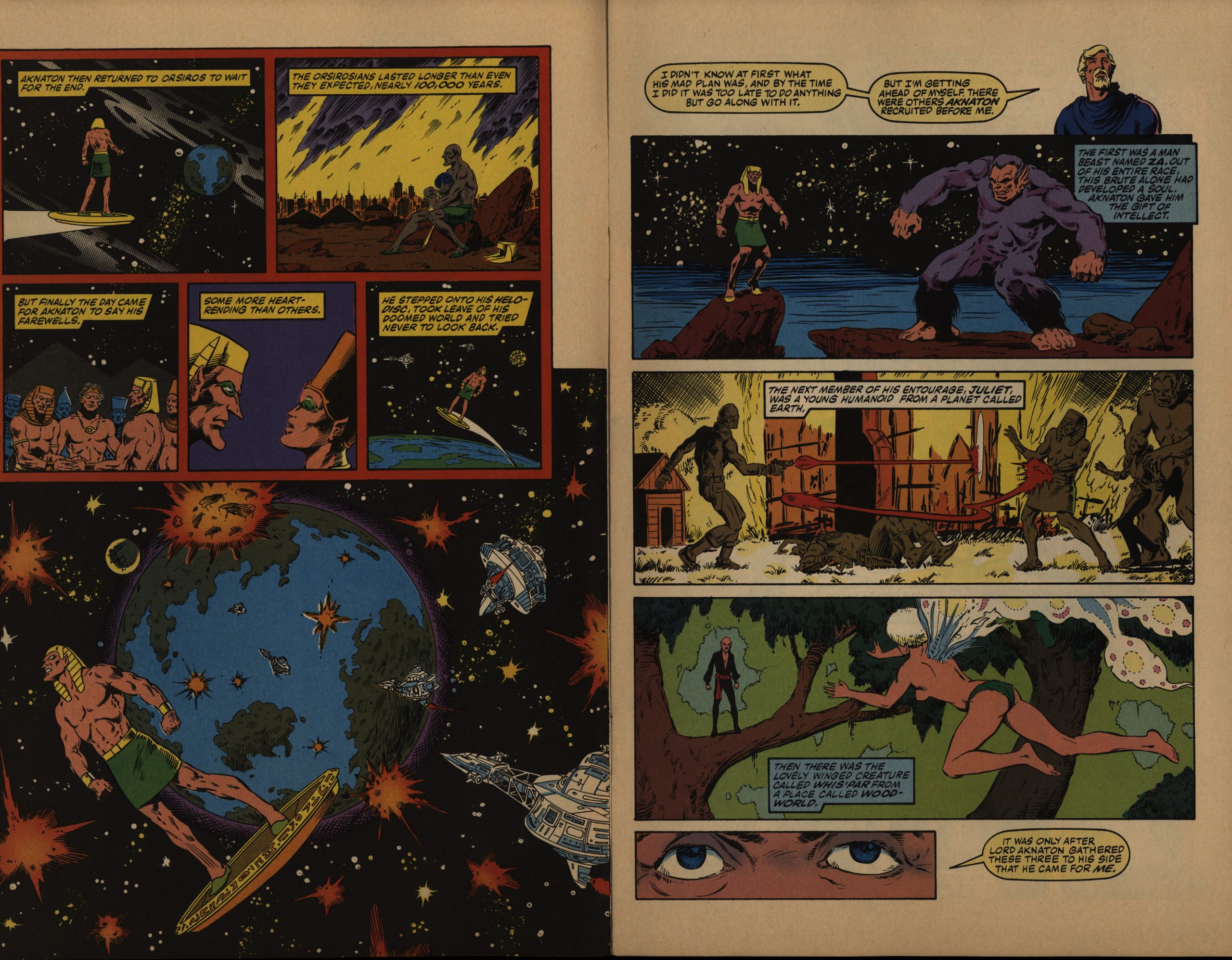
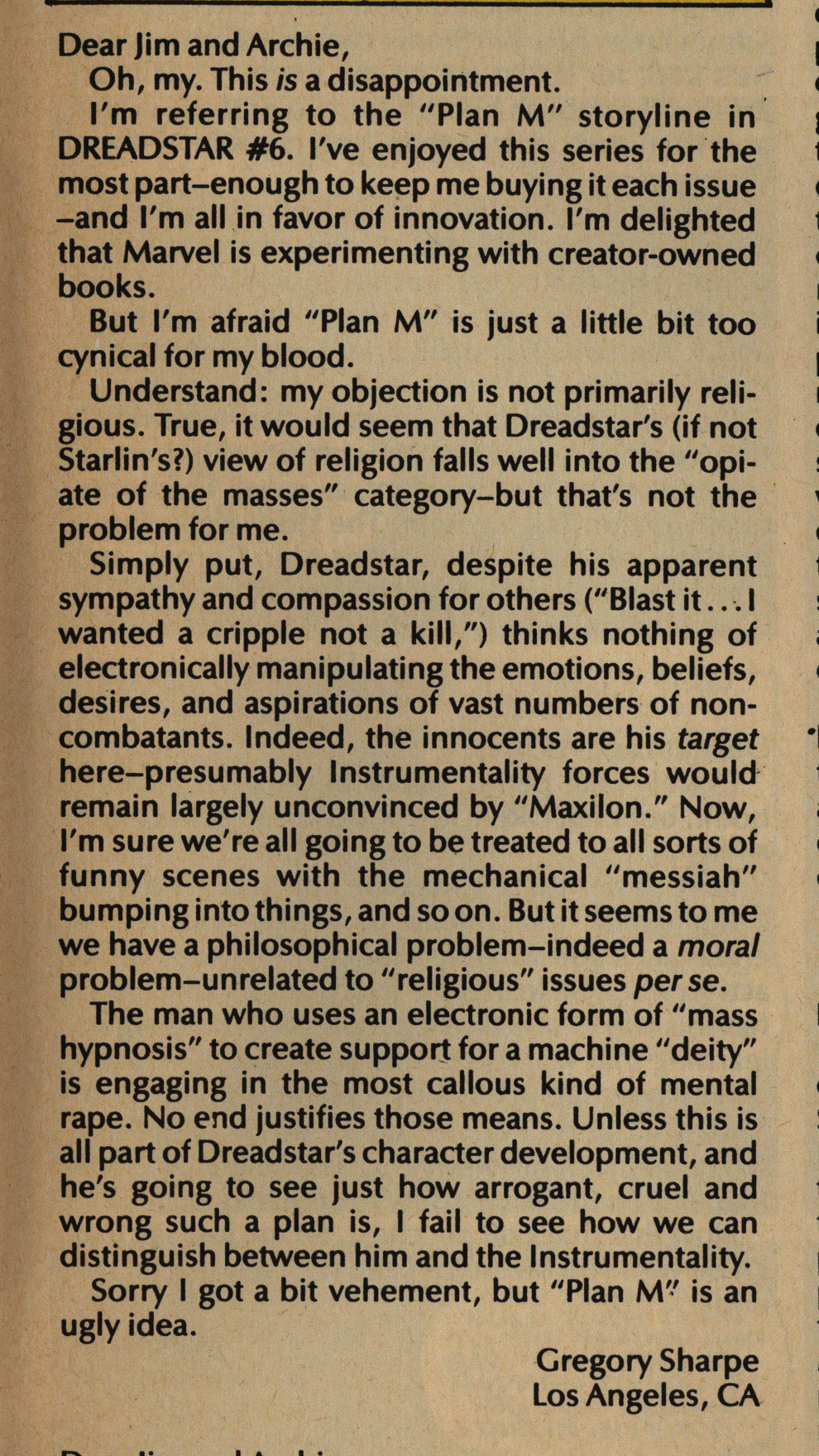
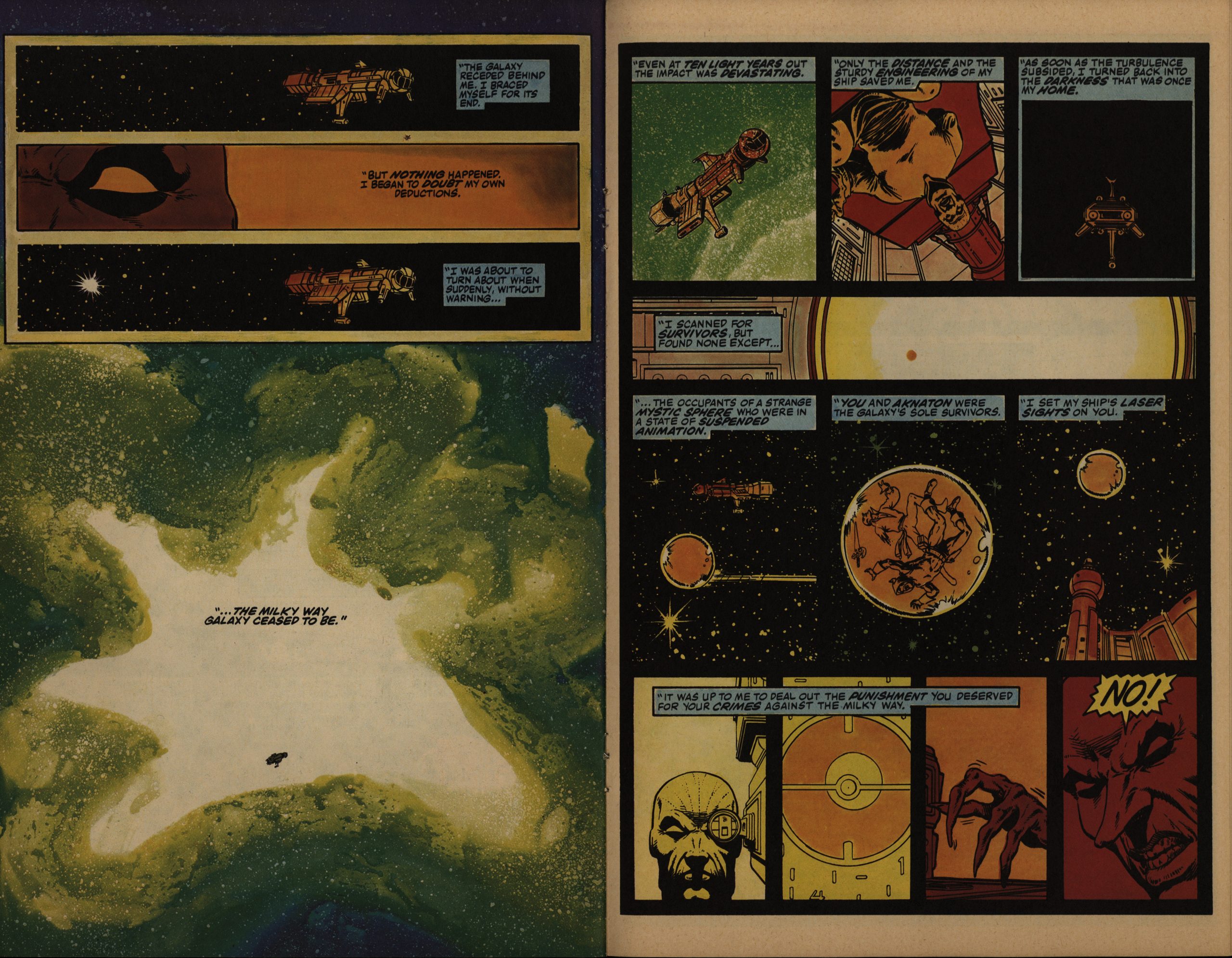
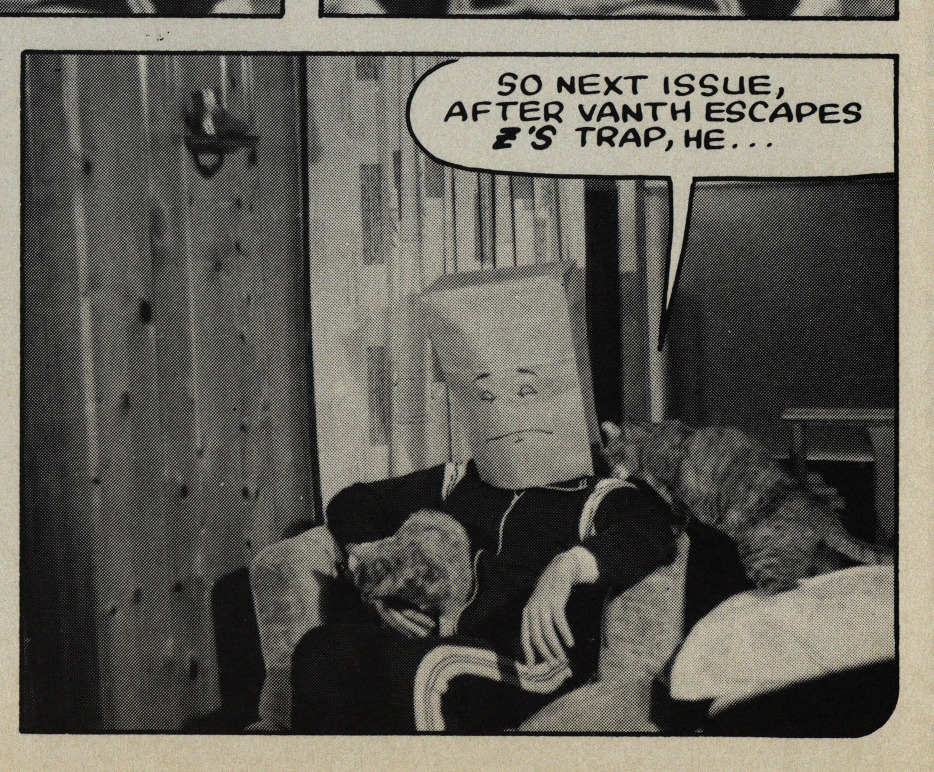
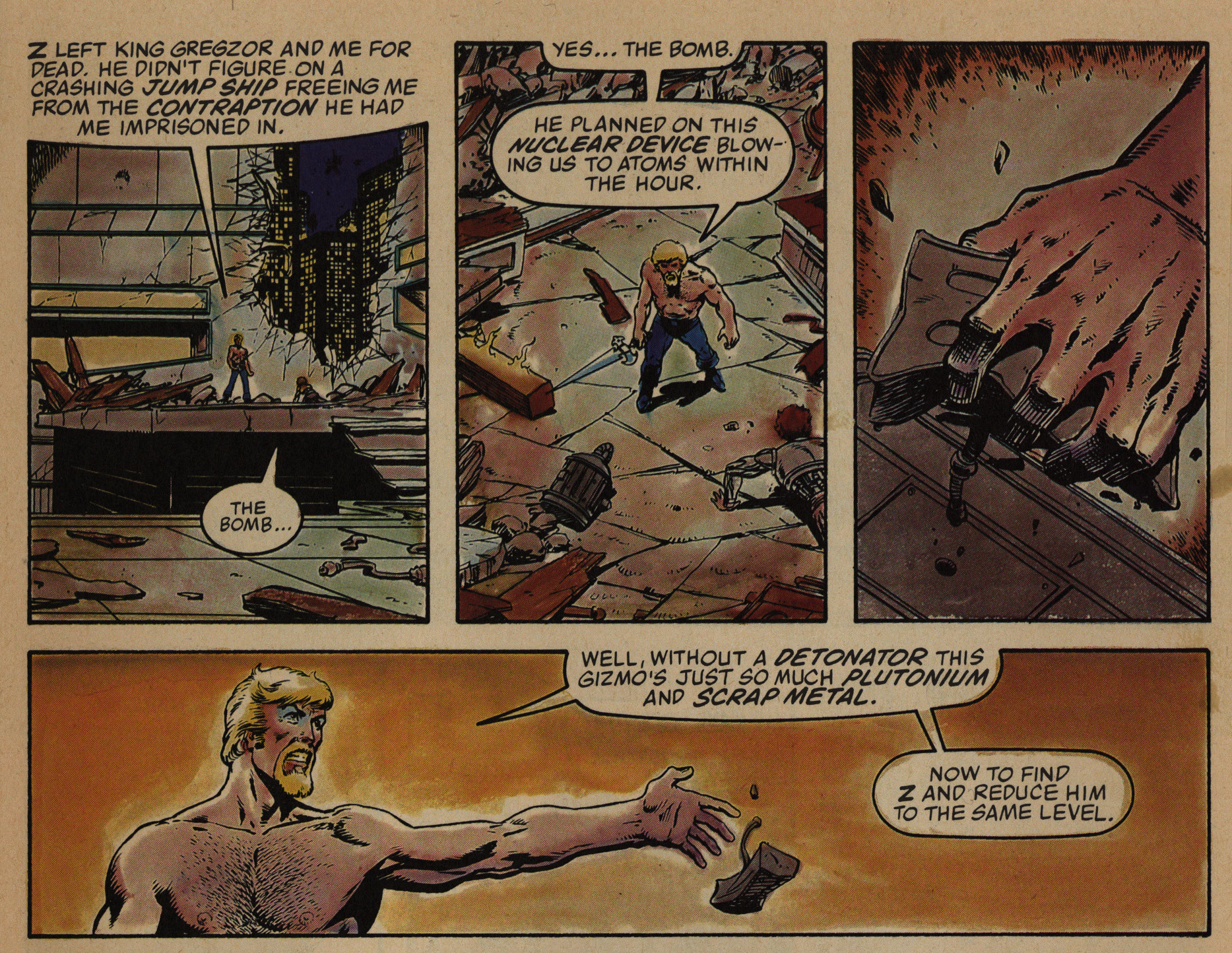
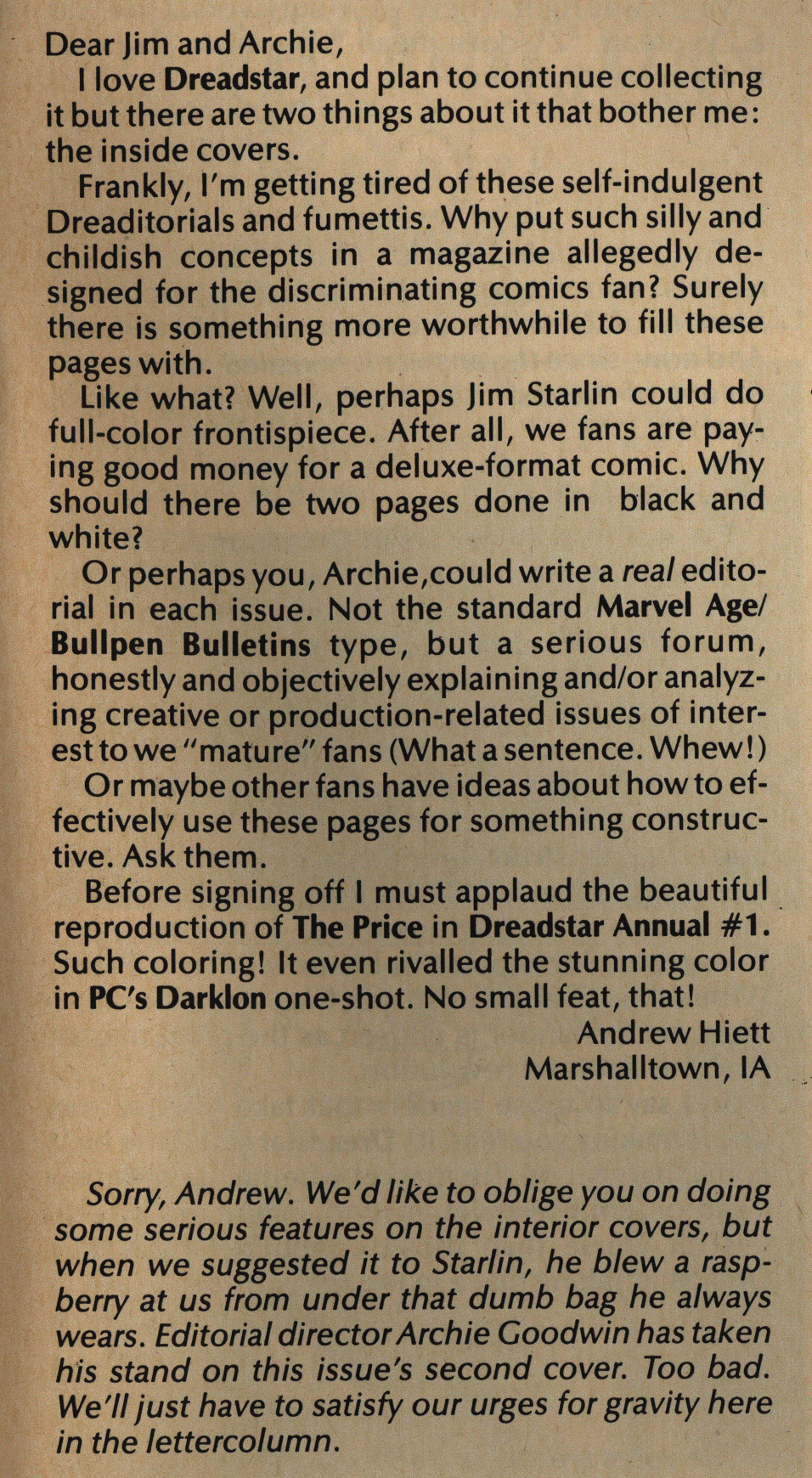
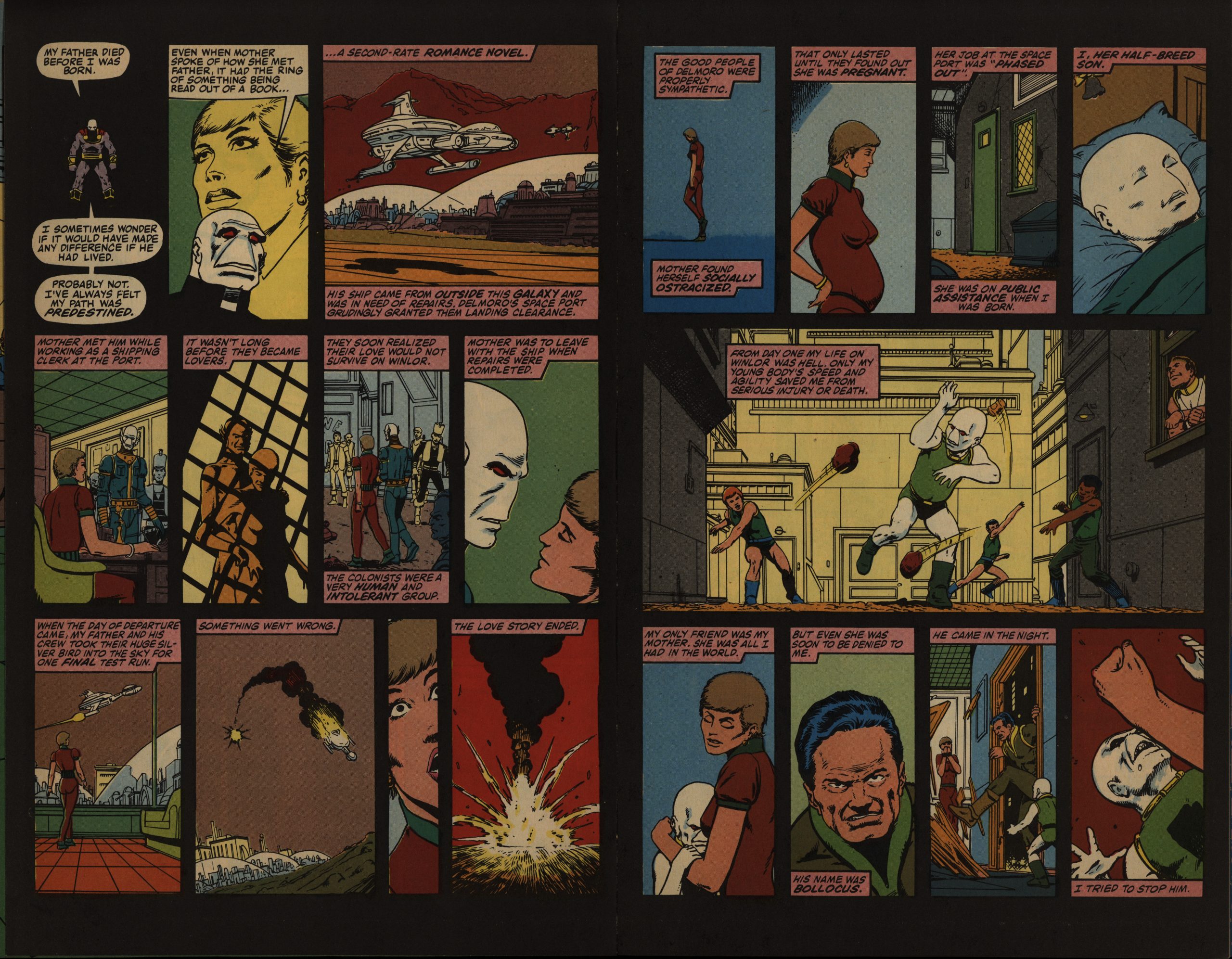
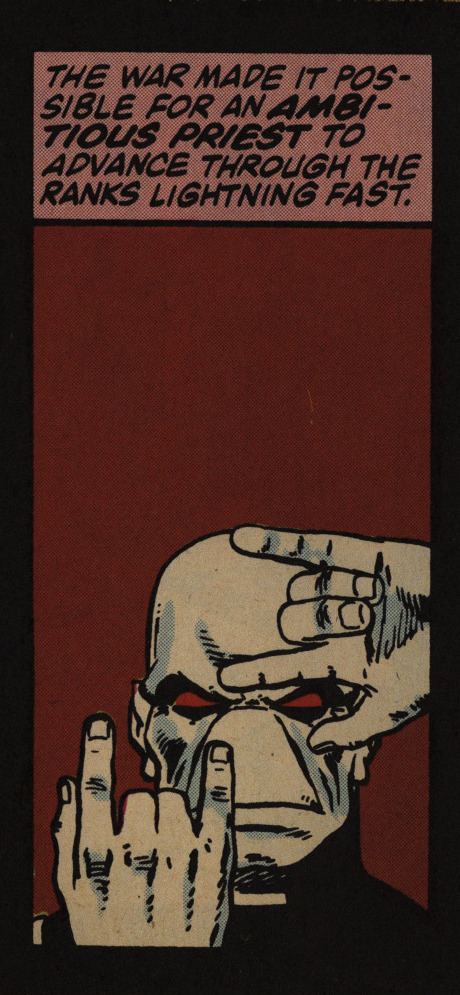
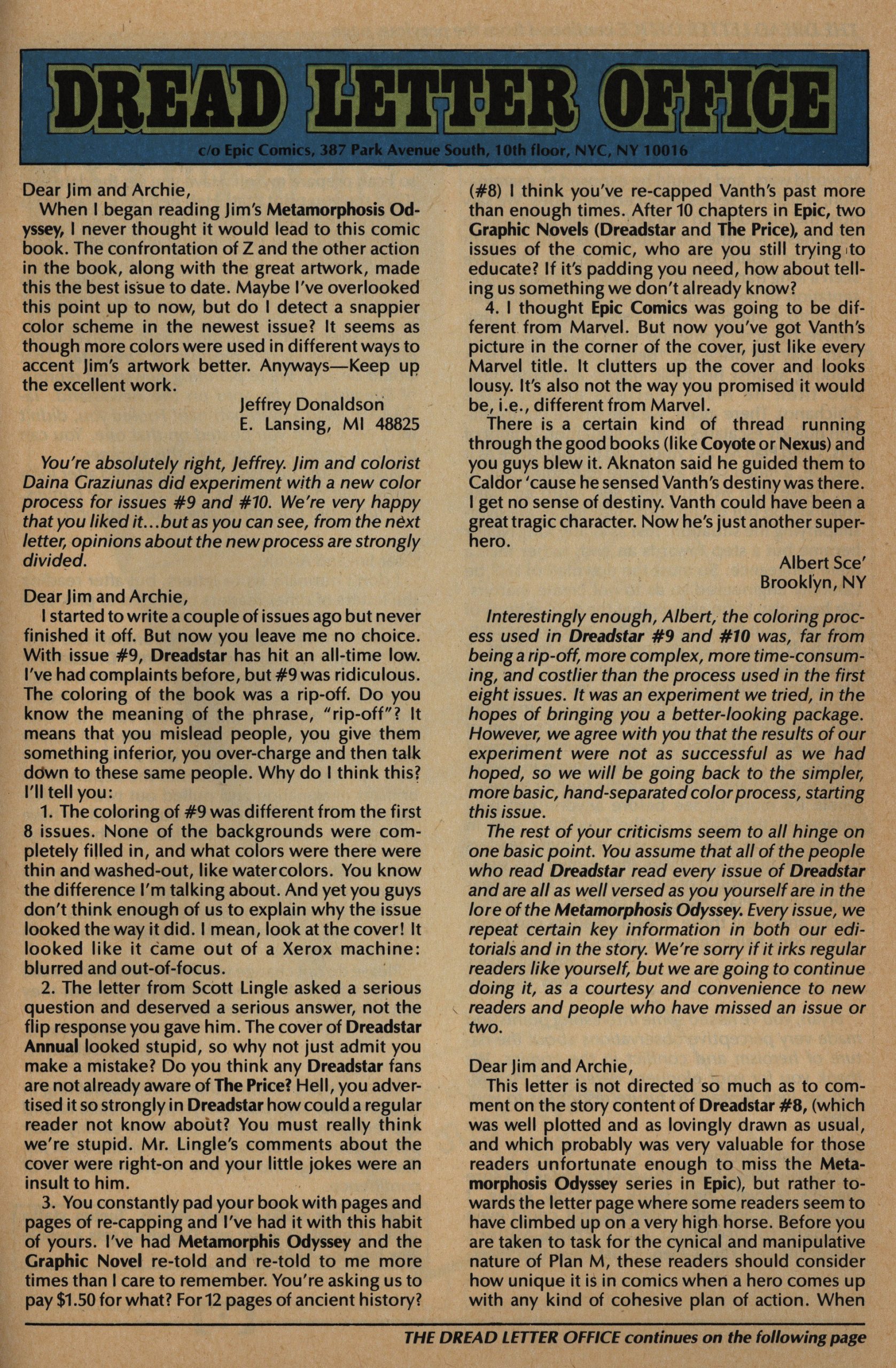
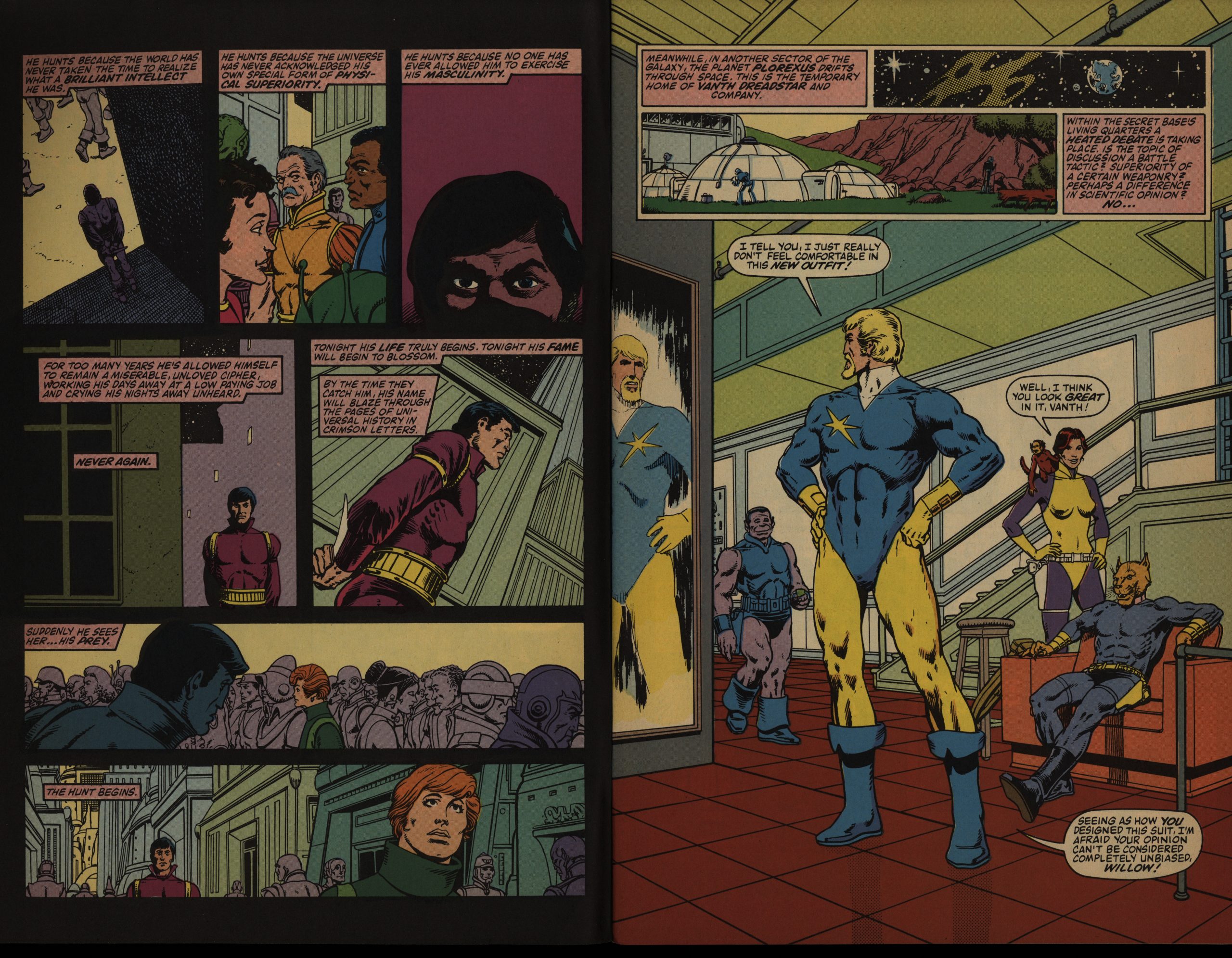
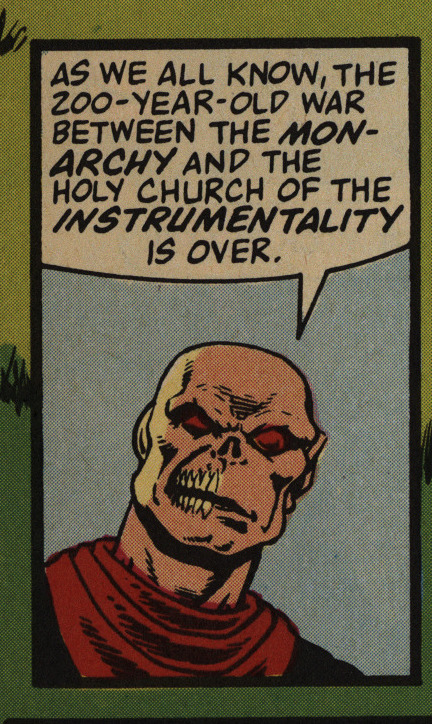

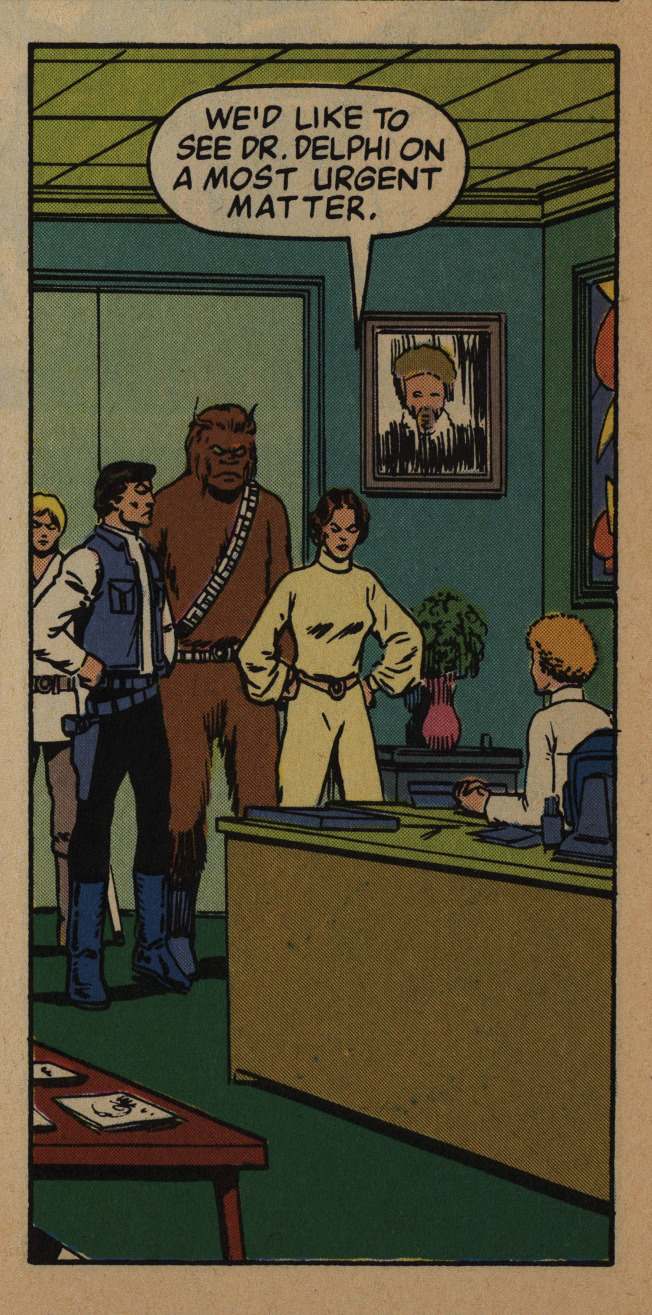
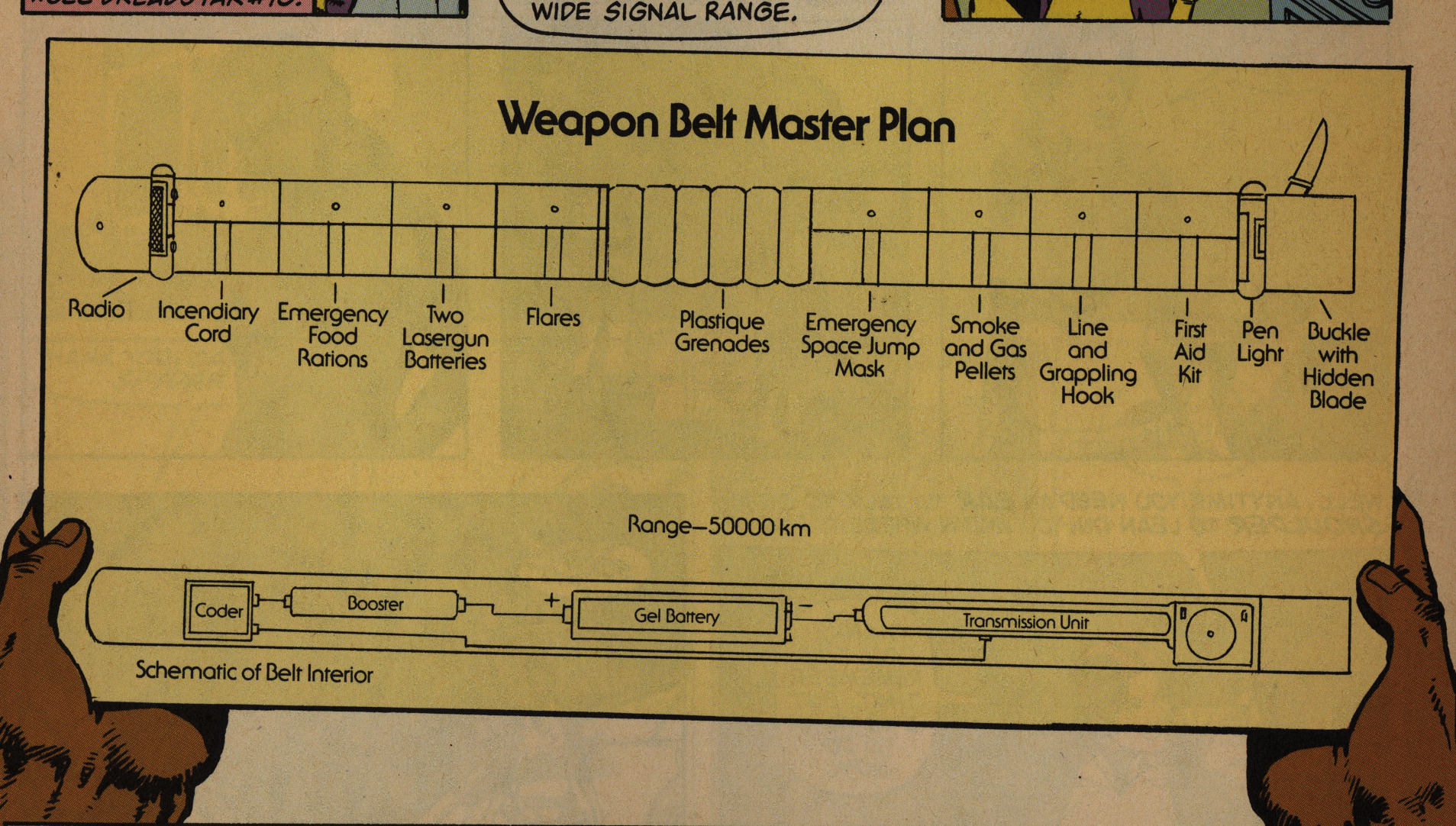
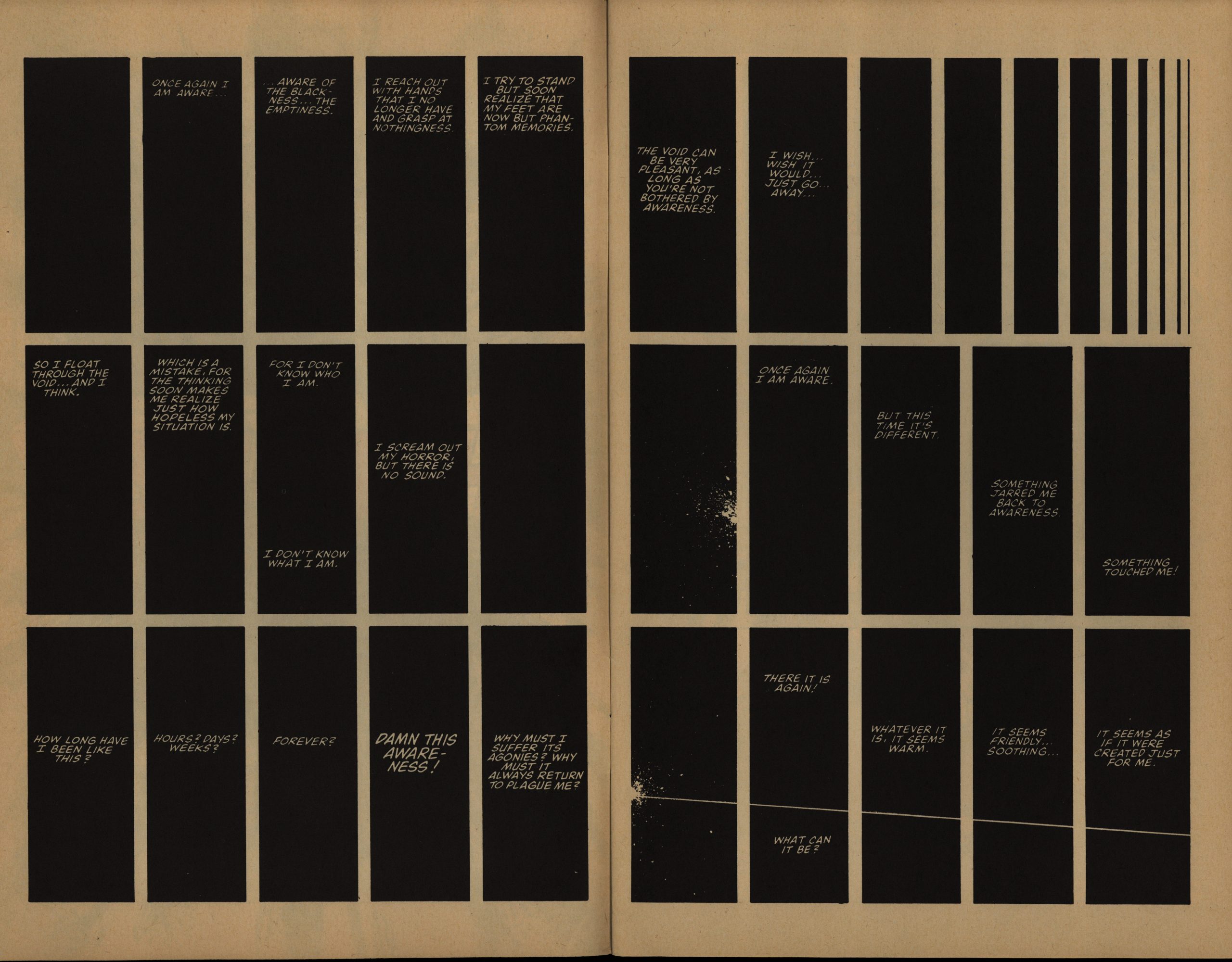
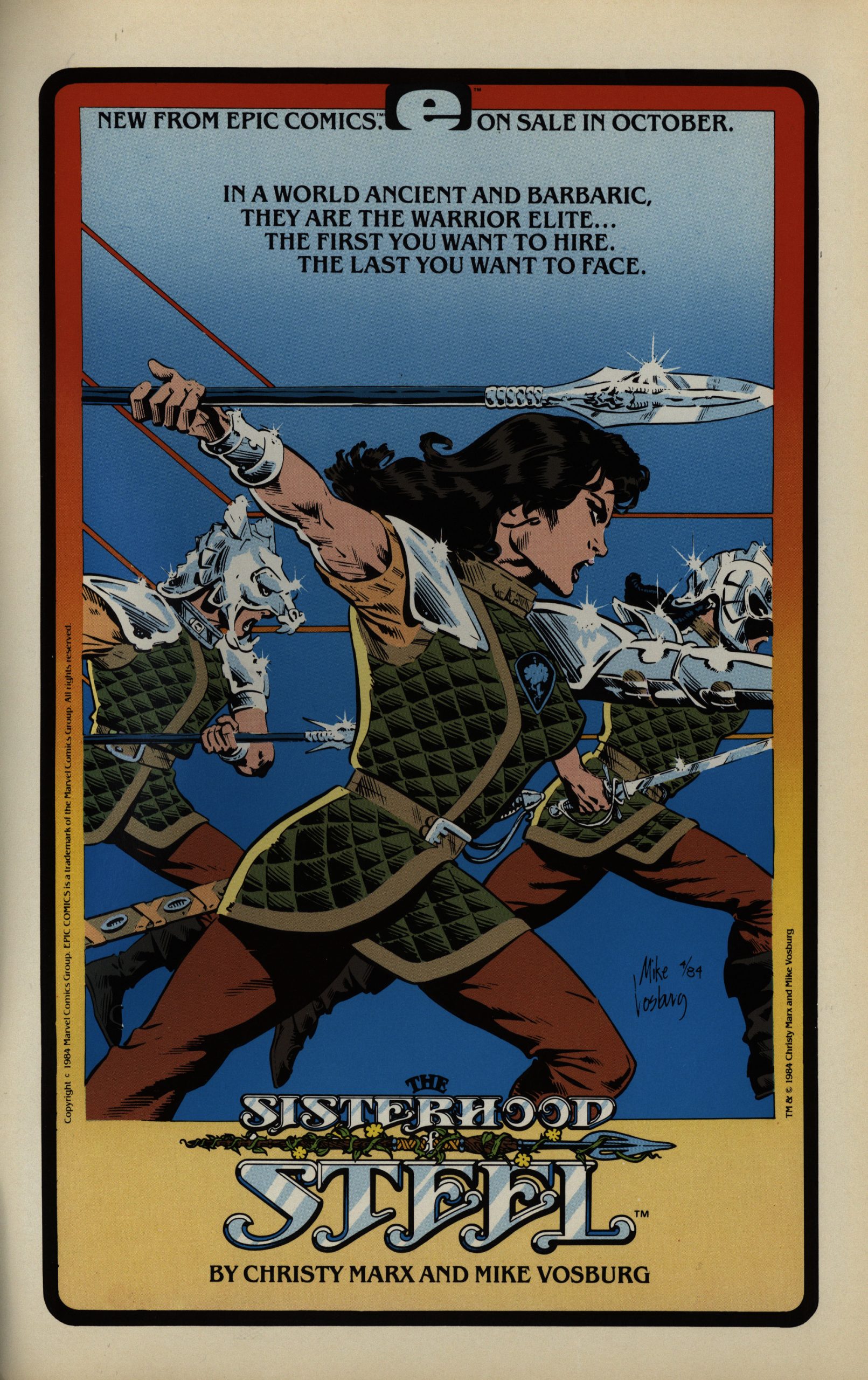
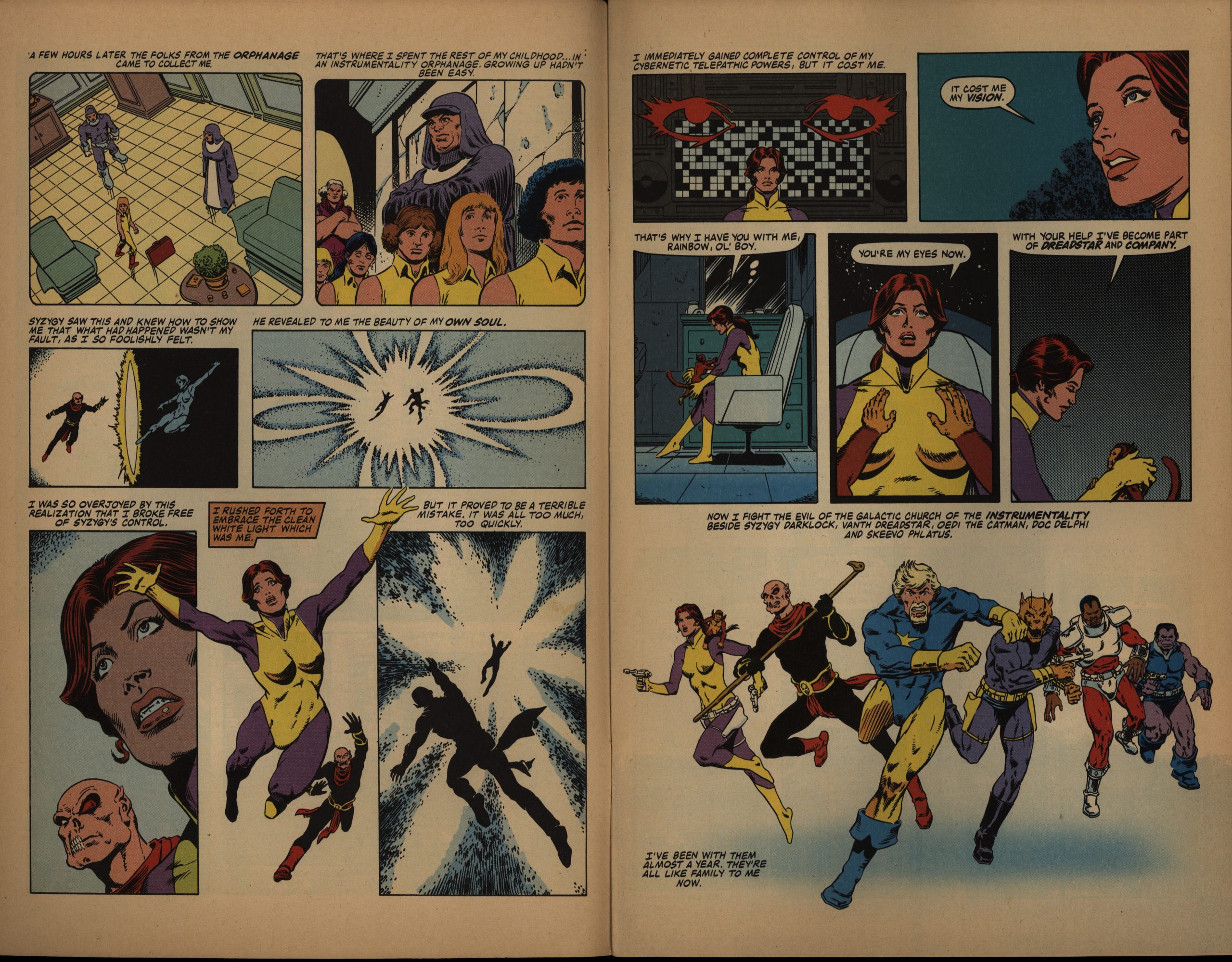
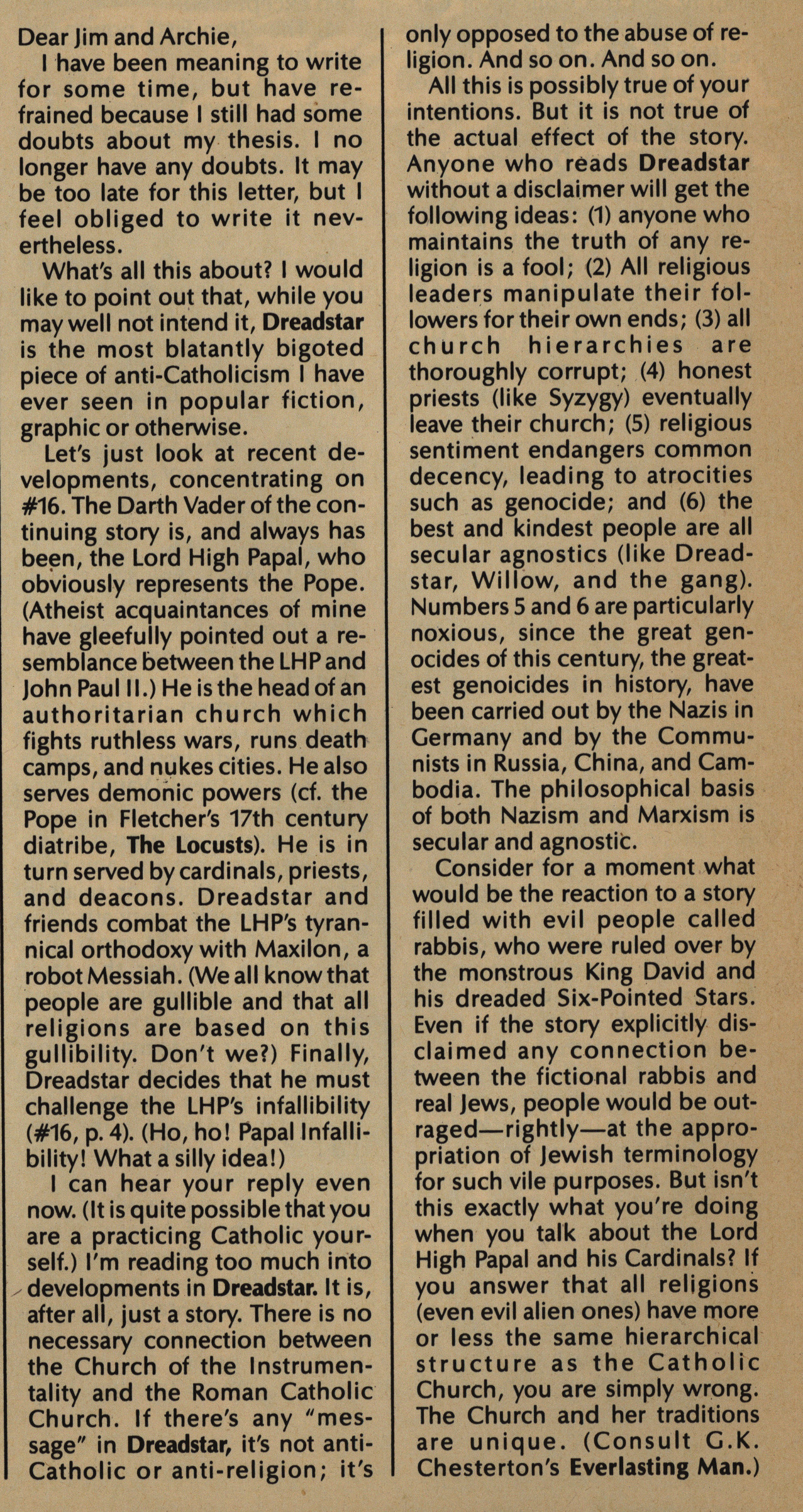
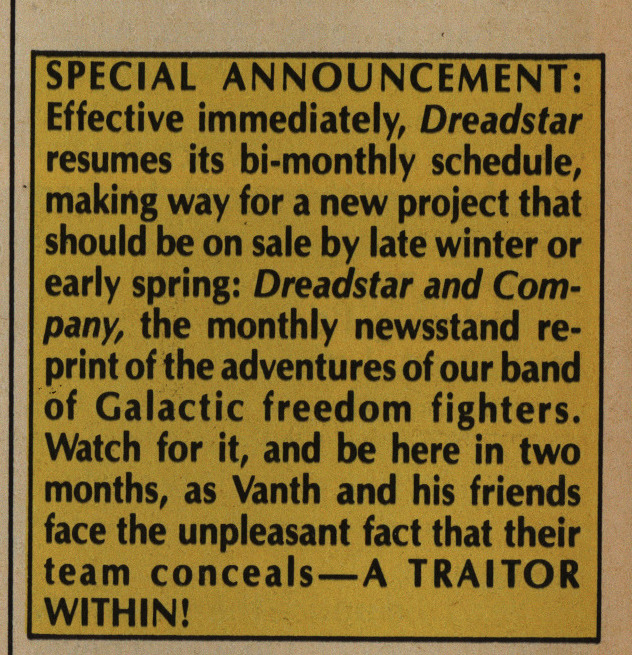
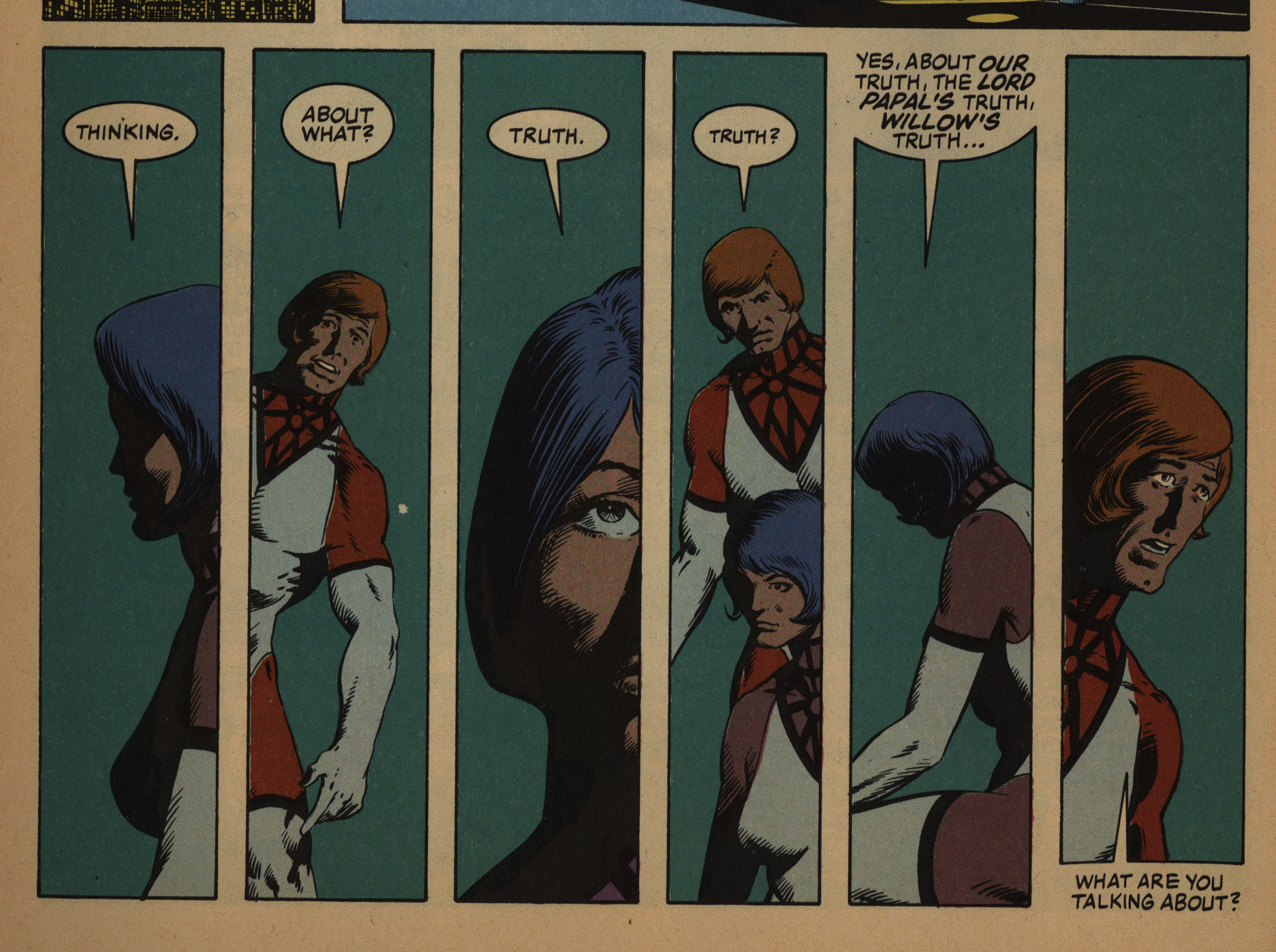
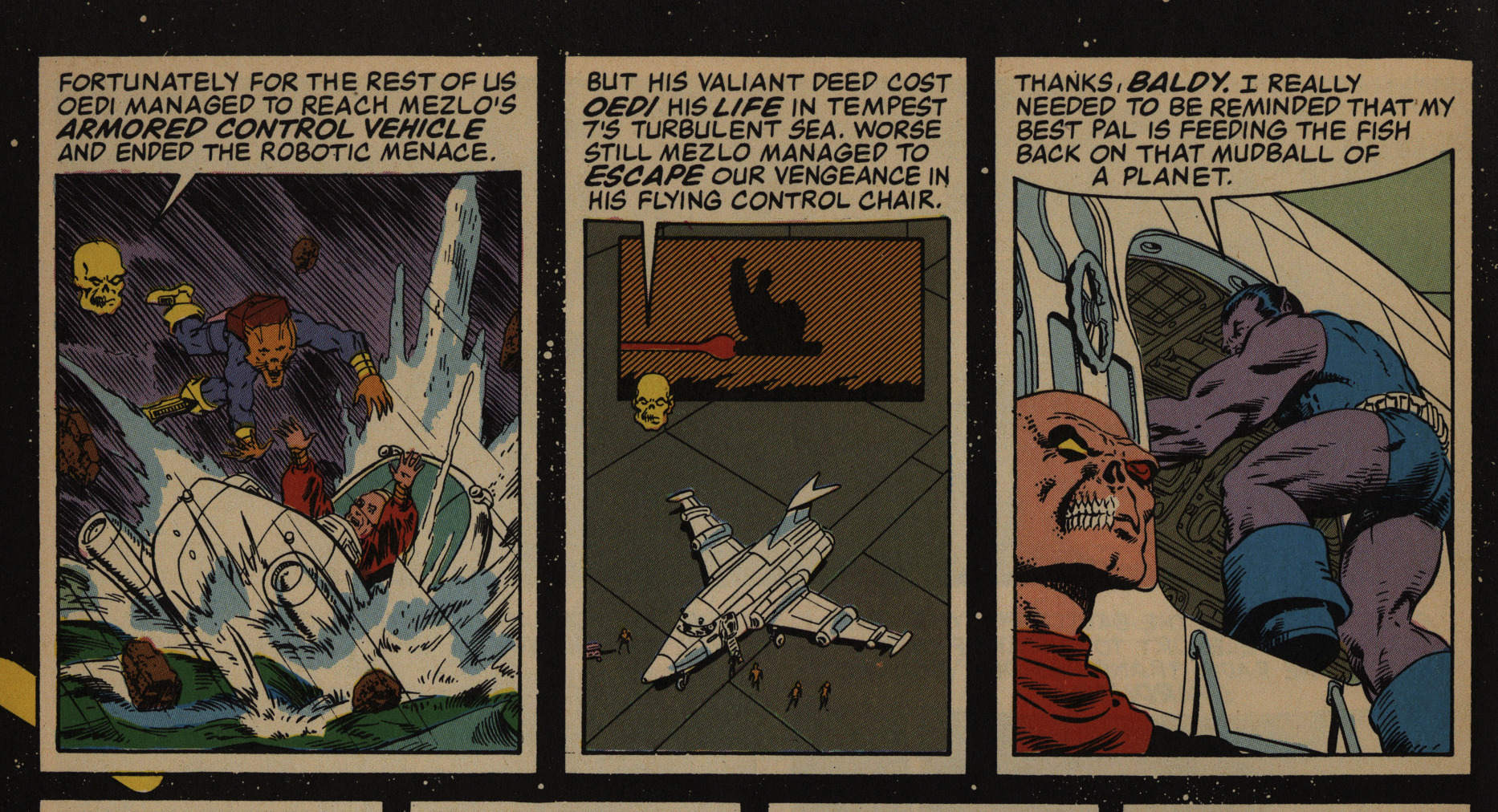
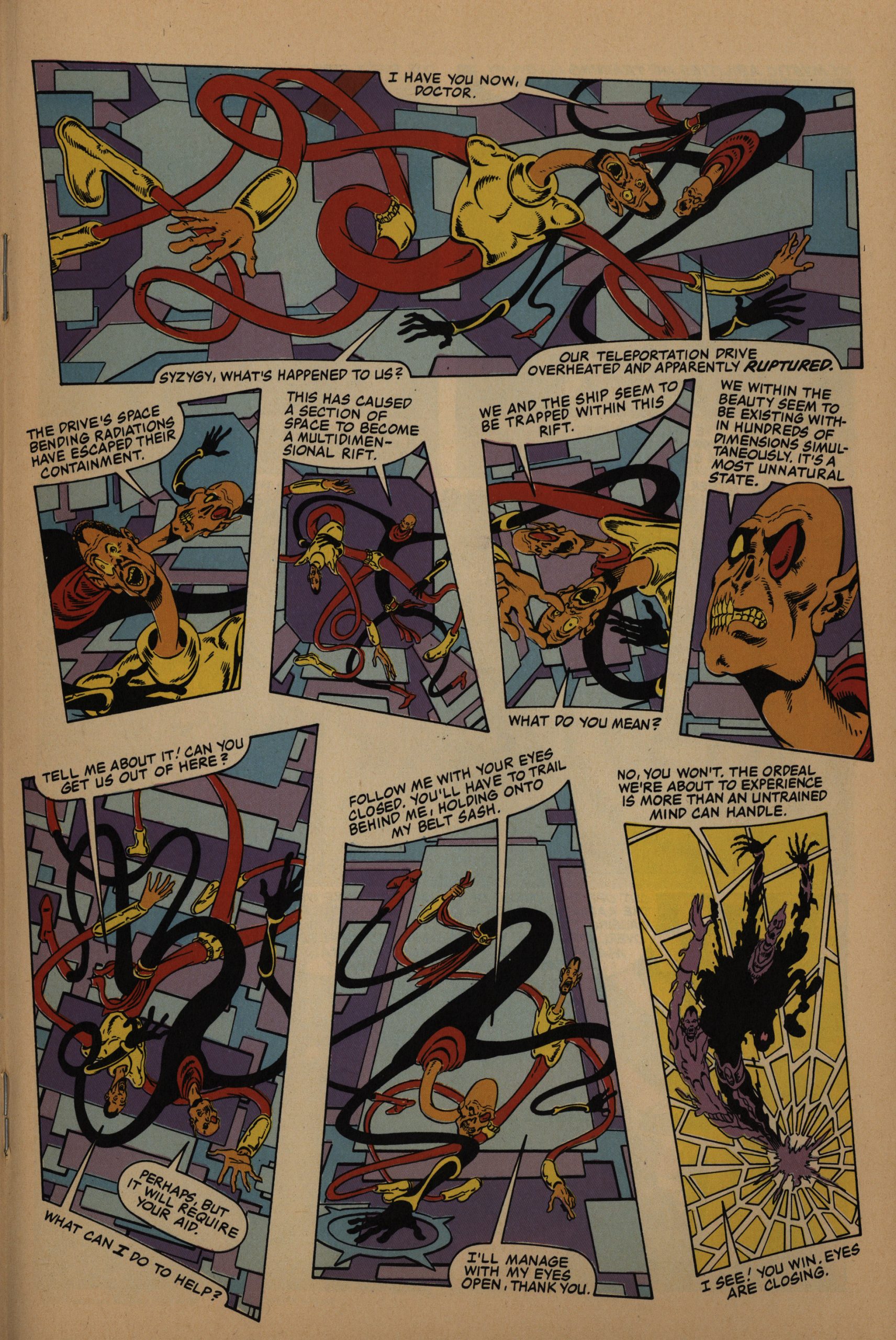

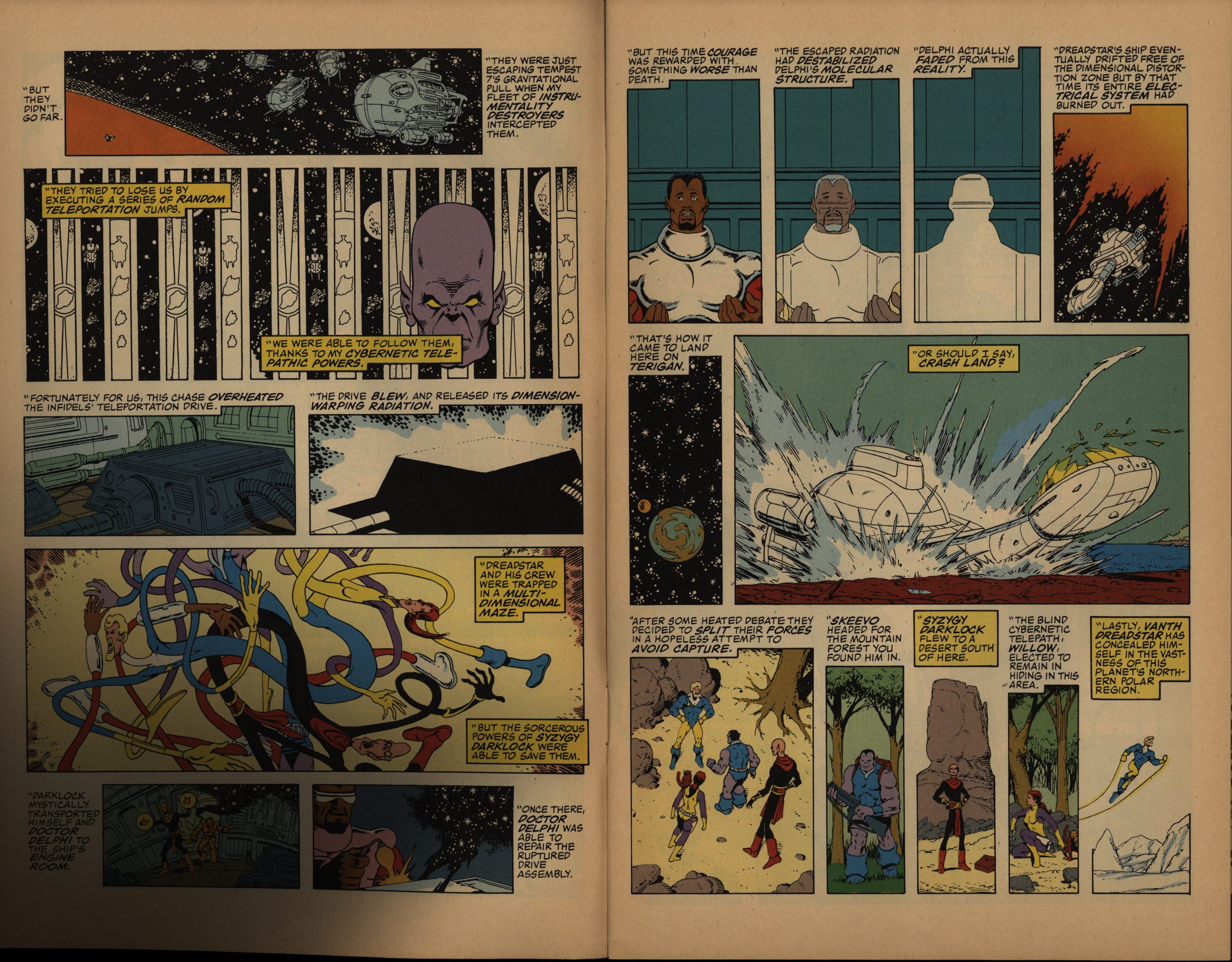
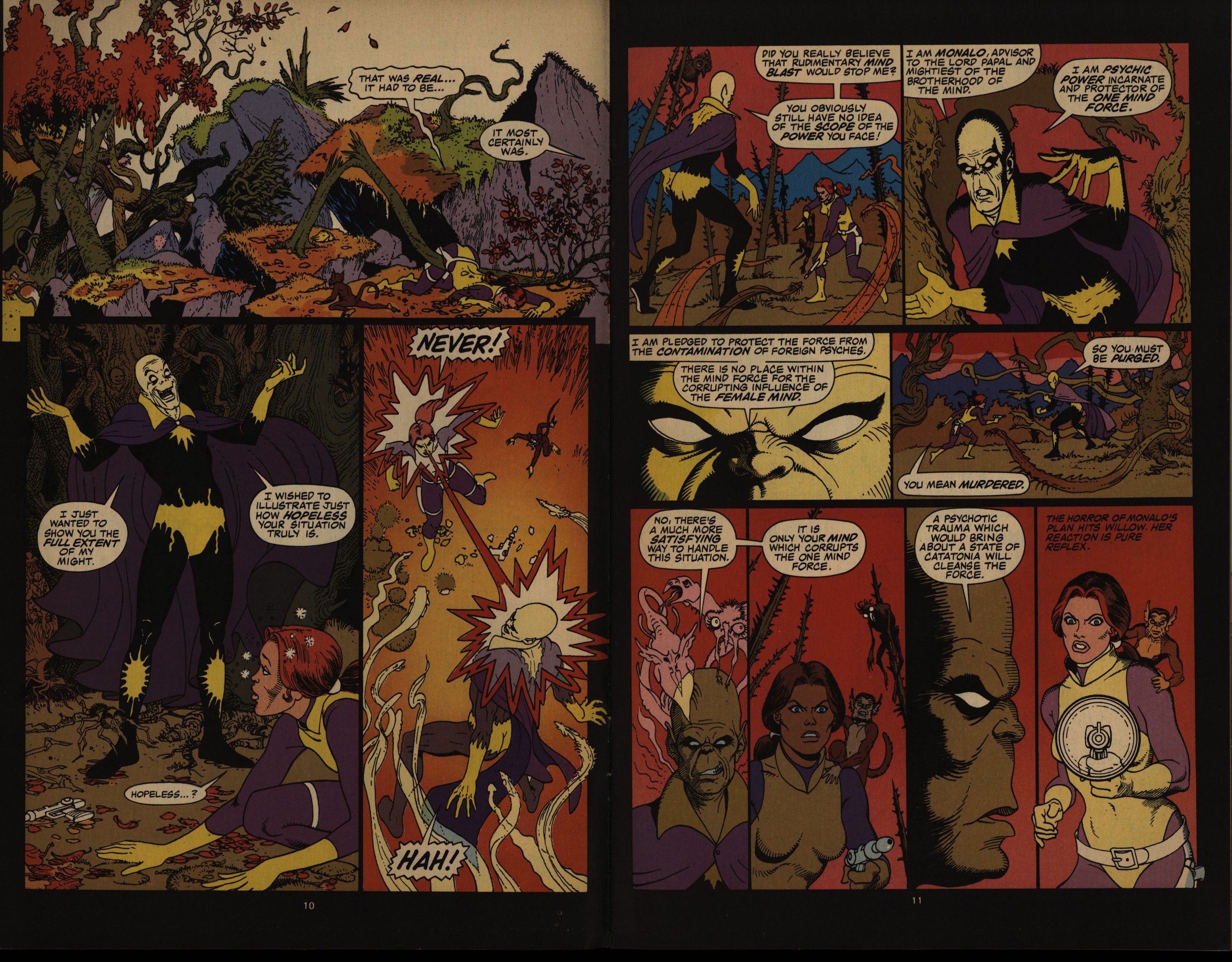

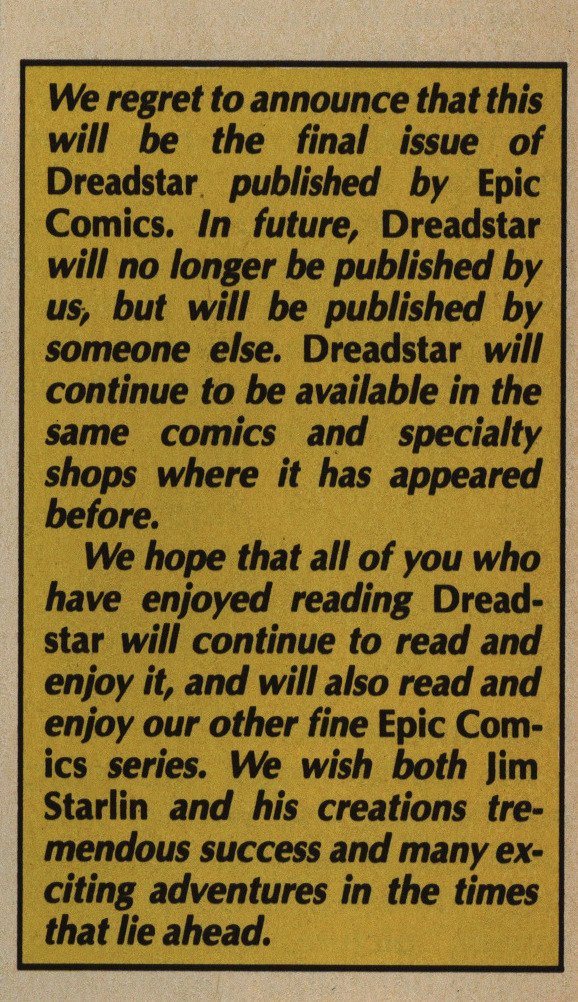
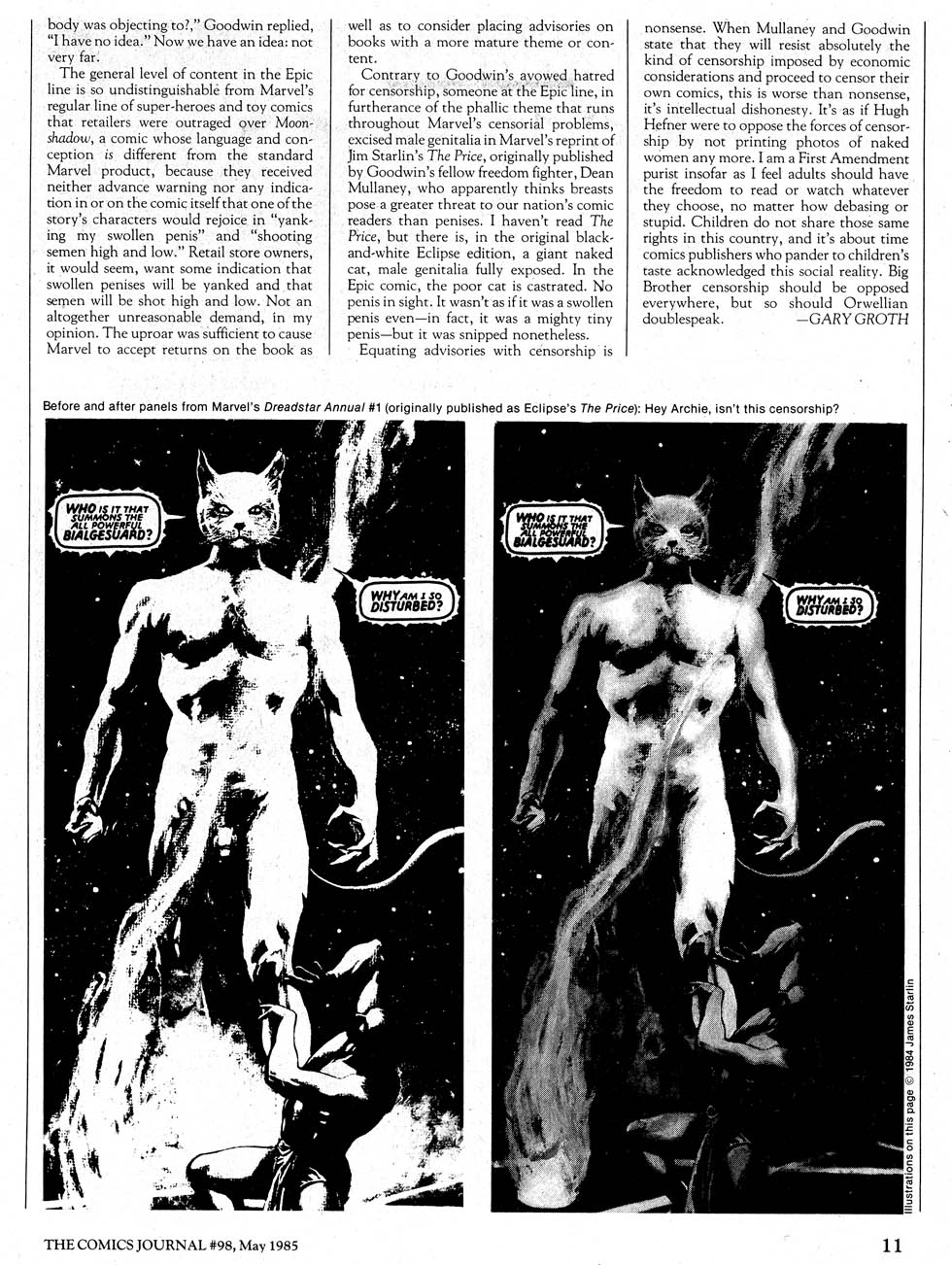
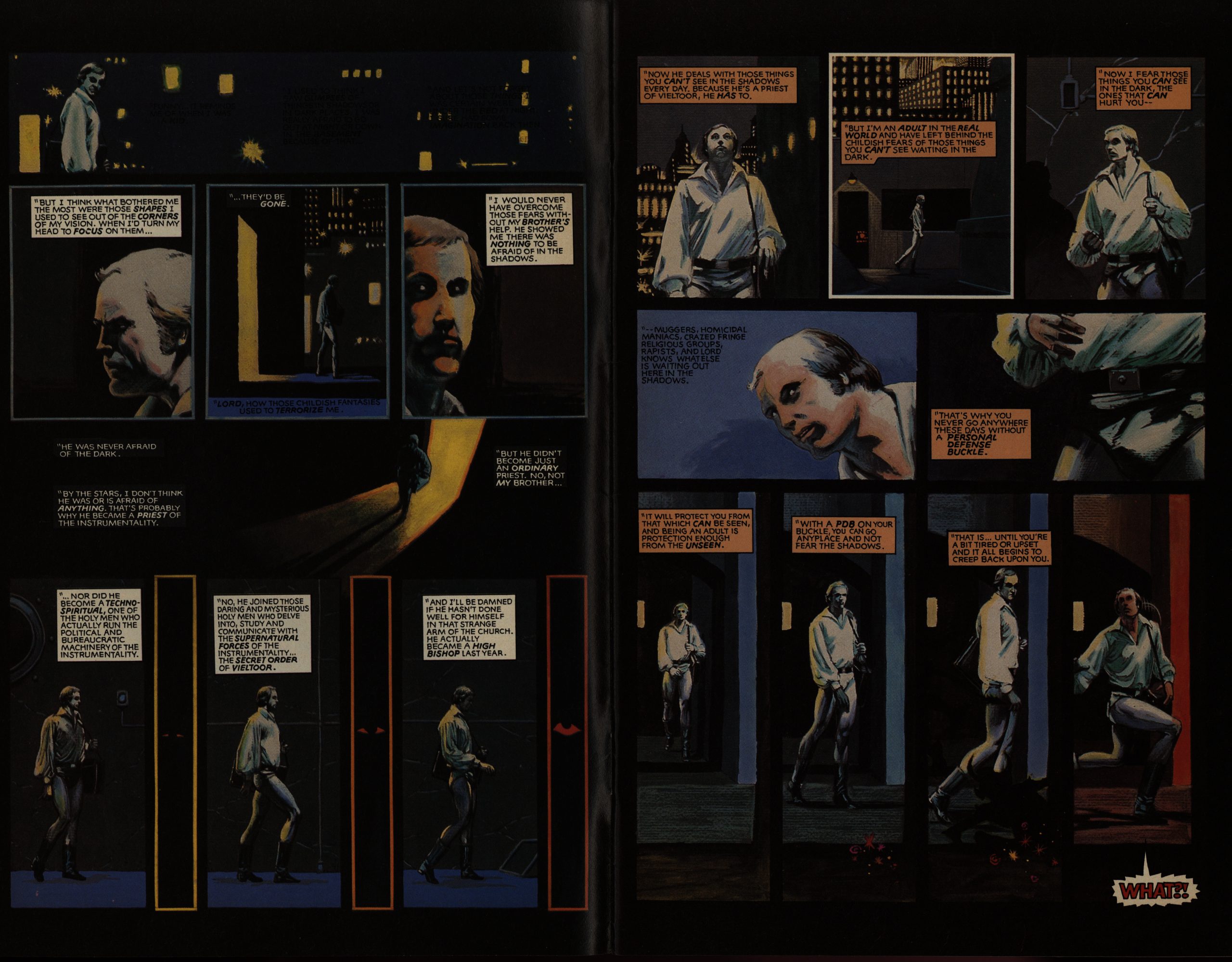
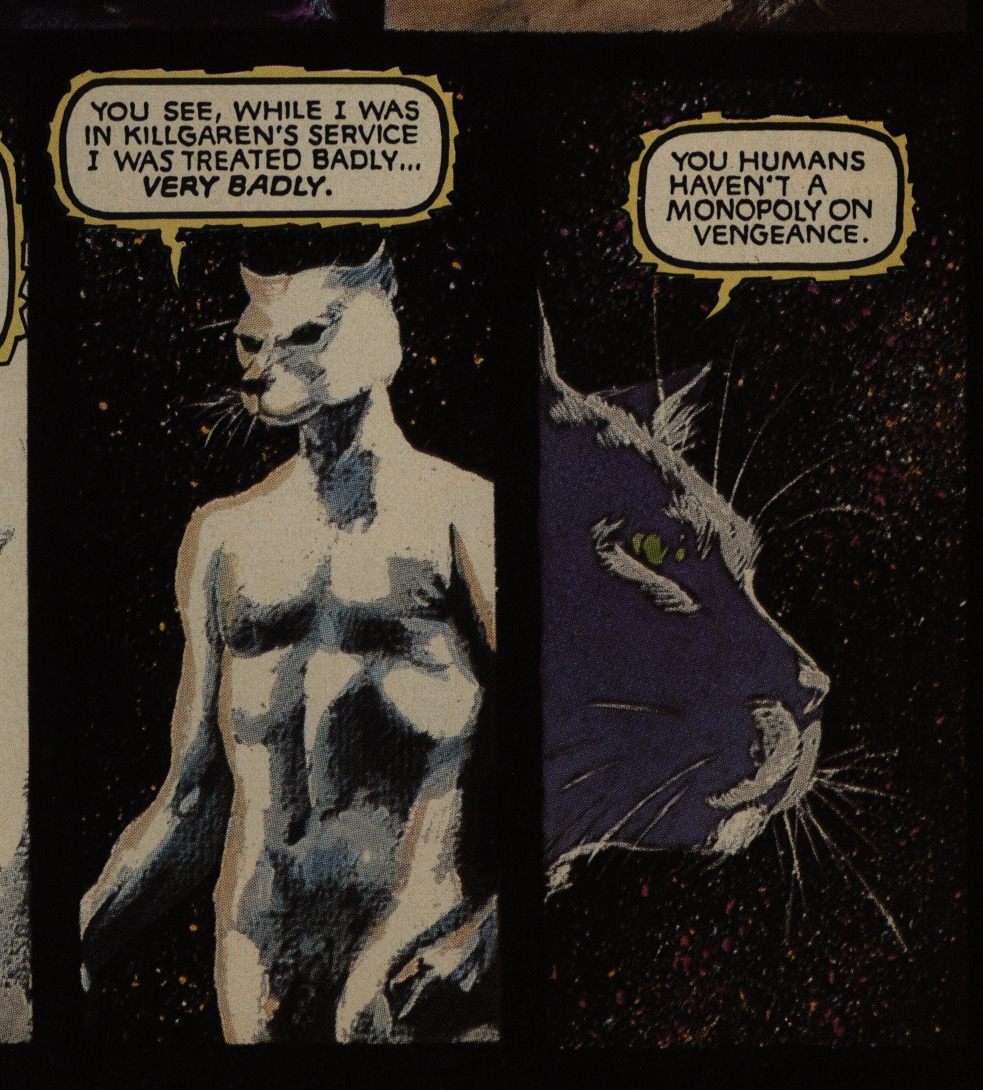
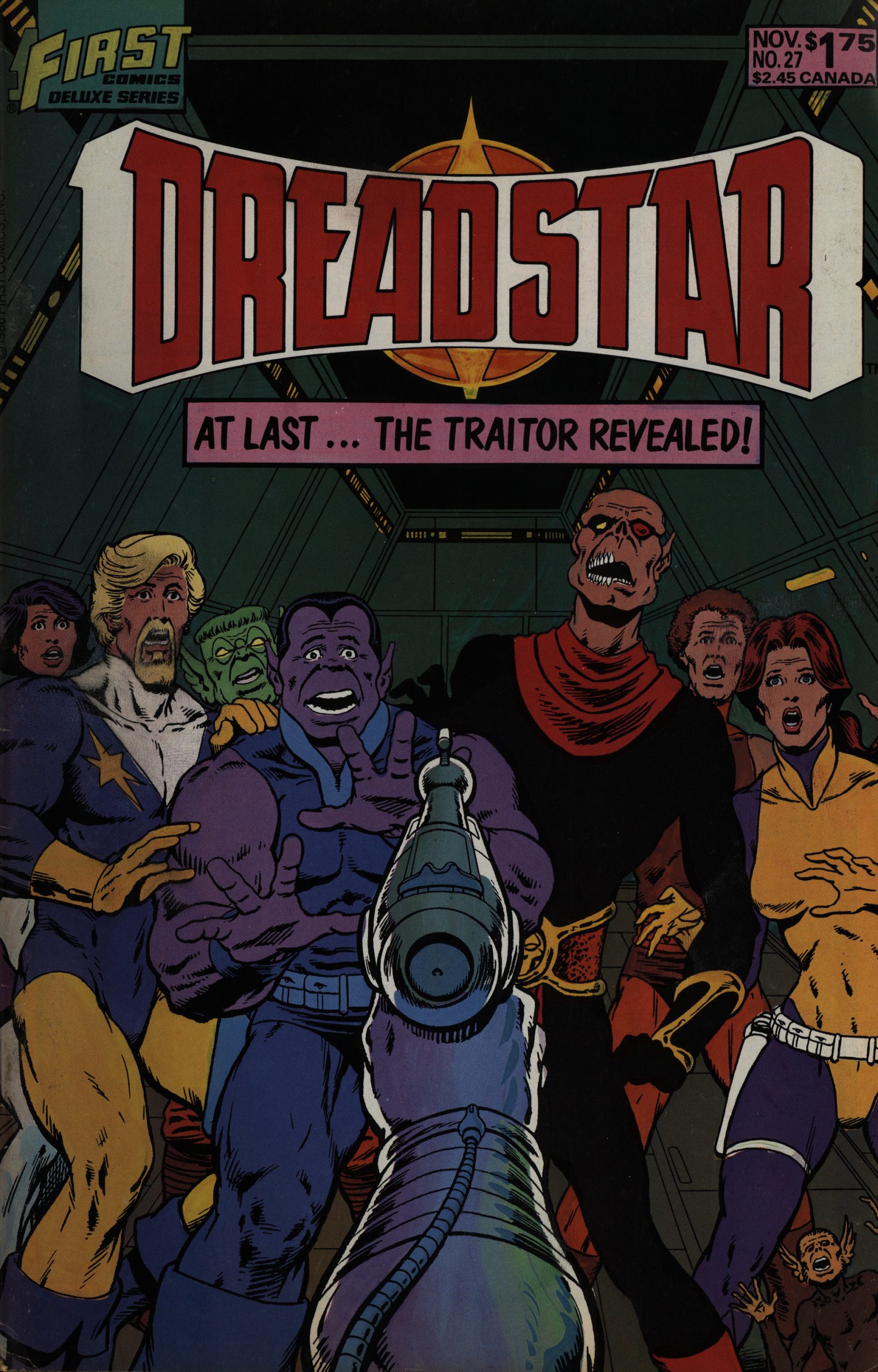
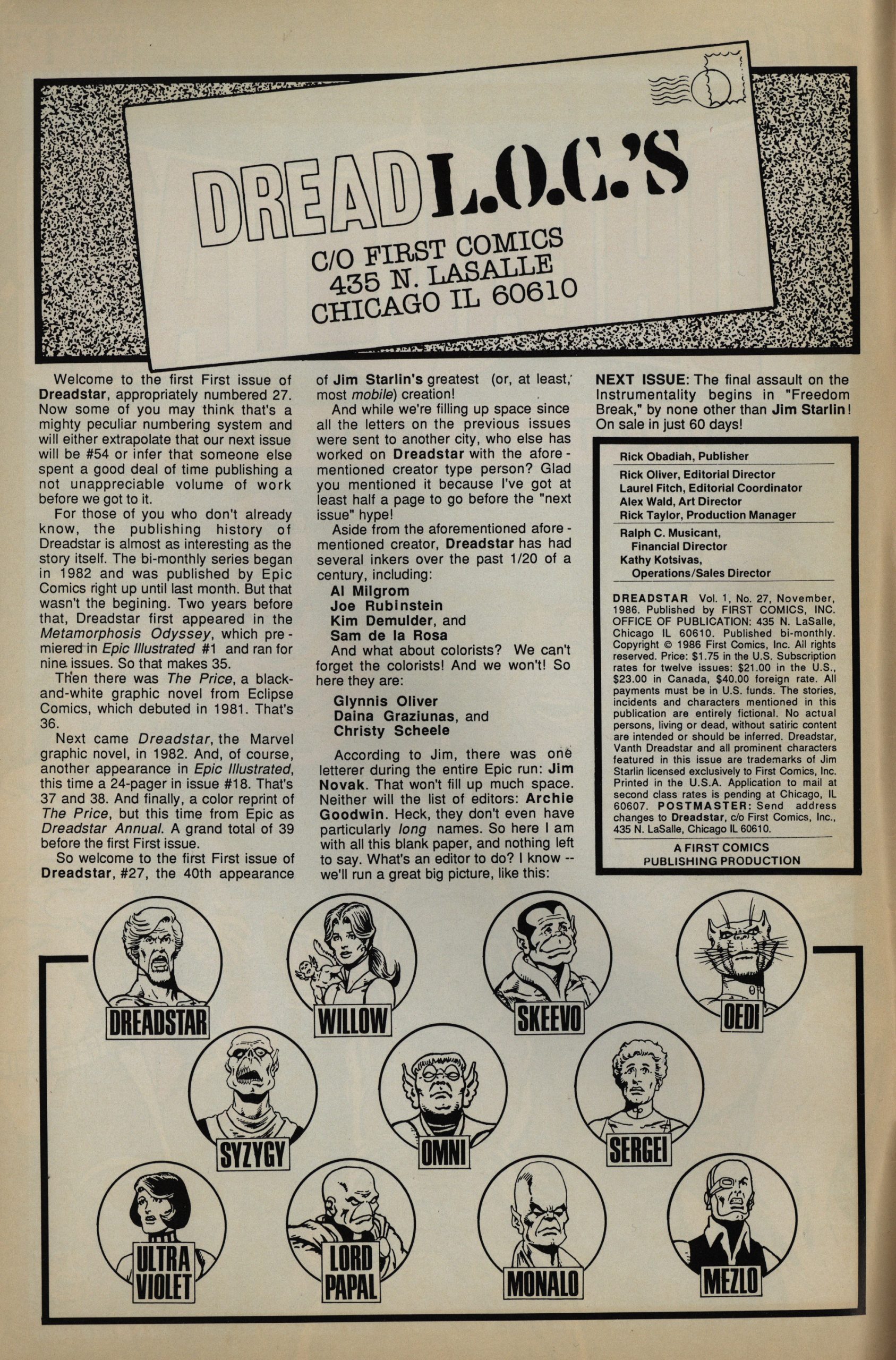
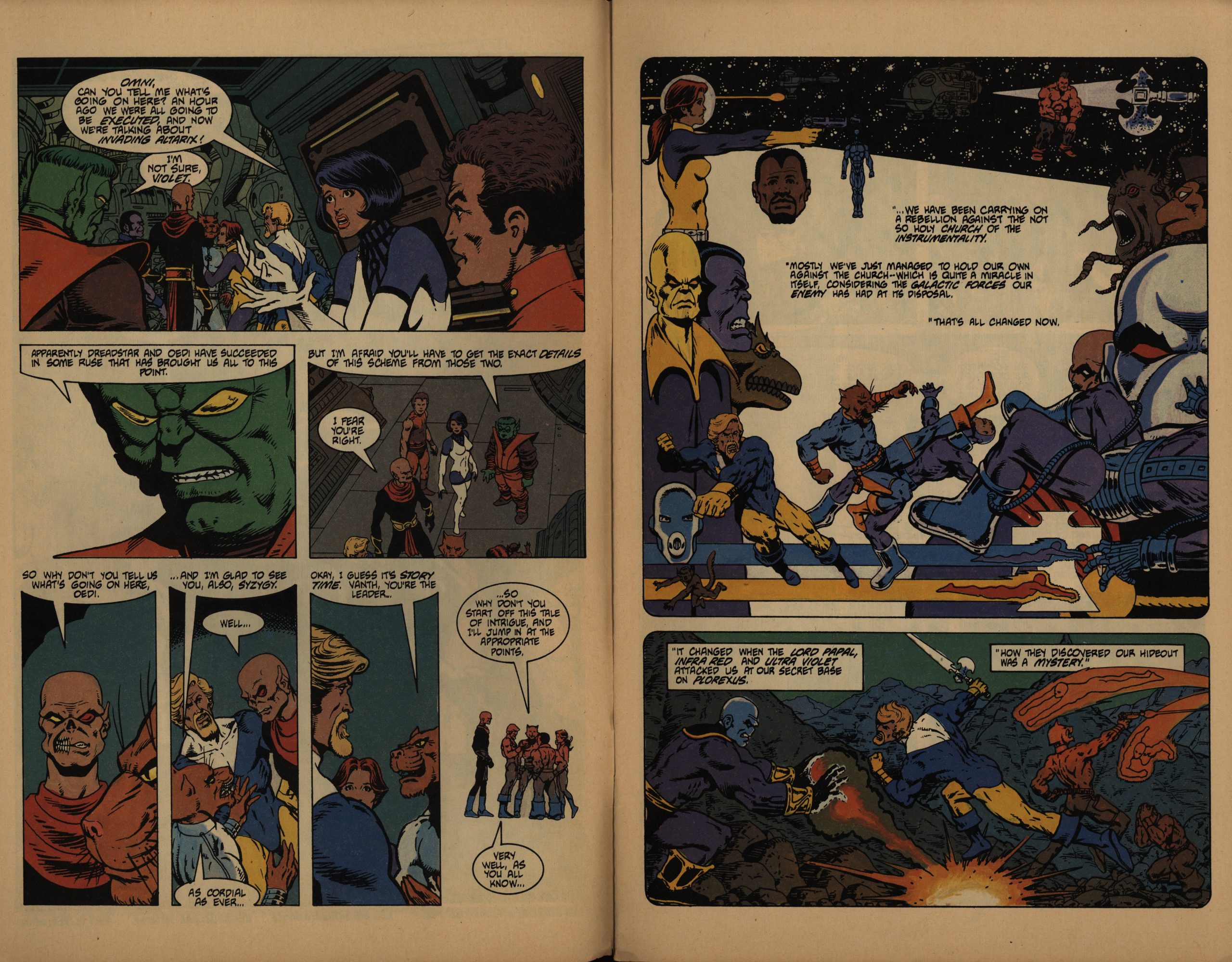
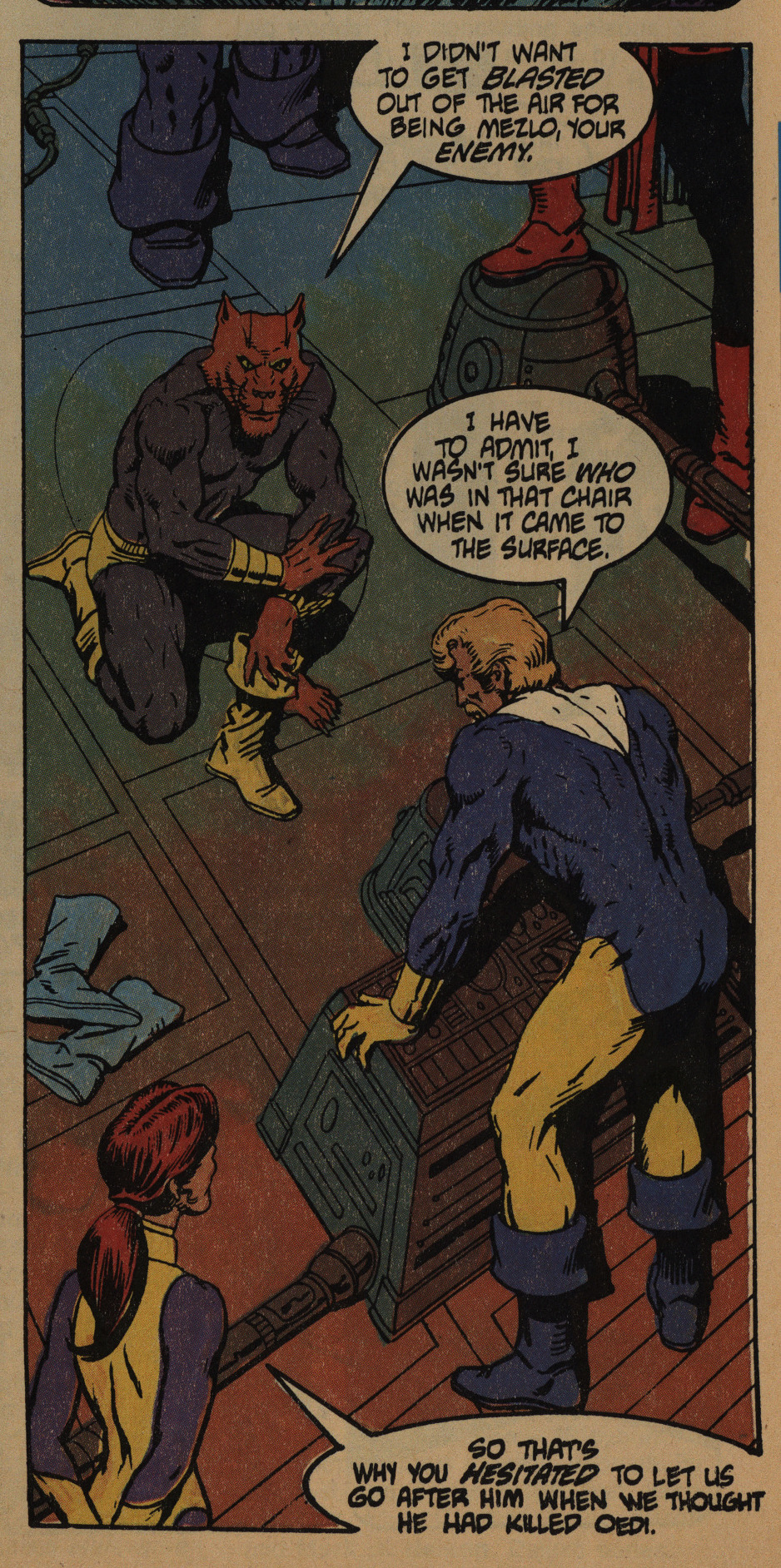
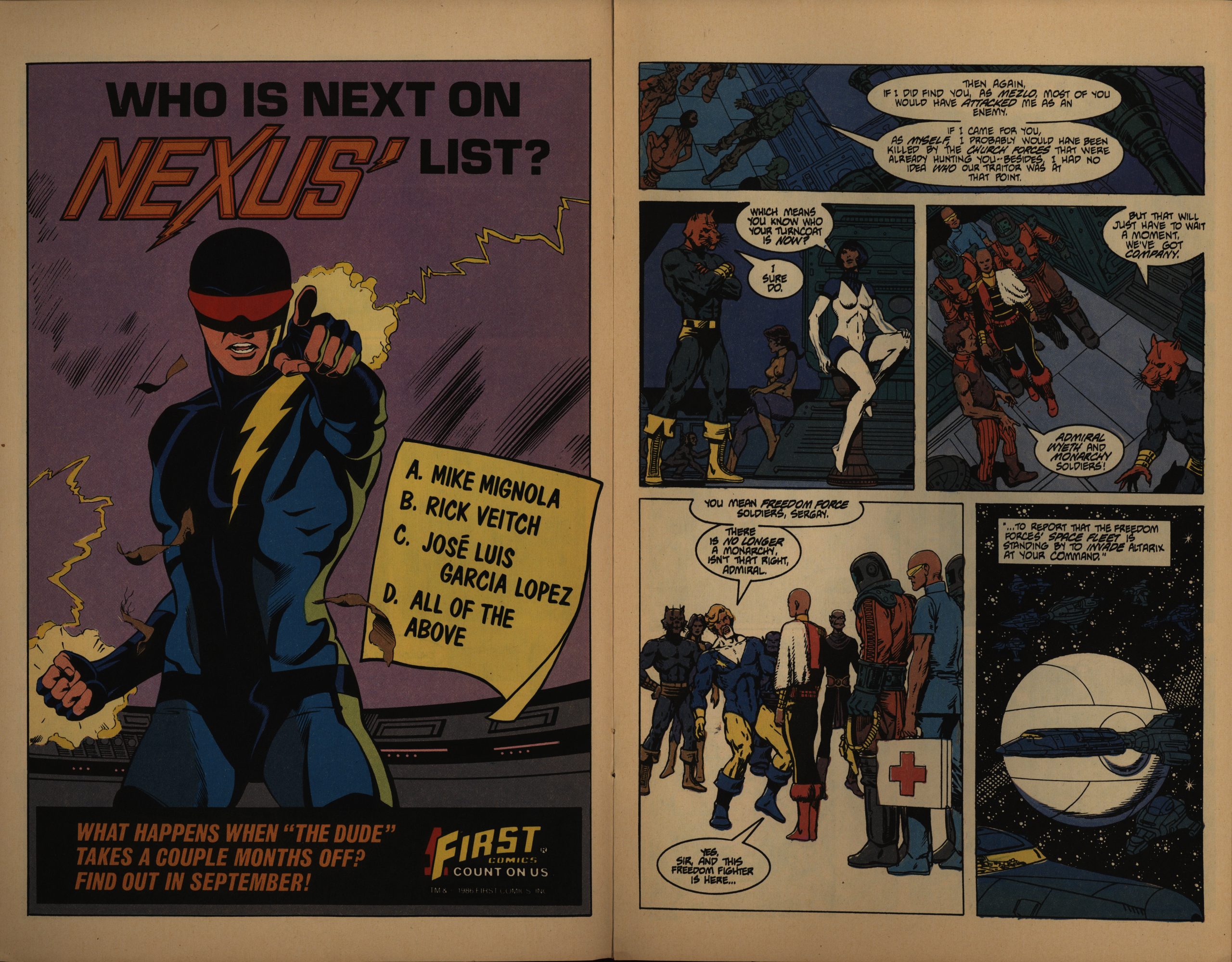
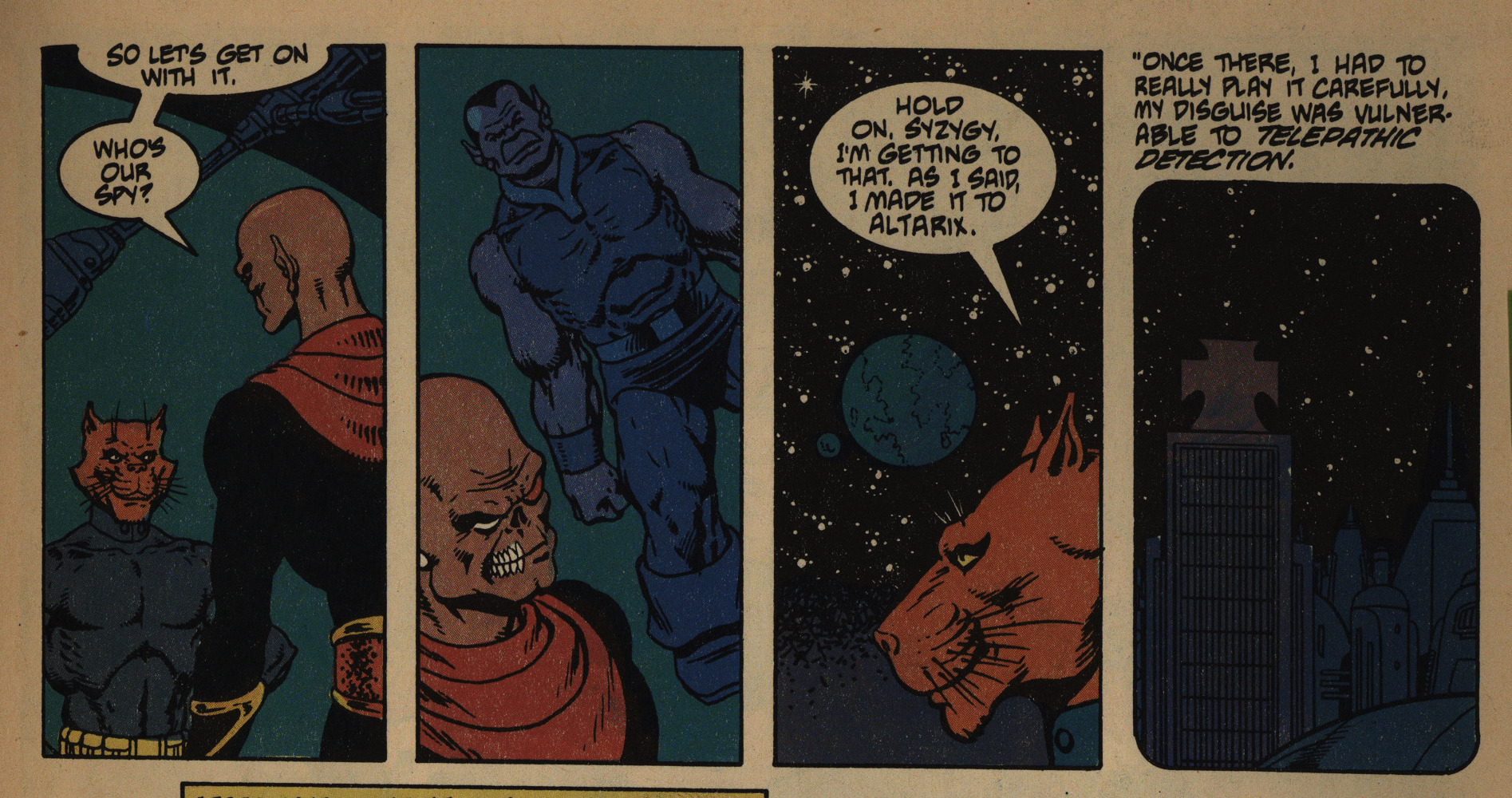
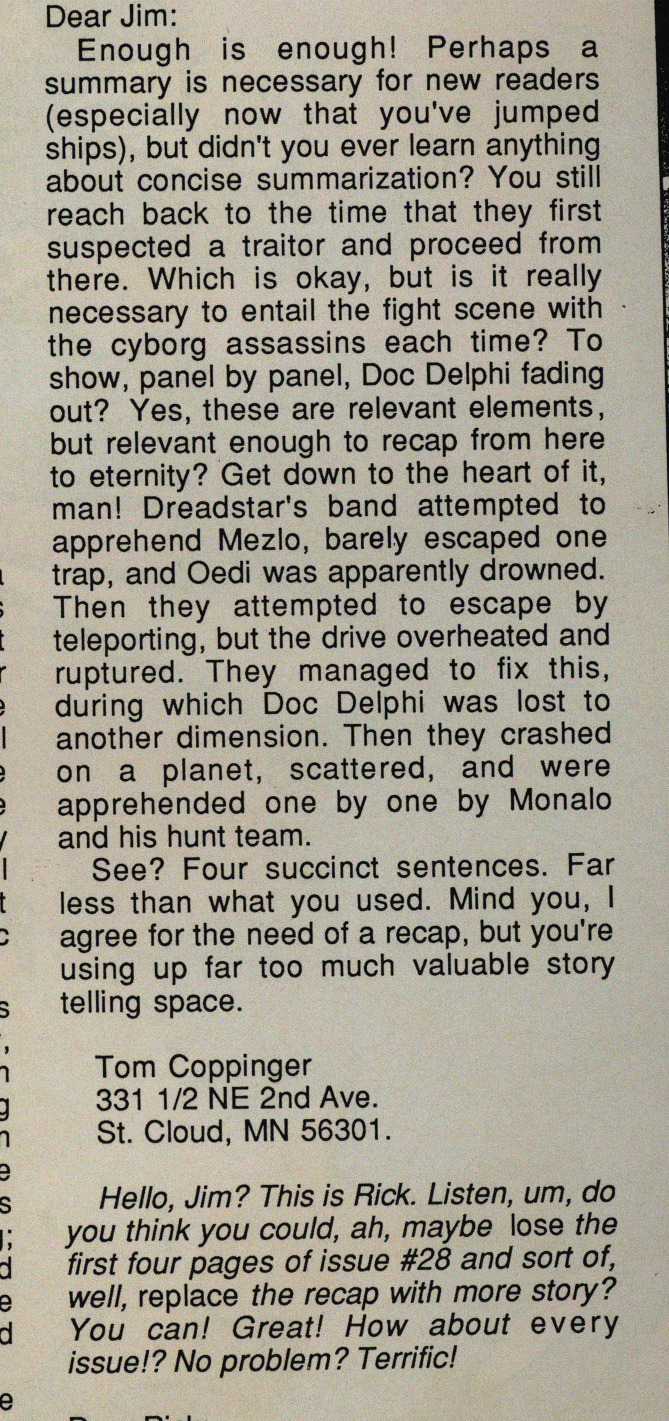
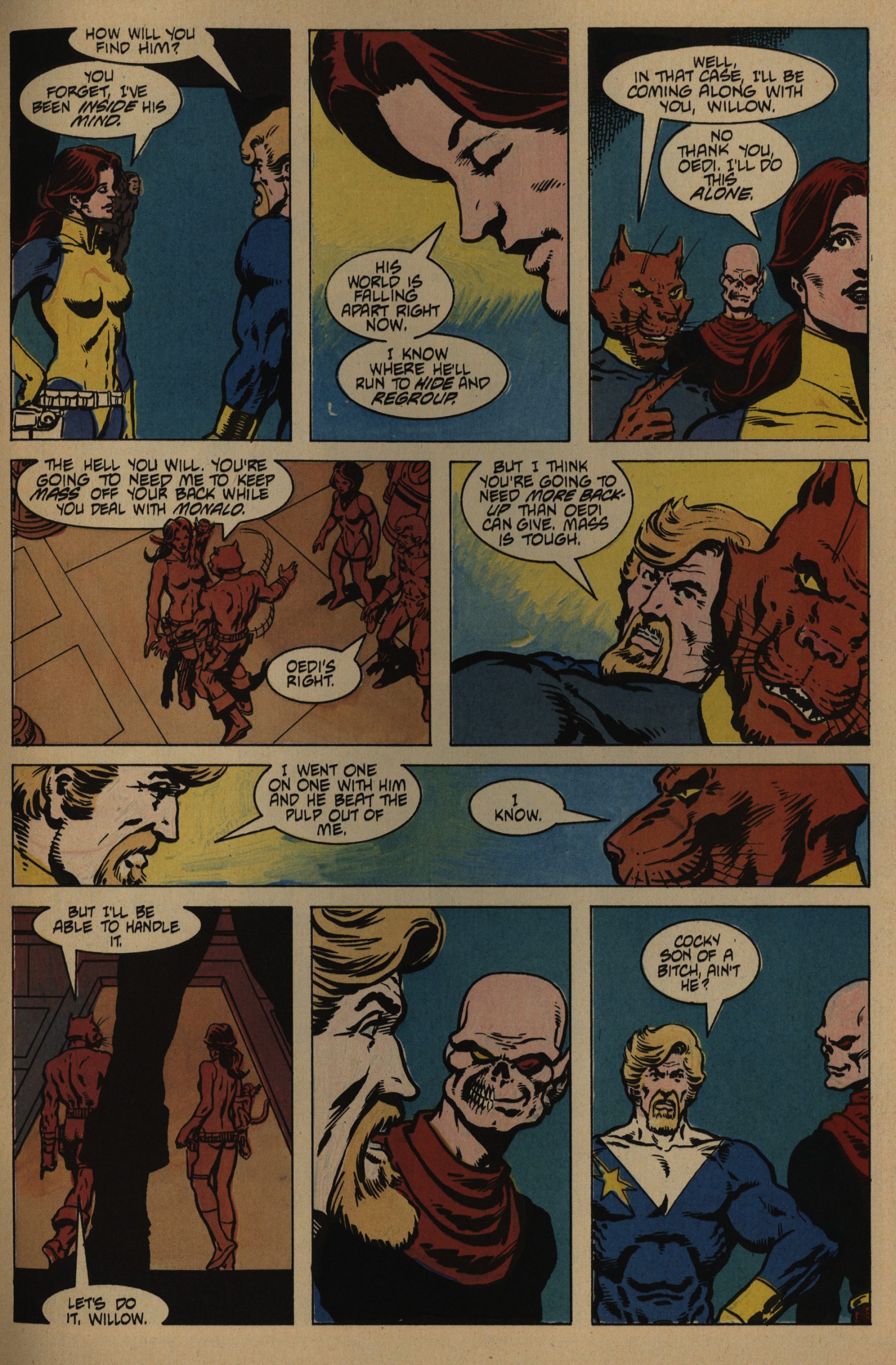
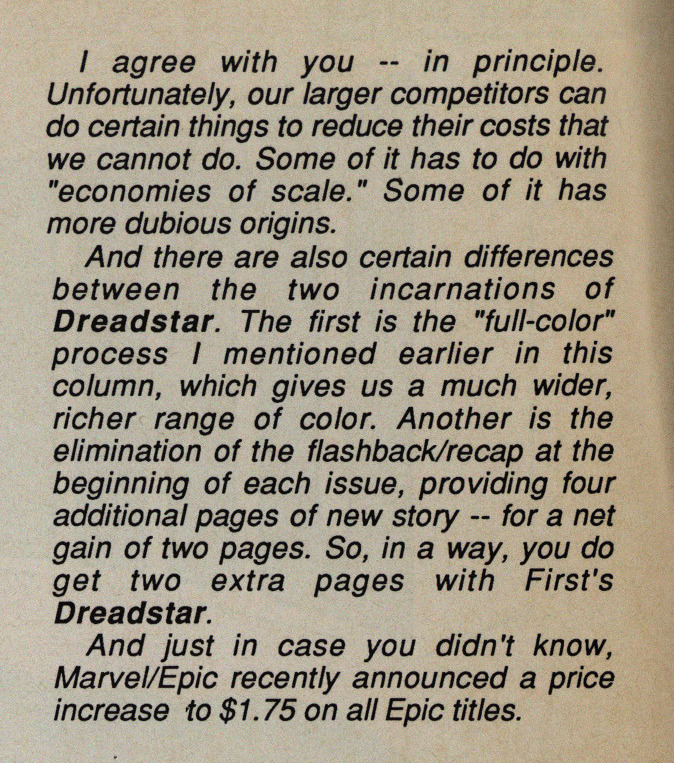
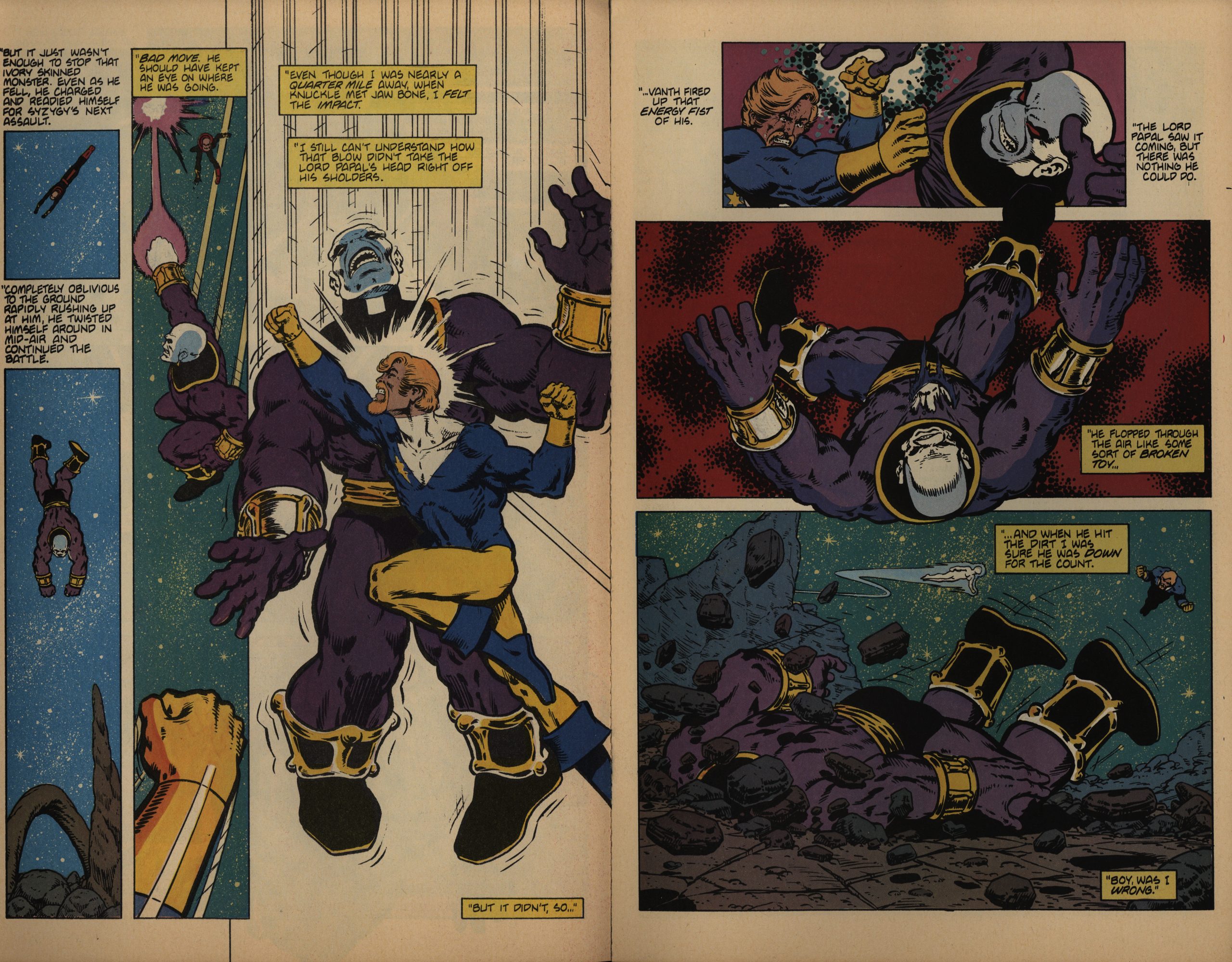
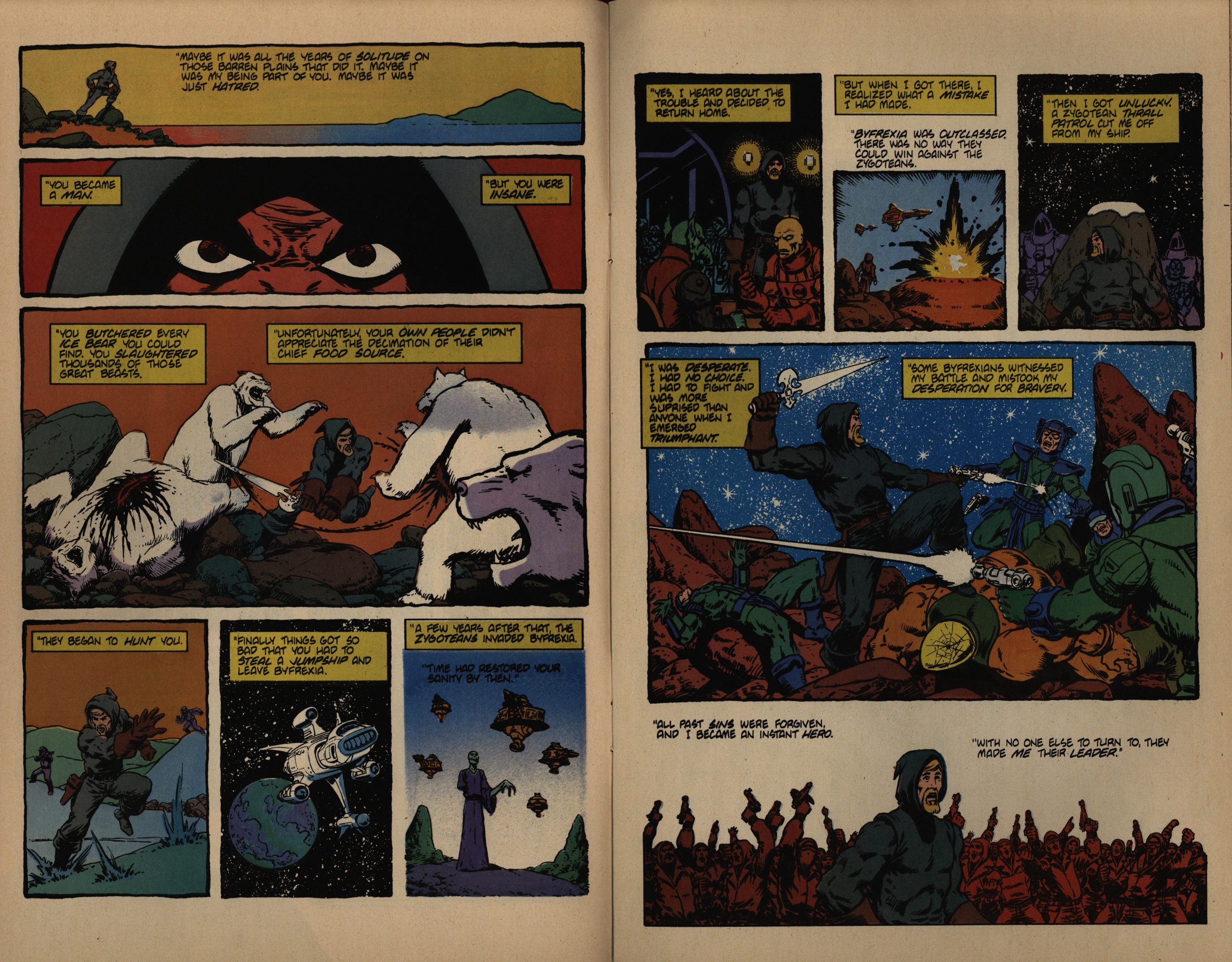
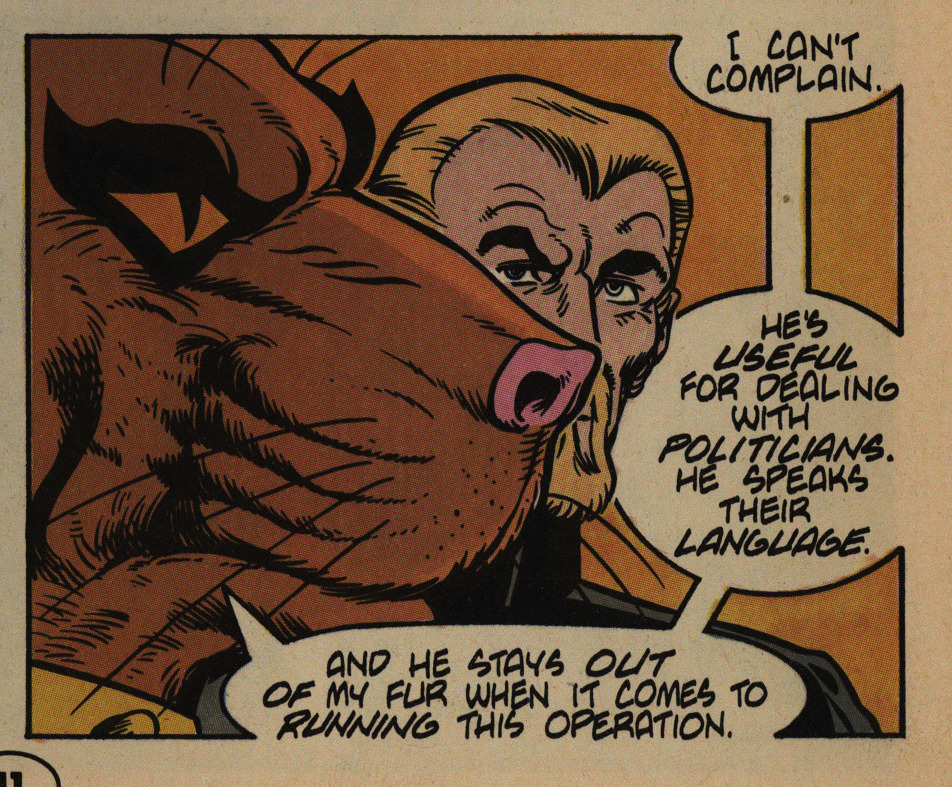
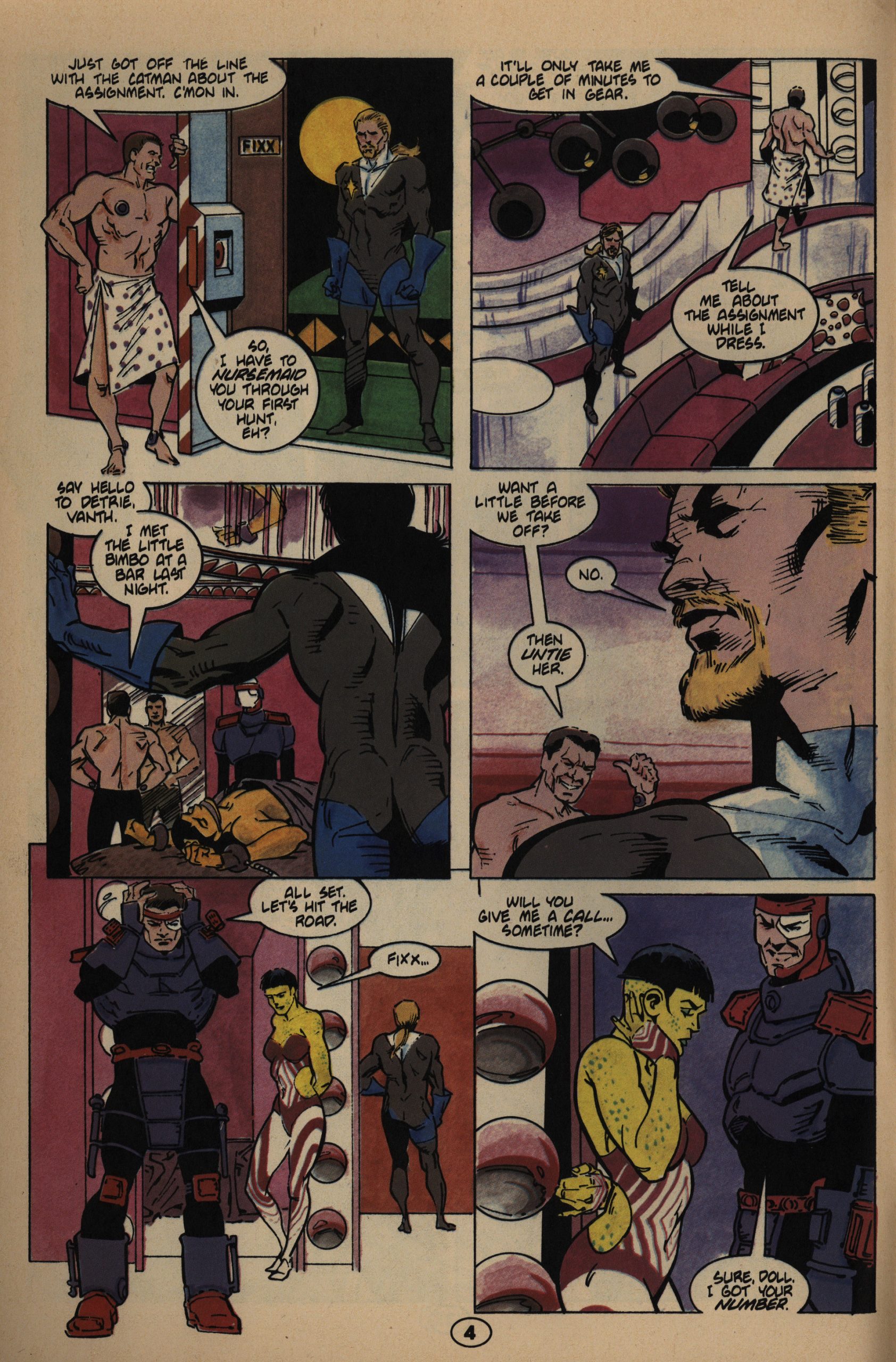
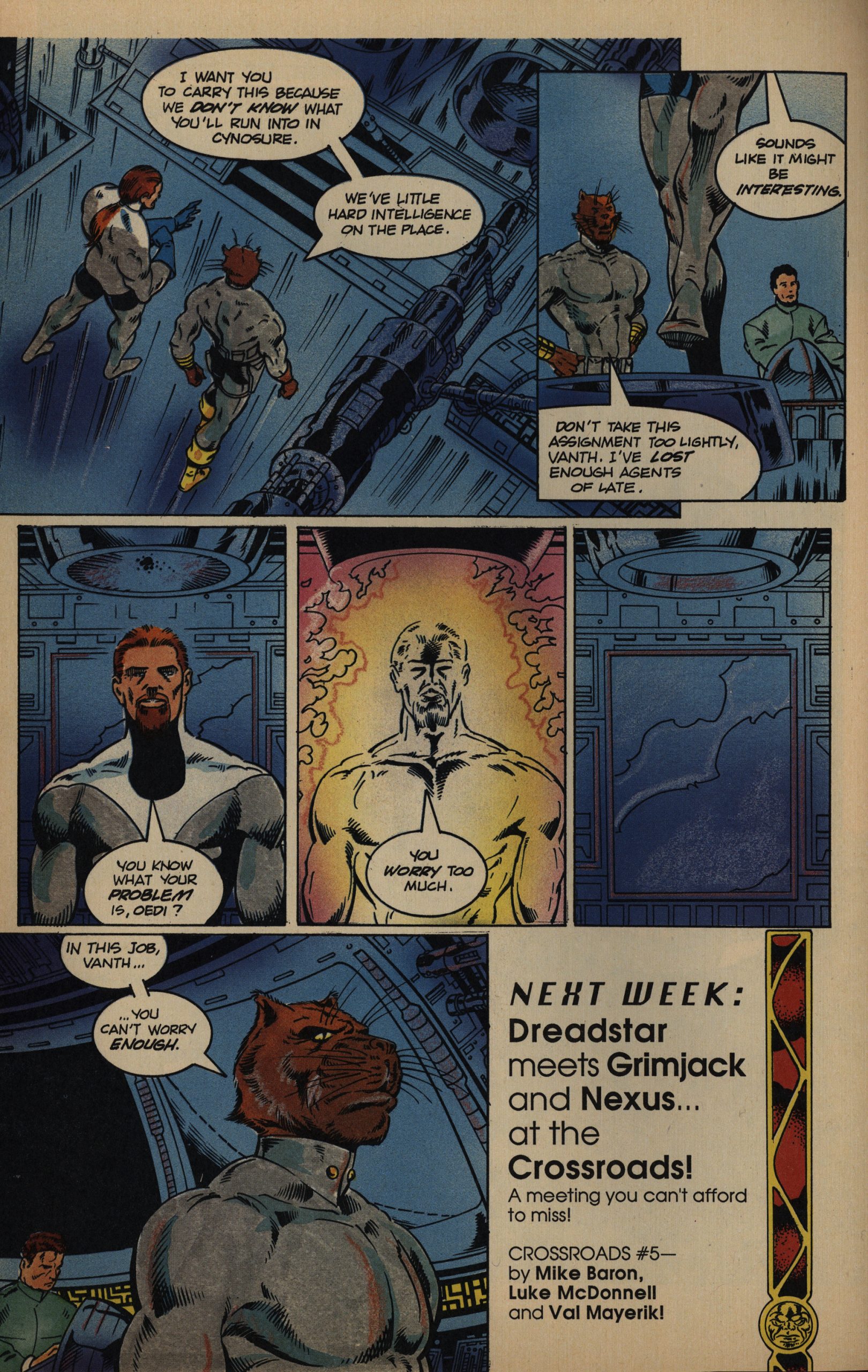
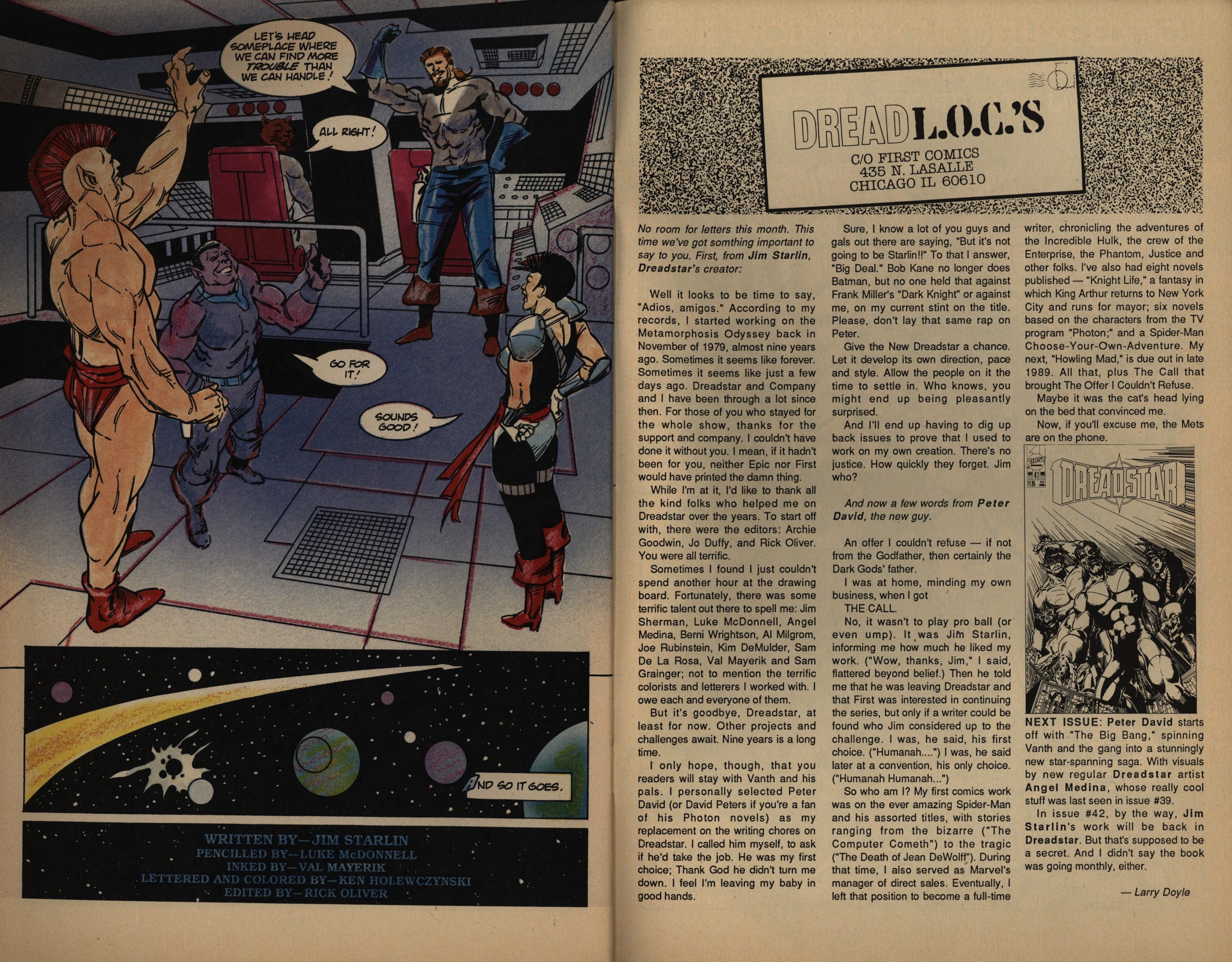
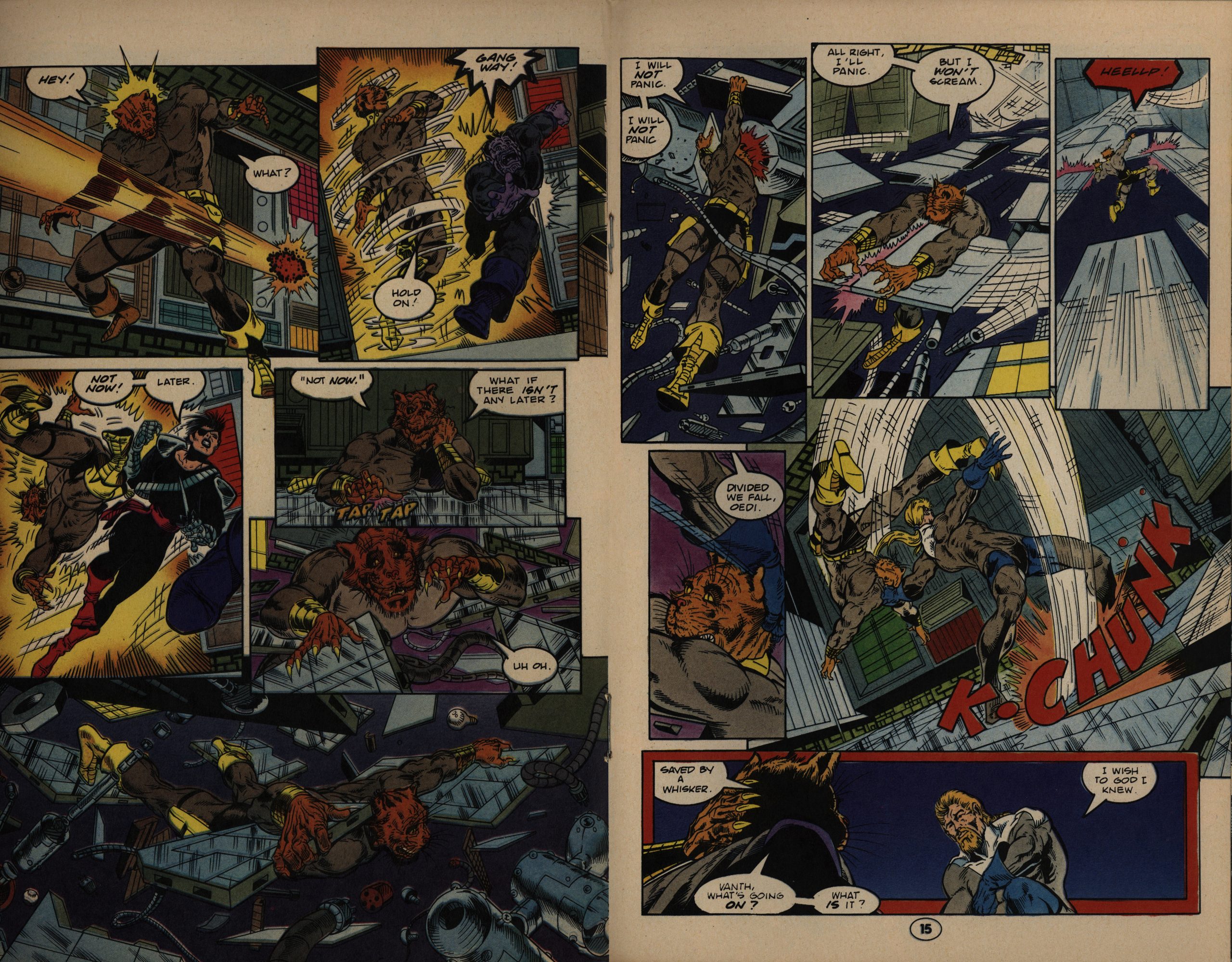
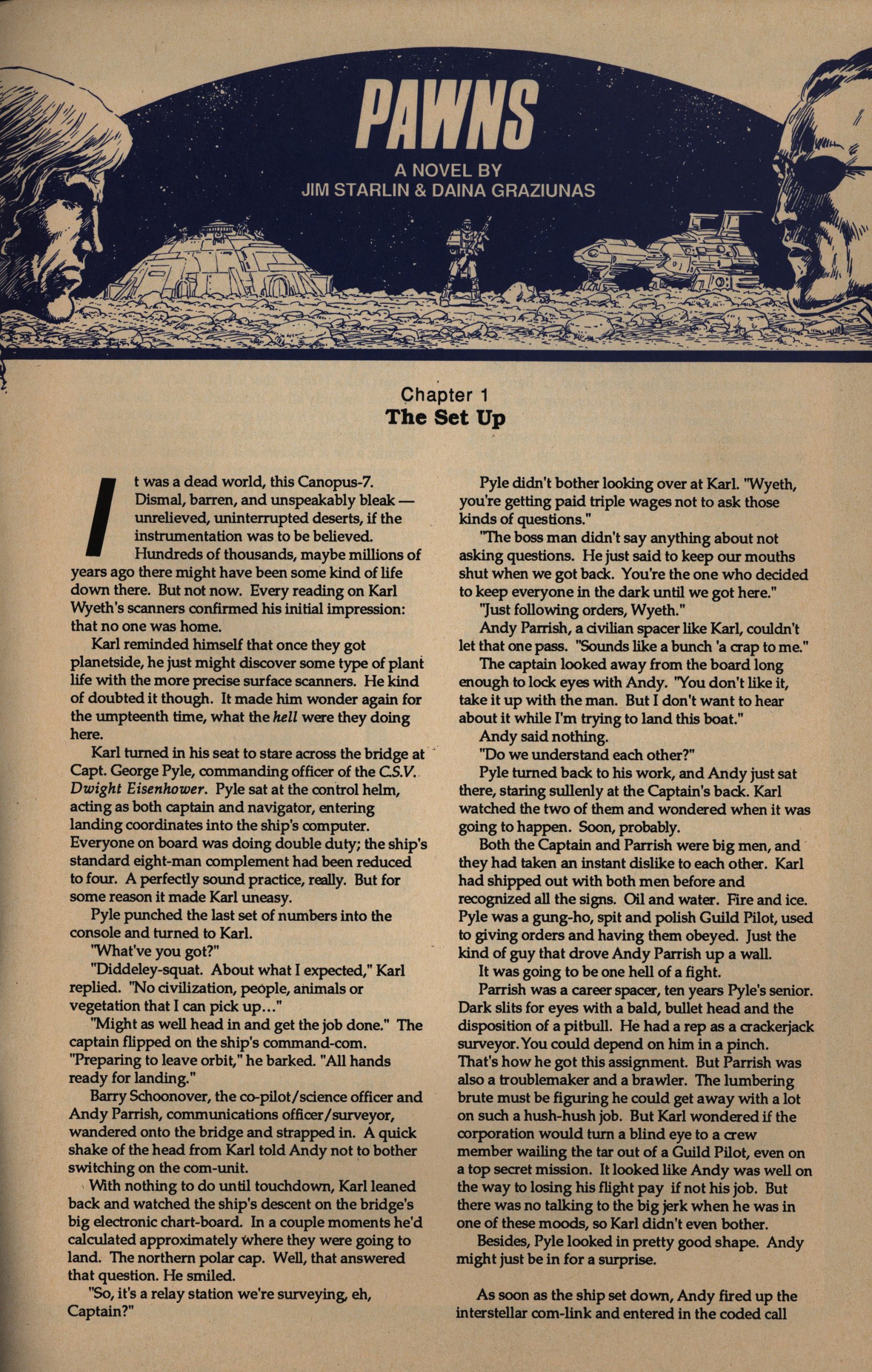
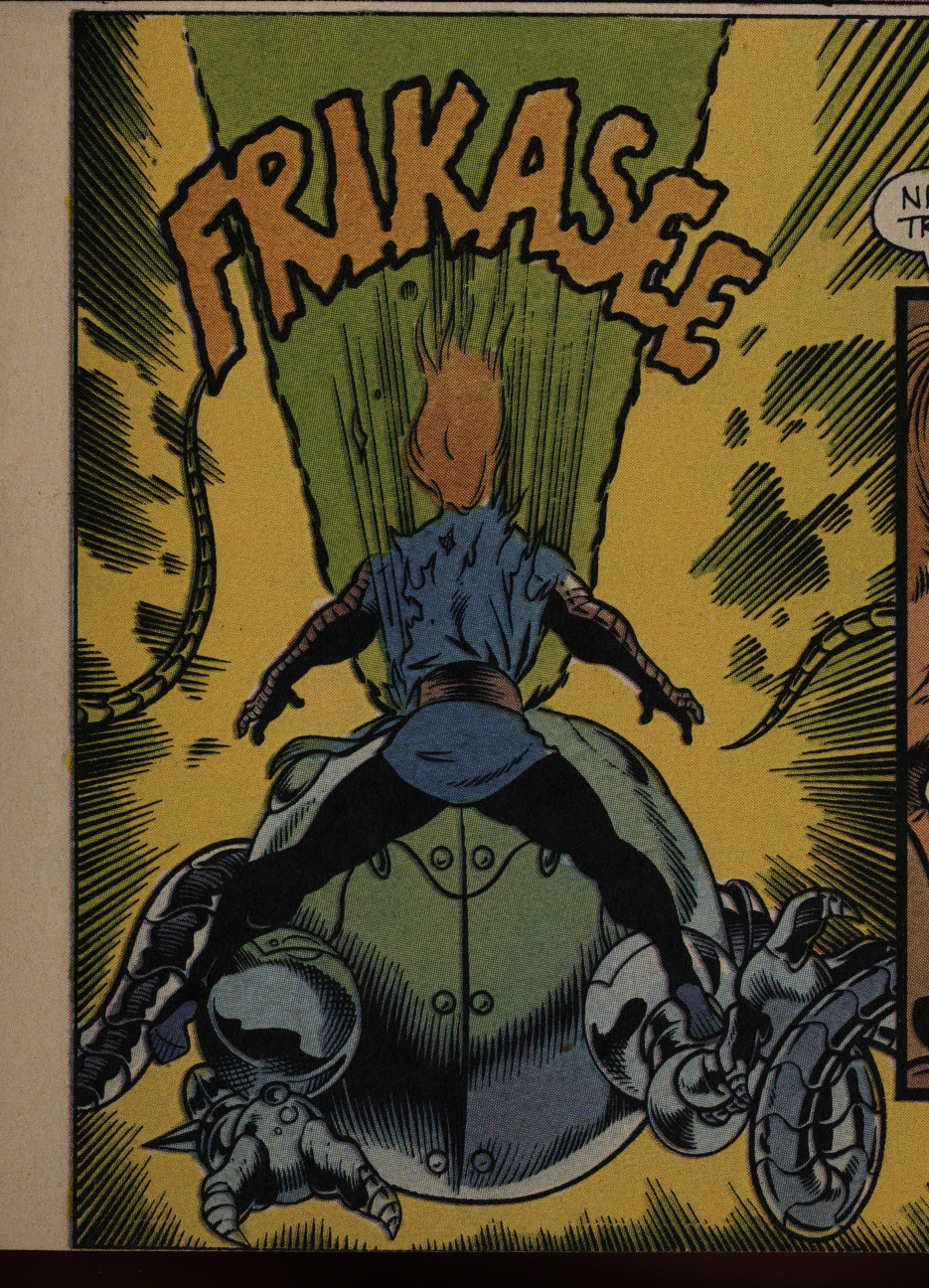
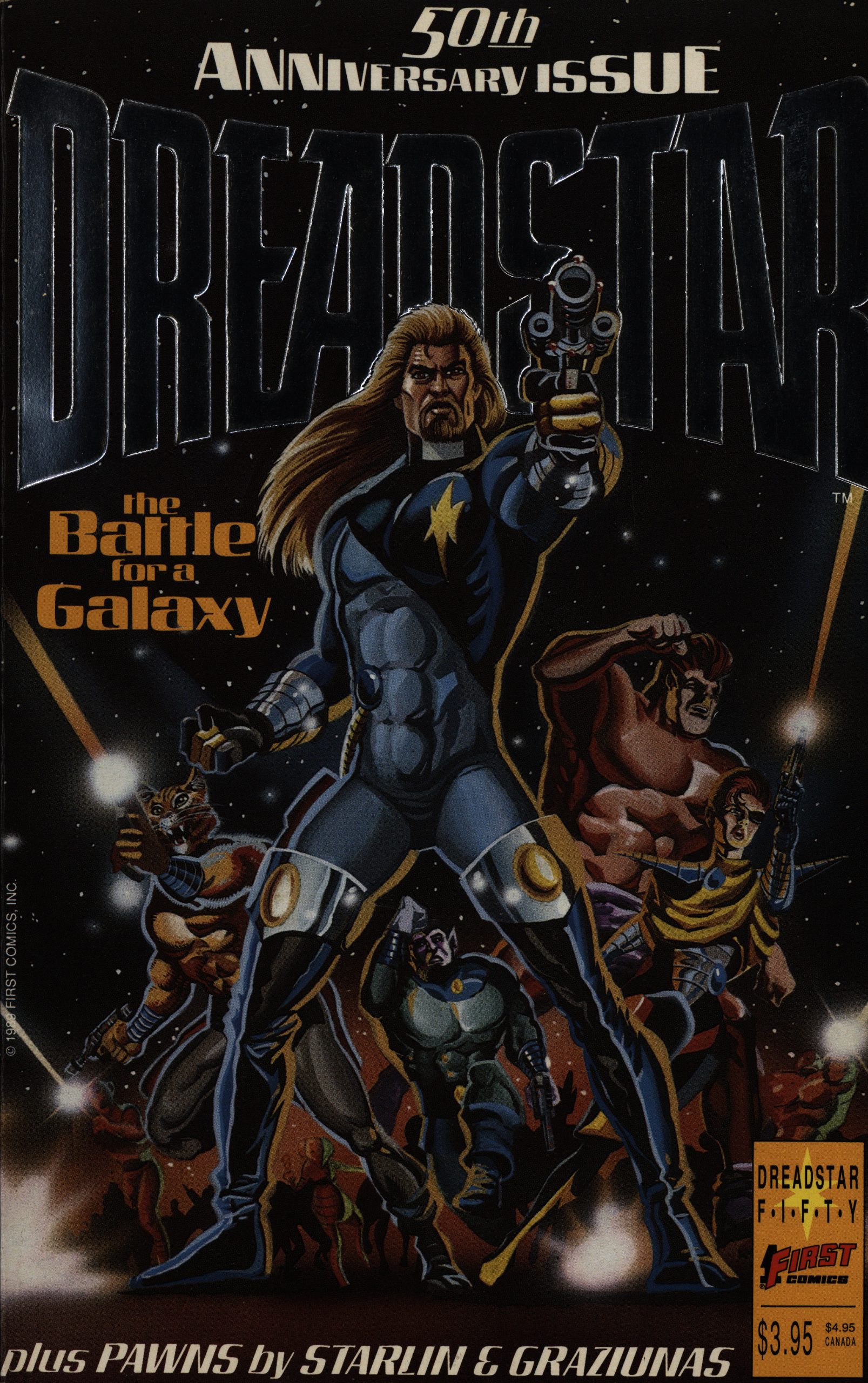
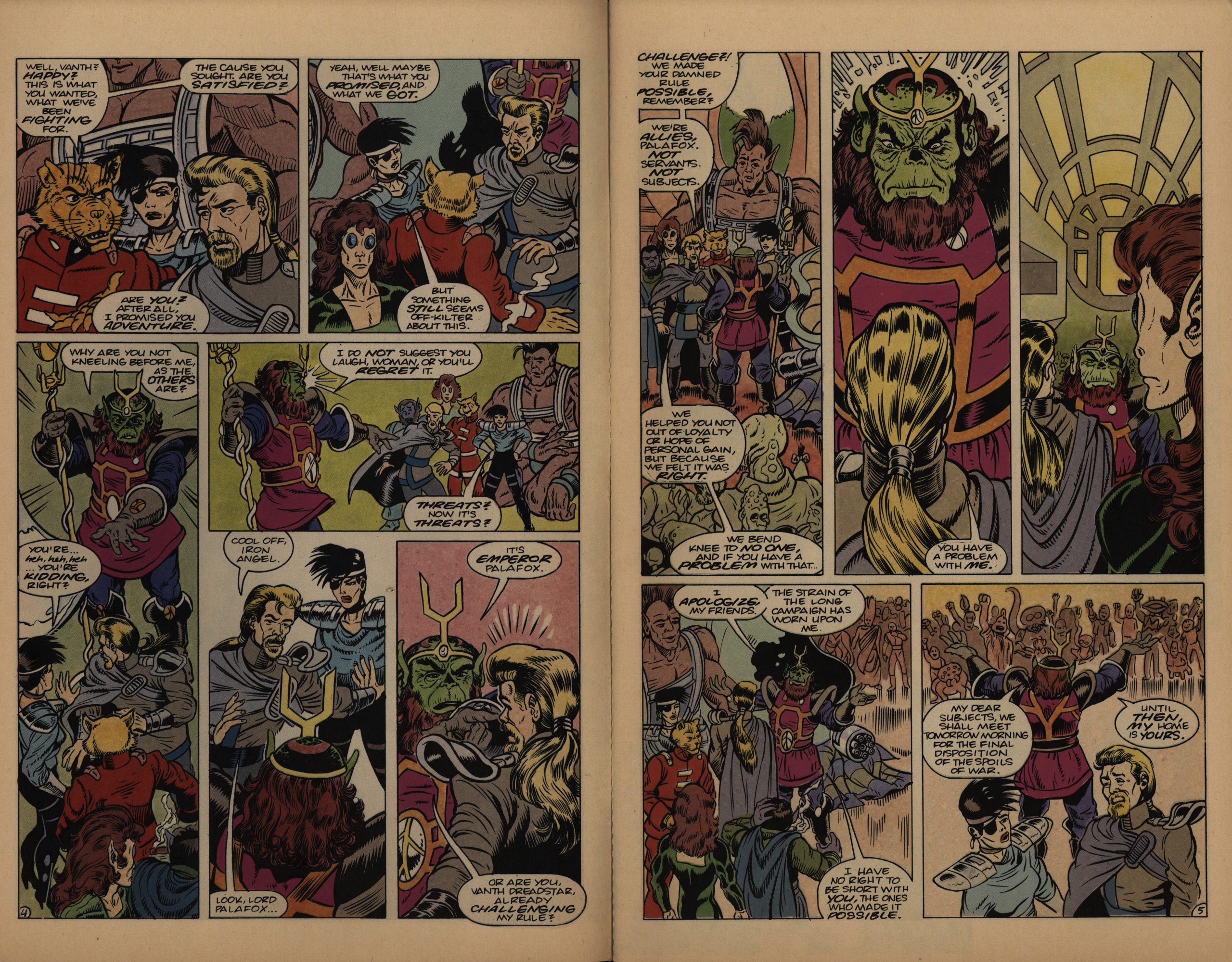
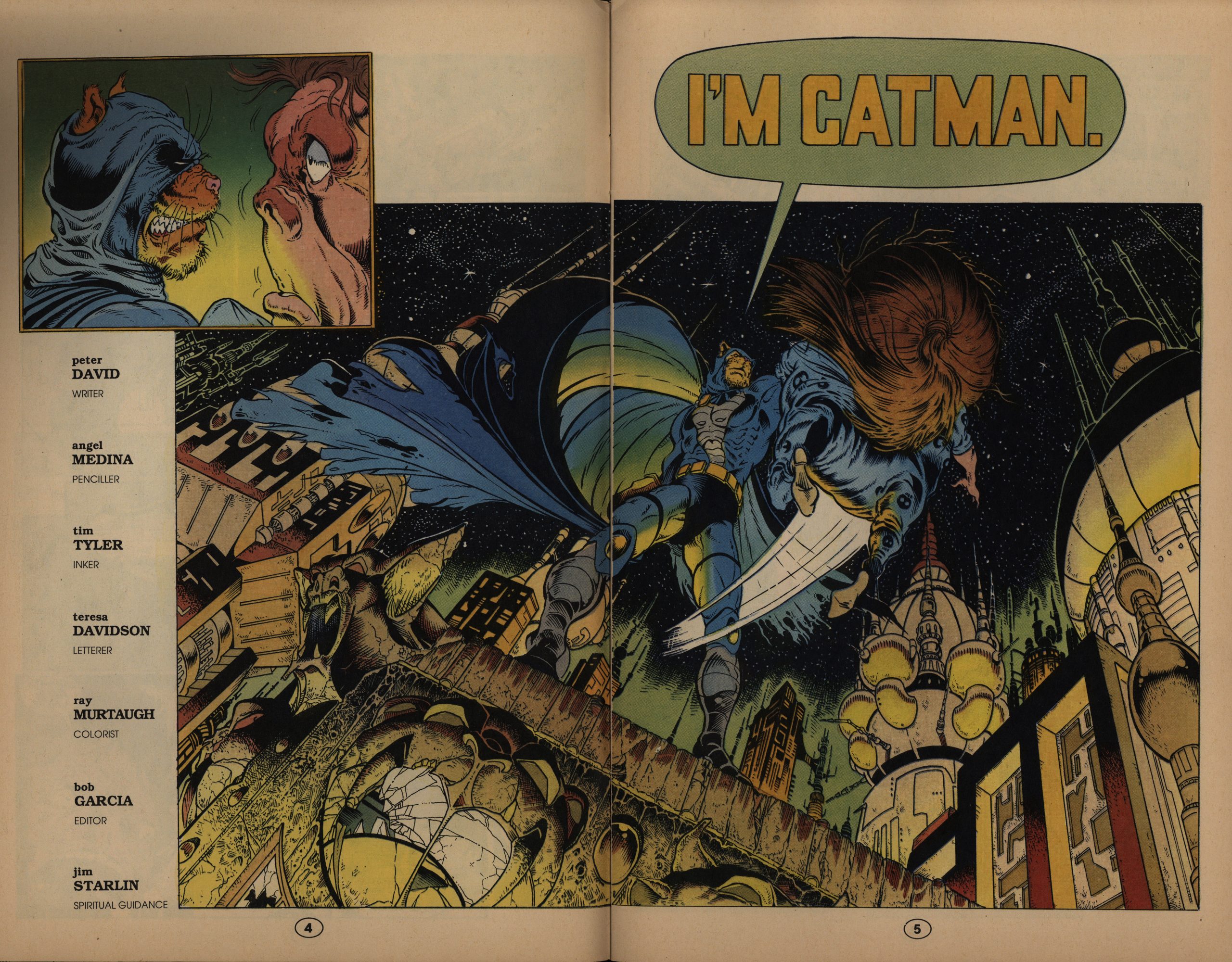
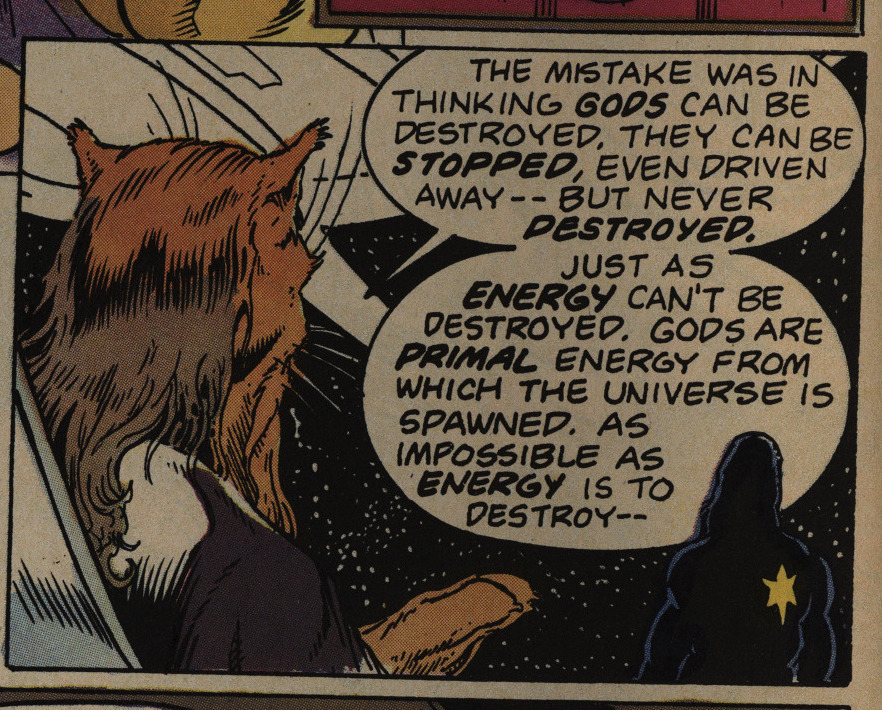
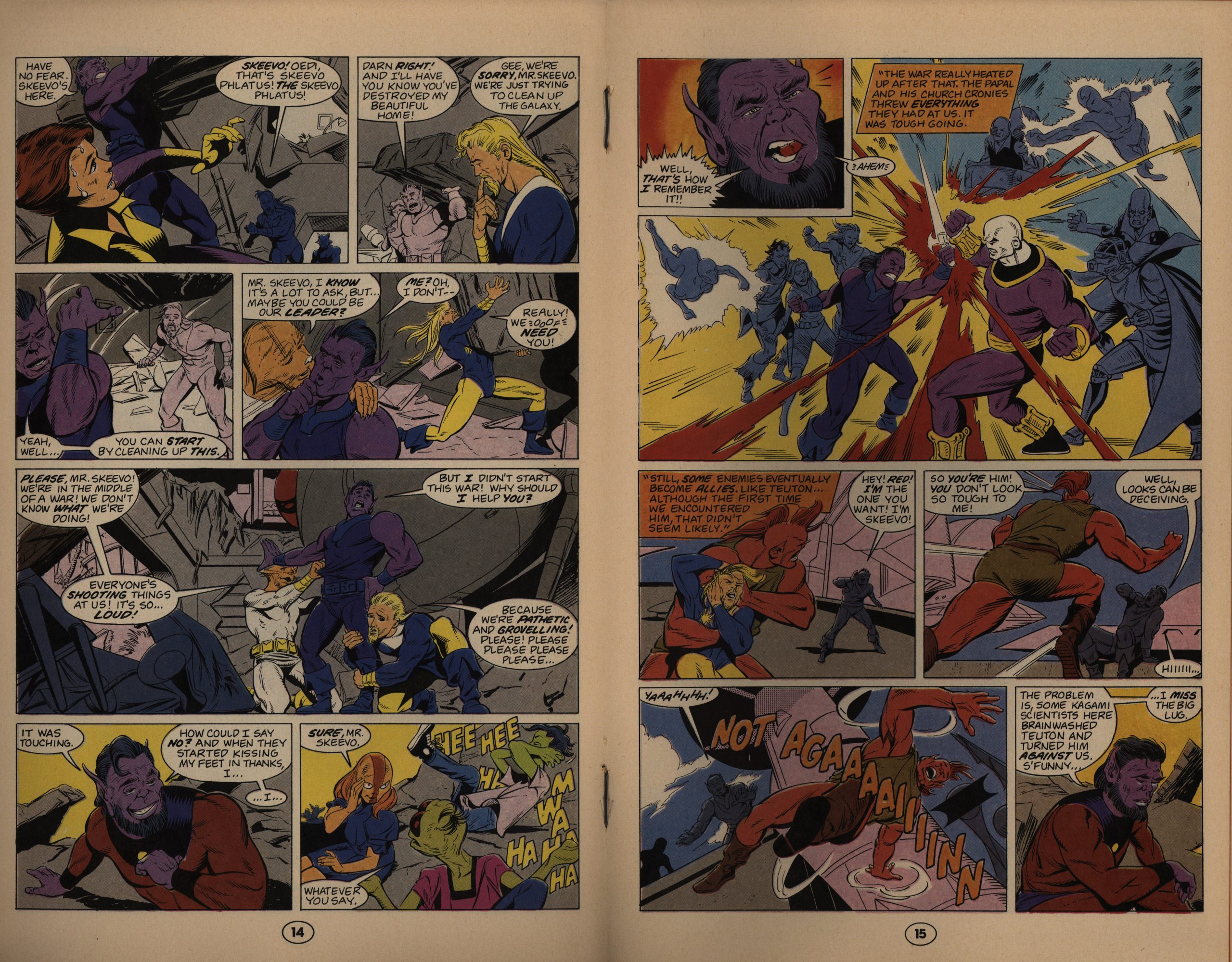
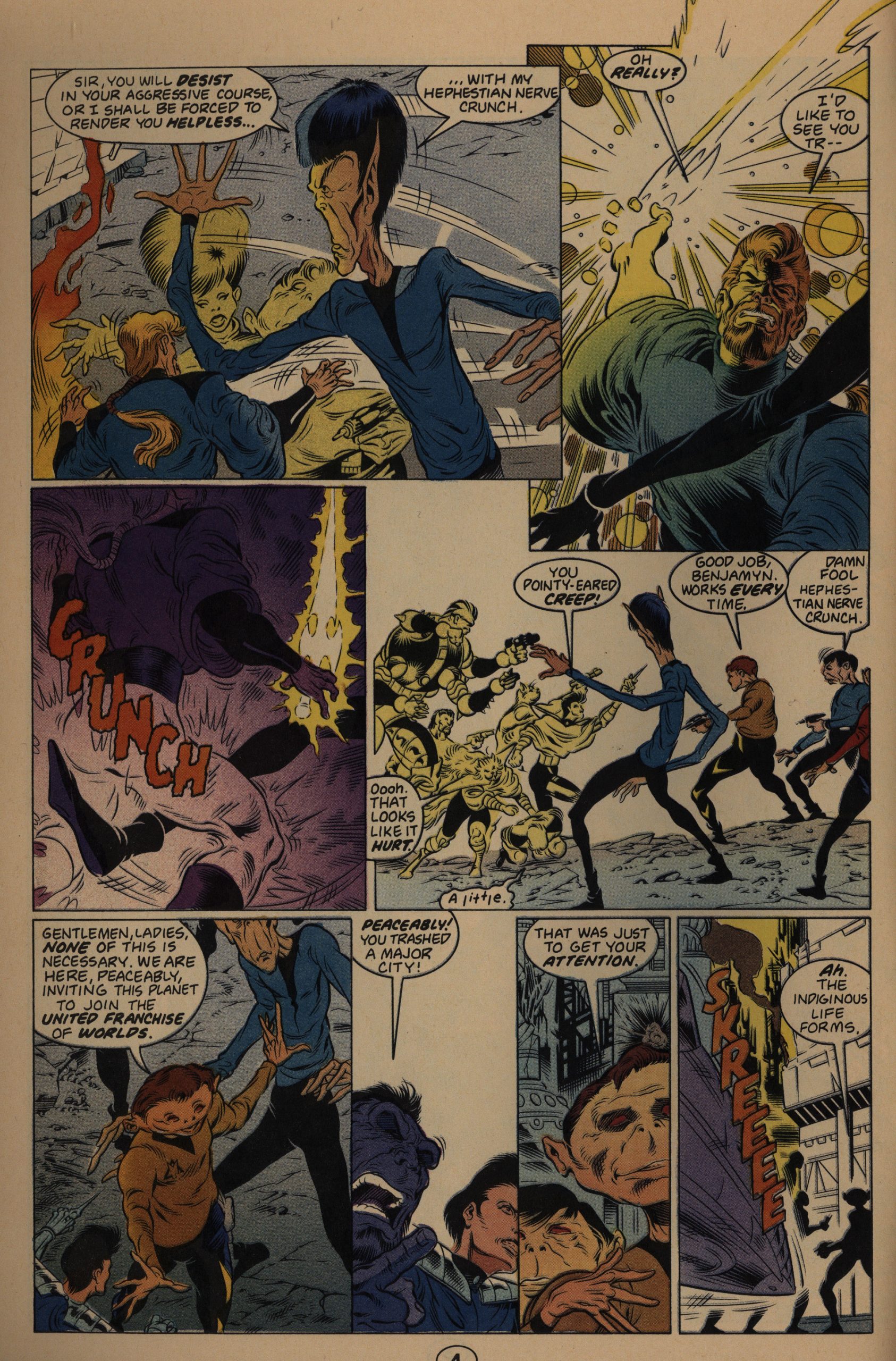
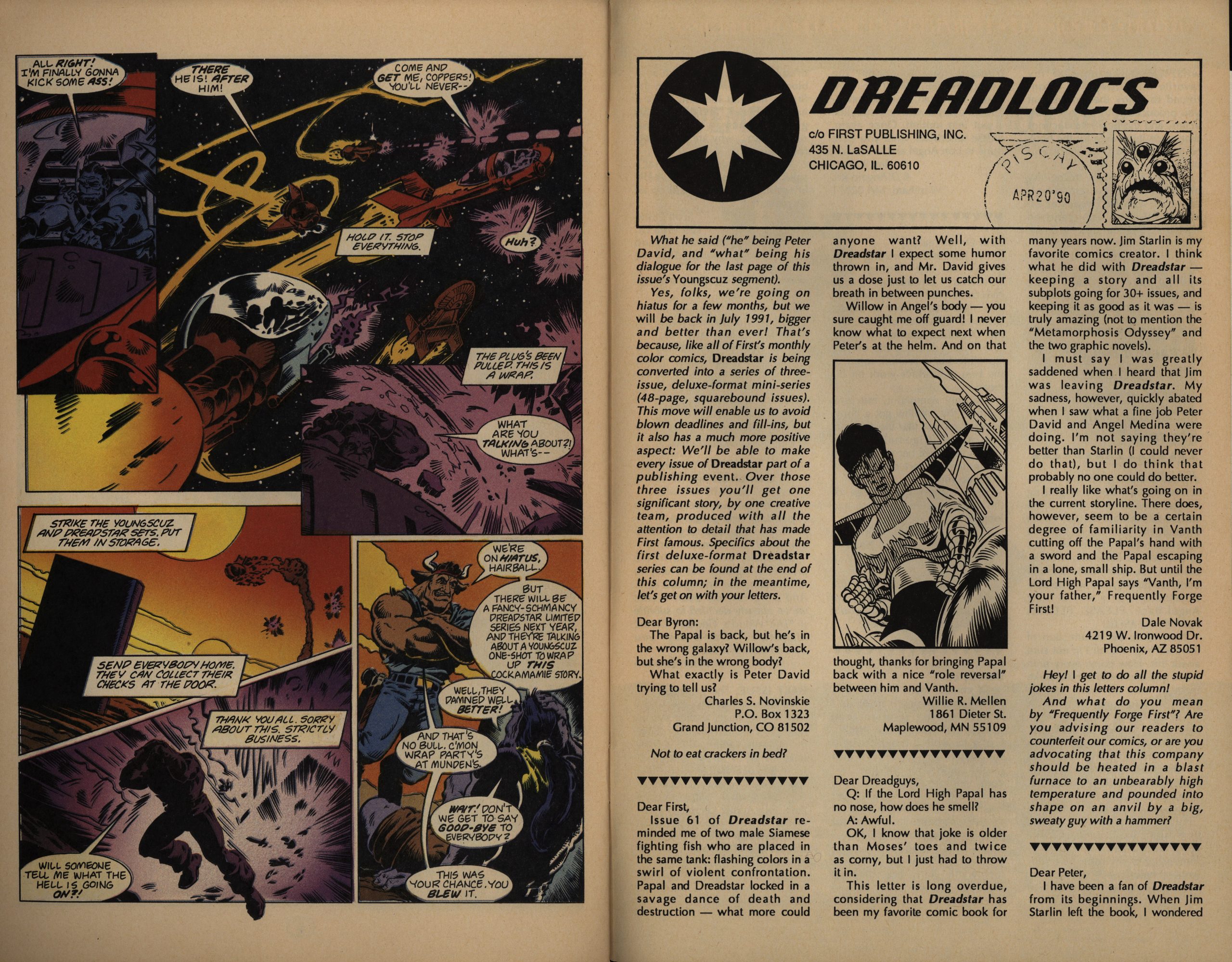
One thought on “1982: Dreadstar”